It seems we can’t find what you’re looking for. Perhaps searching can help.
Sign Up for newsletter!
Subscribe to get the latest eBook!
Hotline






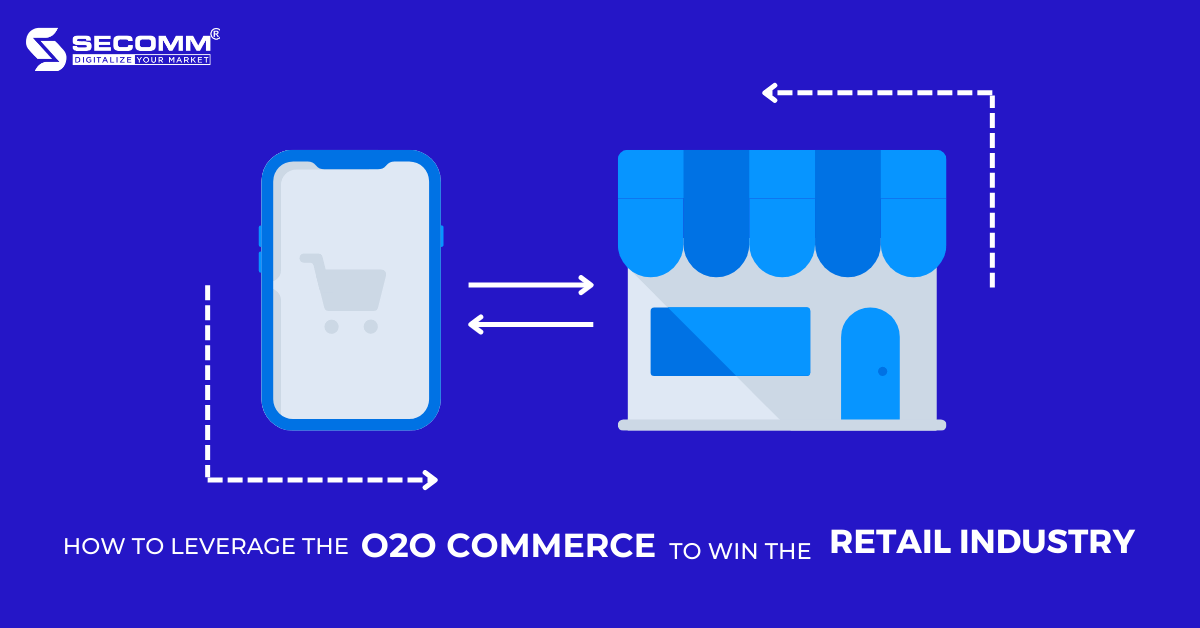
Retails has miraculously recovered from the global pandemic and is expected to make a breakthrough in the years ahead. One of the ways to embrace eCommerce is the O2O model, which combines online and offline operations.
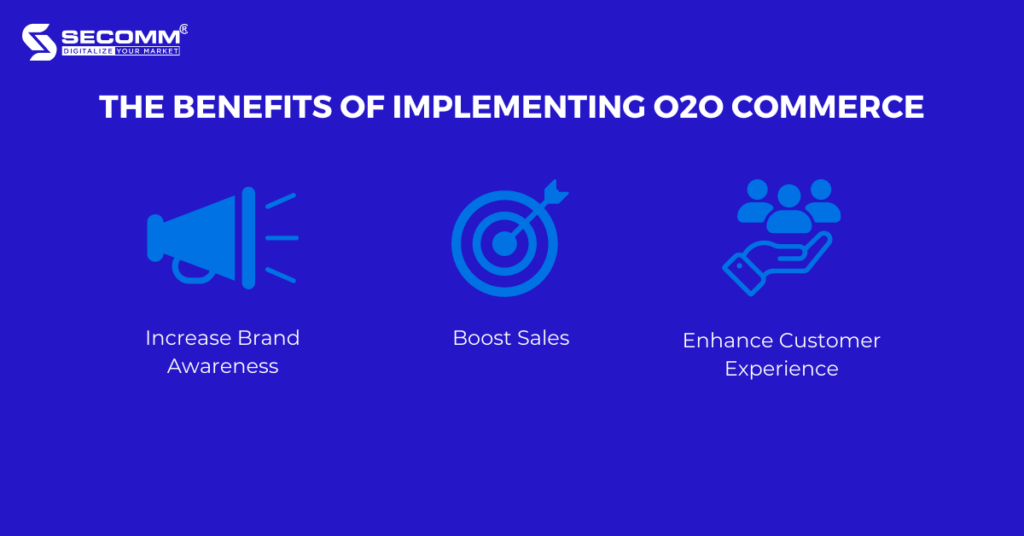
One of the big challenges of physical stores is how to raise brand awareness among potential customers who are far from the store location. Using online-to-offline marketing strategies can increase the public’s awareness of a business’s brand. That way, businesses will be able to reach an influx of customers and boost their awareness of the brand and its products which then lead to higher sales volume and massive revenue.
Despite the rapid development of eCommerce, brick-and-mortar stores still maintain stable sales because many customers still prioritize visiting stores to shop. A recent study indicates 46% of responders said they preferred shopping at a brick-and-mortar store because they want to touch, feel and try the products physically before making purchases. Another interesting fact is customers are likely to spend more money while in the store.
For example, a man comes to a bookstore to buy a notebook, then he looks around and decides to buy some more pens. In case he buys the notebook online, he may only buy it. Thus, the O2O Commerce model is a good choice as businesses can not only use online channels to raise brand awareness but also overcome the limitations of offline channels to earn massive revenue.
The incredible combination of online and offline channels makes the customer shopping experience more seamless and interesting. Online platforms enable consumers to contact brands easily and immediately. When they want to ask for a product’s details, they can send a message through Facebook Messenger or a chatbot on an eCommerce website and the supporting team will answer their questions instantly.
Based on the customer’s data, businesses can offer product recommendations via online channels or the next time customers visit physical stores. In another case, if businesses run ad campaigns, they can notify their customers via online channels, which will help them to reach a larger audience with their online ad campaigns instead of just informing customers when they walk into the store.
BOPIS is not a brand-new way to shop but has been around for a while. Merchants that provide this service can attract online shoppers to visit their brick-and-mortar stores. This way, customers will browse the eCommerce website to search for products, buy them and get notifications when the products are ready to pick up in the physical store. It’s convenient for customers to select a specific time to come to check and get their orders at the store. Merchants gain benefits too with amazing cross-sell and up-sell opportunities.
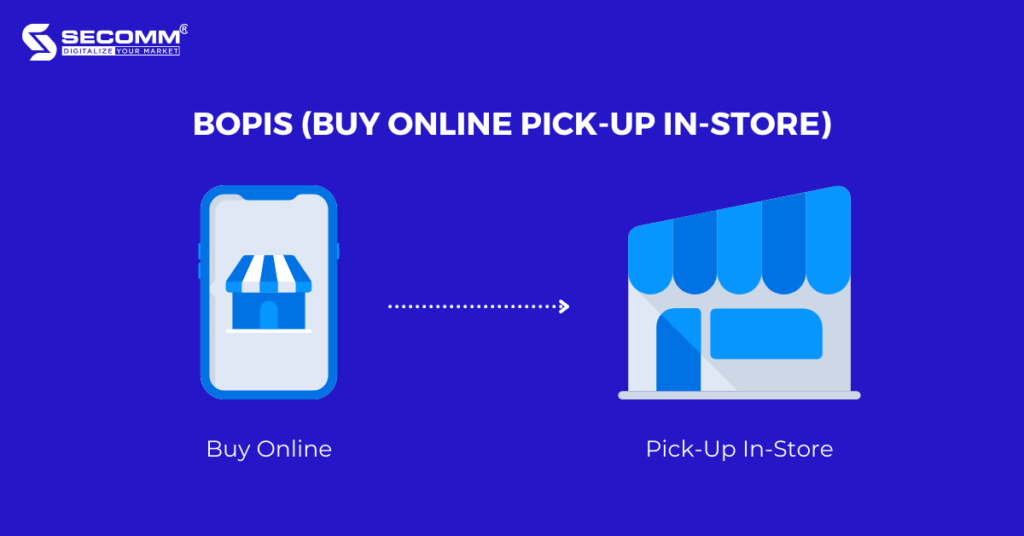
Although BOPIS is great, it may not be every customer’s choice as not everyone likes to go to the store to pick up the products, instead people prefer home delivery rather than the in-store pick-up option. Sometimes, shopping at the store also causes many inconveniences, for example, finding a parking lot to go to the store in a densely populated area, picking up the goods, and returning to the car, seems time-consuming and annoying for busy people.
To solve this problem, merchants can self-deliver if the store location is close enough and convenient for the delivery process to be fast and efficient. Otherwise, collaborating with delivery companies like Giao Hang Nhanh, Giao Hang Tiet Kiem, and so forth, is a good choice when the business resources need to be increased.
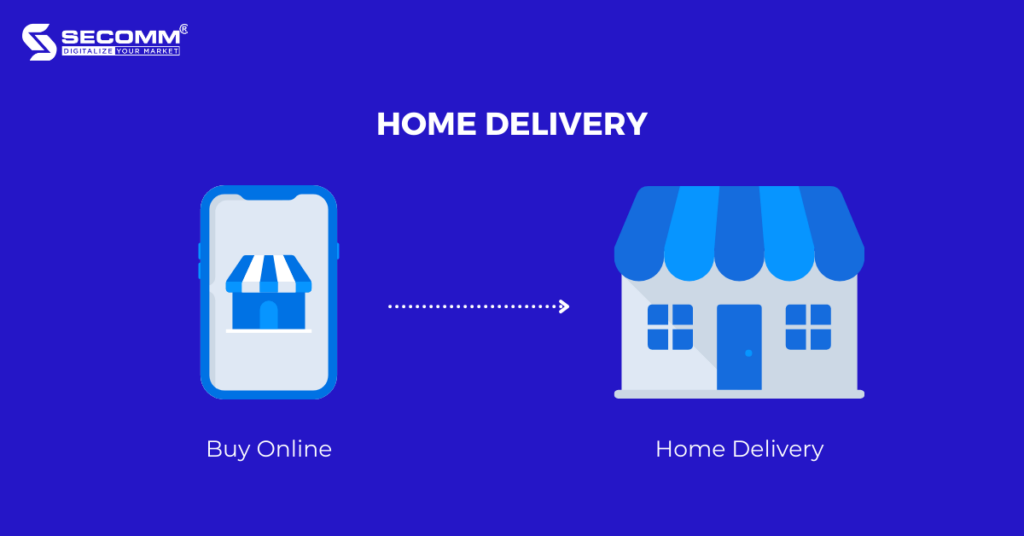
Suppose a customer bought a product online but when receiving it, he realized it didn’t fit his demand. There was a store nearby, so he decided to return the product he bought there. But when he arrived, the staff there didn’t accept his return request because they had no clues of that purchase in the store’s system.
Therefore, he had to return his order to the carrier and wait a long time before receiving his refund. That will make consumers wonder whether they should keep shopping with that merchant next time. Thus, in-store return has become a fantastic offerable solution for customers to avoid the hassle of returning goods. This method simplifies the return process for shoppers and merchants because returns and refunds are processed simultaneously, which means better customer service and a much faster return to stock.
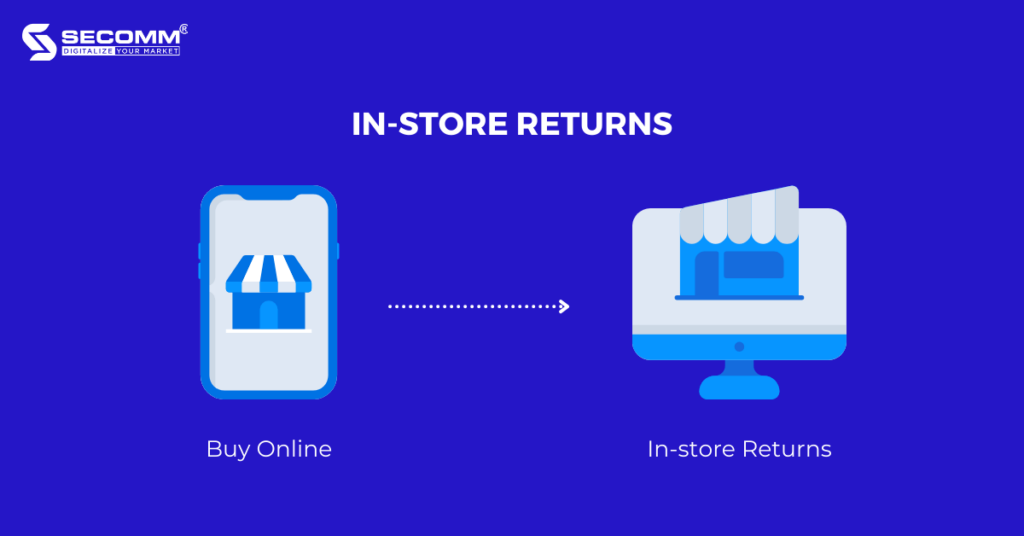
Loyalty Program is another great way to encourage customers to engage with the O2O shopping experience.

This is one of the popular types of loyalty programs. Every business can assign points to any items or user activities. While purchasing or joining any engaging program, customers will easily earn points afterward for later exchanging gift cards, vouchers, and even actual money which then encourages them to go back to spend more in order to get benefits from the gifts. As a result, reward points will boost sales and increase brand loyalty.
Gift cards can be used not just as gifting options but also as a powerful tool to get customers to spend in their outlet. Customers can use gift cards immediately or save for later purchases, or even give it to relatives and friends. As a result, relatives and friends are likely to become potential customers of the brand soon.

The first thing to do is identify the main objectives. If businesses haven’t built their online presence, they should do it immediately due to the rise of online shopping. If businesses already have their online presence (eCommerce website, mobile app, marketplace), it’s important to adjust their O2O Commerce strategy to increase sales online, offline, or both. They should also consider using some measurable metrics to ensure these objectives are appropriate and achievable.
Next is working with a team to raise ideas for the O2O Commerce strategy. Here are a few suggestions:
Then use these data to decide which strategies to try.
Once deciding on strategies to deploy O2O Commerce, businesses will use collected data to measure the success of those strategies and make the next business decisions. Looking back on the initial objectives when evaluating and adjusting the O2O marketing and business strategy, then considering the additional objectives if the original ones have been achieved.
Founded in 2014, SECOMM is specialized in providing O2O Commerce solutions. Over the years, SECOMM owns a massive fortune of O2O commercial projects with major domestic and international customers such as, Annam Gourmet, Trentham Estate, etc.
In particular, SECOMM provides a variety of services to support businesses to improve their competitiveness and dominate the retail market in the digital age including Solution Consulting, Core-team Building, and O2O System Development, including:
Business System
Administration System
Customer Experience Management System
Data system
Want to learn more about O2O Commerce as well as the best solutions to win the retail industry? Contact SECOMM now for a free consultation.
 2
2
 3,730
3,730
 0
0
 1
1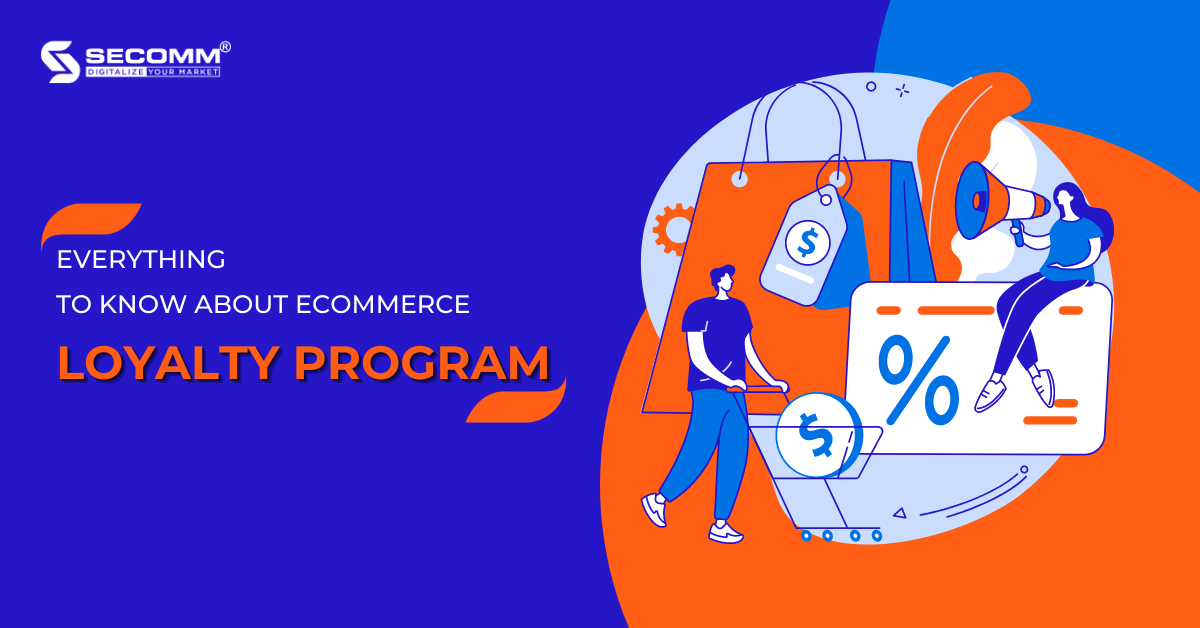
In the world of eCommerce, customer loyalty plays an important role in the success of businesses amidst fierce competition. There are many ways to build and maintain customer loyalty, but one of the most prominent is to enhance the customer experience through loyalty programs.
Sometimes businesses focus too much on finding new customers and forget the value of their existing customers. The following statistics show how valuable it is to maintain customer loyalty:
Existing customers are the best customers and the most valuable asset of an eCommerce business. These customers contribute greatly to the business profit and help businesses save time and money to acquire new customers.
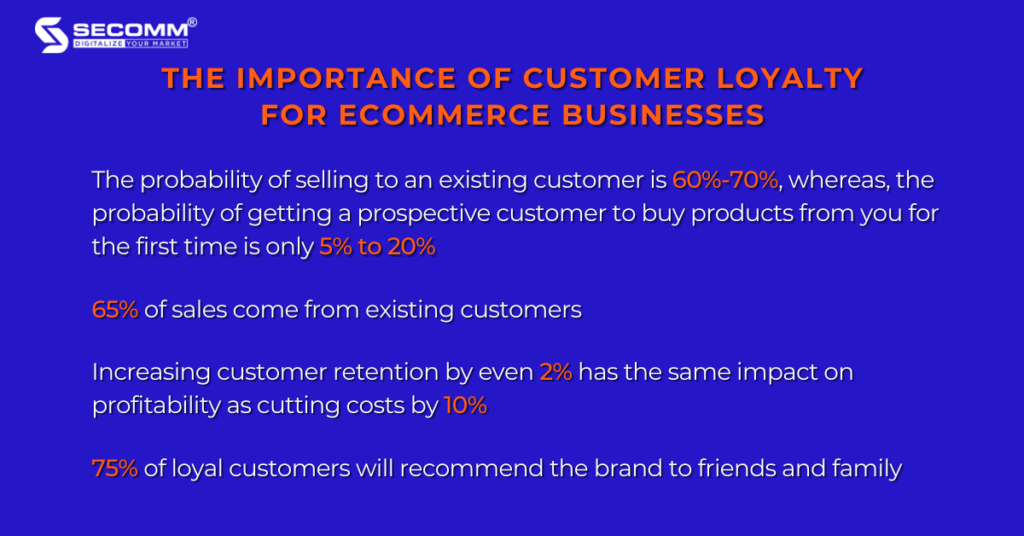
89% of eCommerce businesses around the world agree that the customer shopping experience affects customer retention. A high customer retention rate indicates that customers are happy and satisfied which leads to increased loyalty and repeated purchases.
Retaining customers plays an important role in eCommerce businesses because the cost of attracting new customers is five times higher than maintaining existing ones. Moreover, increasing customer retention by even 5% can increase business profits by up to 95%. This is because satisfied customers are likely to refer the brand to others.
Therefore, businesses need to focus their time, money, and energy on enriching the customer experience, persuading them to come back to shop more often, and recommending the brand to friends and family.
Among the various strategies for maintaining customer loyalty, Loyalty Program is one of the most effective factors for eCommerce success.
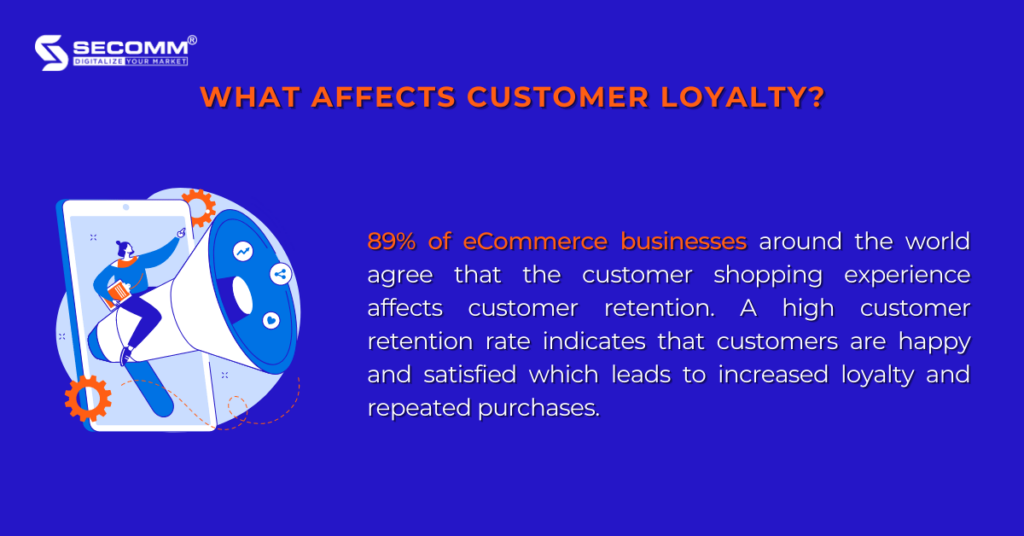
A loyalty program is a marketing strategy designed to encourage customers to continue to shop at or use the service of a business associated with the program. Simply put, eCommerce businesses build loyalty programs to reward customers for their purchases and engagement for a long time.
The reward can be any free product, discount code, or special offer to represent the appreciation of the business for its customers, who tend to spend more because of the benefits they receive when participating in loyalty programs.
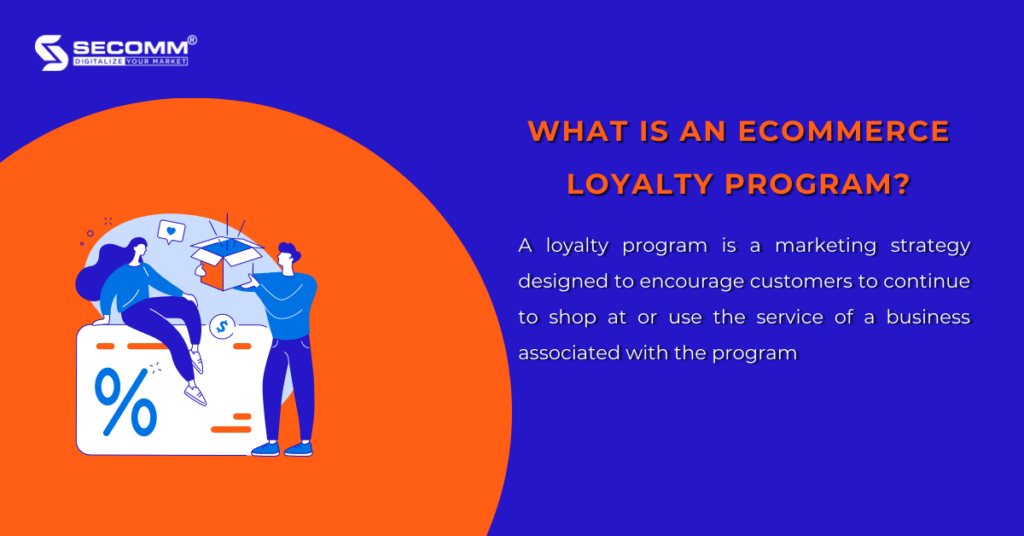
According to Yotpo, nearly 68% of customers said they would be willing to join the loyalty program and special incentives motivates them to buy more products.
Loyalty programs not only enrich the shopping experience and keep customers engaged with the brand but also from a business perspective, the benefits they bring to eCommerce businesses exceed the initial expectation.
The development of eCommerce helps customers shop more conveniently. That means their expectations for the shopping experience are higher. Today’s customers make their purchasing decisions not only based on price but also other factors such as service experience or emotional connection with the brand, etc.
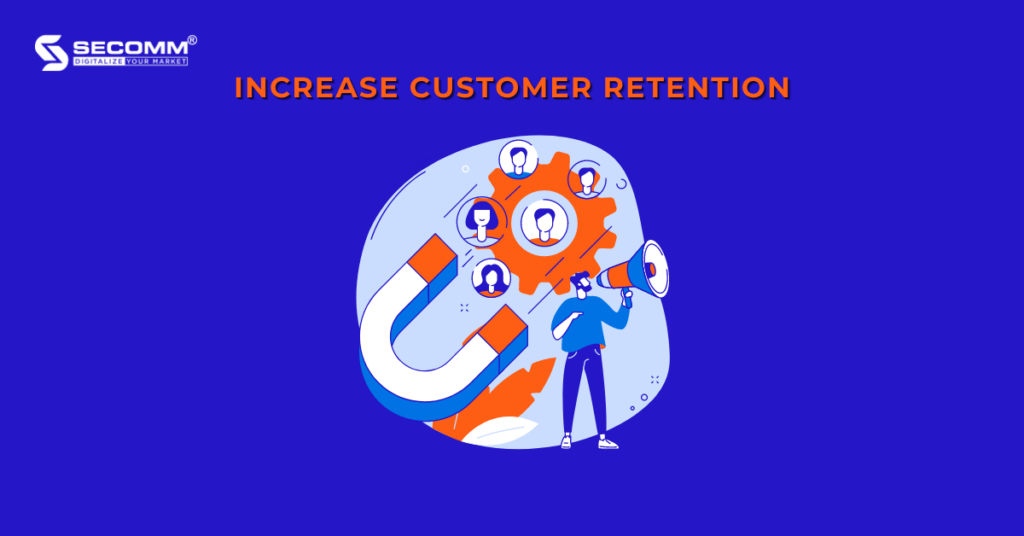
According to HuffPost, 66% of customers tend to switch brands for shopping if the service is not good enough. Loyalty programs help enhance the shopping experience. The more shopping satisfaction, the more customer retention and loyalty.
Customer Lifetime Value or CLV is a key metric that indicates the total revenue an eCommerce business can reasonably expect from a single customer account throughout the business relationship. Most business owners will always find ways to increase the CLV index in order to maximize their profit.
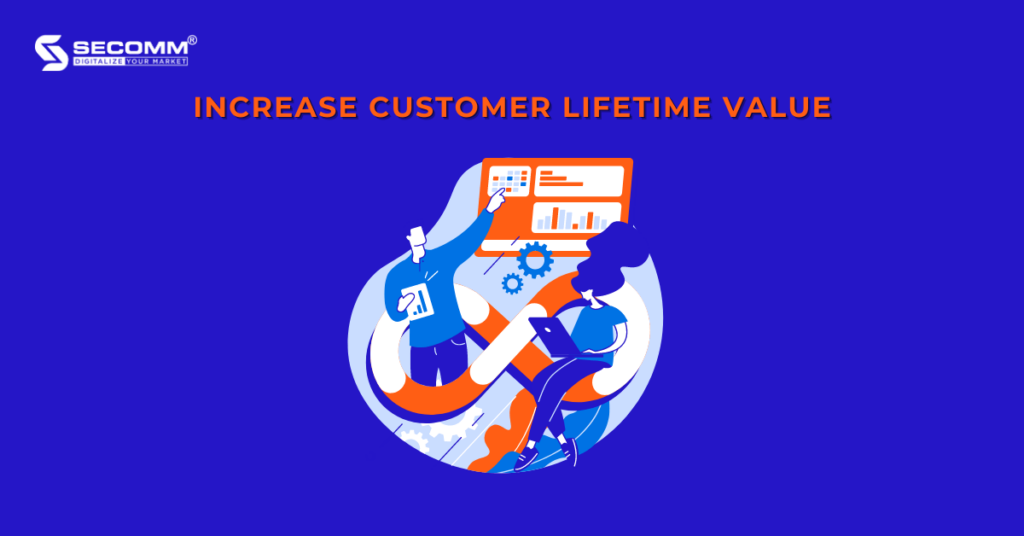
According to Harvard Business Review, the cost of acquiring a new customer is more expensive, ranging from 5 to 25 times, compared to retaining an existing customer. As a result, high lifetime value customers become priceless assets for a business, as their purchases will not require acquisition costs. In other words, a business doesn’t have to incur acquisition costs for loyal customers.
On the other hand, the business has to spend acquisition costs to convince potential customers to buy its products. Thus, even if a new customer spends the same amount on a product as an existing customer, it may not bring in equivalent profits because of acquisition costs.
In most cases, existing customers are also the most incredible advocates. When customers are satisfied with the shopping experience, they are more likely to share it with their family, friends, or colleagues, and the business will gain more potential customers naturally.

Compared to brand messages, recommendations from existing customers are even more effective. According to Nielsen, 77% of consumers trust recommendations from people they know more than any other source. As a result, before making a purchase, they will seek advice from people they trust. Plus, 64% of marketing experts believe that word-of-mouth marketing is one of the most effective forms of marketing.
With the development of the Internet and social media platforms, recommendations from existing customers come in various ways, including posts, comments on social media or review videos, etc. This helps reduce acquisition costs so that every eCommerce business needs to focus on enhancing their existing customer shopping experience and new customers will end up rolling in for free.
This is one of the most popular eCommerce loyalty programs since it is easy to set up and manage. By joining this type of program, customers can earn reward points after each purchase. They can then redeem their accumulated points for rewards such as gifts, discount codes, and other special offers. They also can earn reward points in many other ways besides making purchases, such as sharing product pages on social media, writing product reviews, completing surveys, filling out personal profiles, and so forth.
Although this type of program is relatively simple to implement, businesses still need to ensure that the points customers earn have enough value to encourage them to continue shopping. Plus, the time it takes to redeem points for rewards should be short enough because if customers have to wait for several months or even years to redeem points for a valuable reward, the attractiveness of the points-based program will decrease.

SHEIN, a popular fashion brand founded in 2008, has created a great SHEIN Bonus Point Program reward system on its mobile app. This program allows customers to earn points by registering an account, making purchases, reviewing products, and participating in special online events held by the brand.
Each activity equals a specific reward point. Then, customers can use their reward points to receive discounts ranging from 15% to 25%, and even up to 70% for their next purchase. Additionally, reward points can also be used to exchange vouchers or other special offers when customers participate in SHEIN events or play games on the mobile app.
Another popular loyalty program is the tiered-based one. It encourages customers to strive to move up higher tiers to receive more valuable benefits and rewards. The more customers spend on shopping, the more benefits they receive.
This program helps to foster customer loyalty to the brand. To maintain or move up in rank, customers have invested a lot of time and money, and they will not easily give up the huge benefits they are receiving to participate in another brand’s loyalty program.
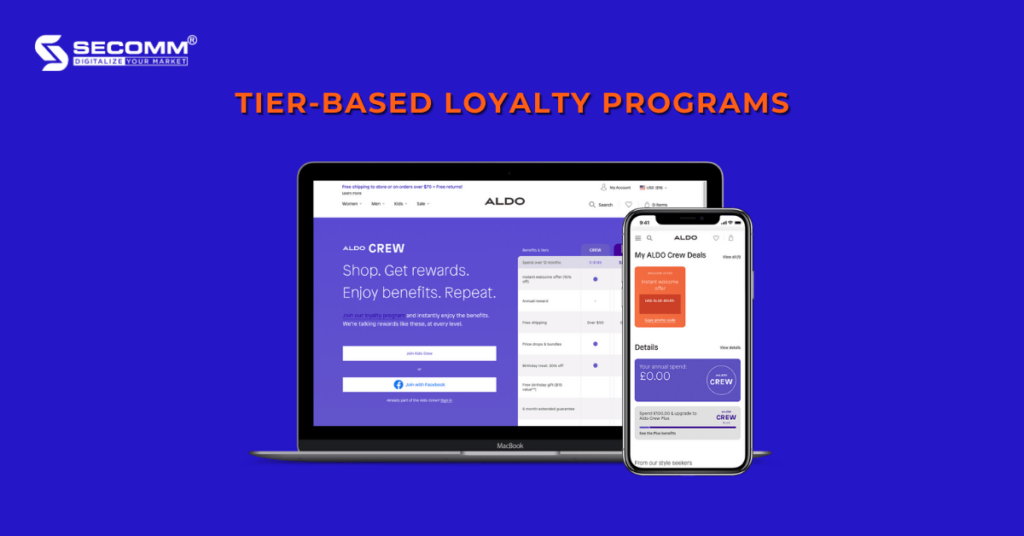
The famous shoe brand Aldo, with over 1,000 stores in 65 countries, focused on 3 main markets – the US, the UK, and Canada – when building their loyalty program. Known as Aldo Crew, the program offers customers three levels of membership: Crew, Plus, and VIP. All customers are initially enrolled as Crew level members. To advance to the Plus or VIP levels, customers must spend between $150-299/month for the Plus level and over $300/month for the VIP level. Depending on the level, each customer receives corresponding rewards, and VIP-level customers receive all the special perks offered by the Aldo Crew program.
eCommerce loyalty programs are very attractive because, from the customer’s perspective, they get benefits for free. However, in reality, customers have to make a purchase or perform a specific action to earn those “free” benefits.
Many world-renowned brands have created incentive programs based on subscriptions to provide incredible services and charge customers for participation. Amazon Prime, eBay Plus, and Walmart+ are some examples.

To participate and receive truly valuable benefits, customers are required to pay a fee. Since customers have to pay a fee, their commitment to engaging with the brand is also higher than in other loyalty programs. Also, because businesses charge customers when they register as members, this loyalty program type usually has a trial period for businesses to convince customers that the benefits they receive are worth the money they spend.
In 2020, the famous American retail chain Walmart launched a subscription-based loyalty program called Walmart+. The program is integrated into the Walmart app and offers many special benefits to customers both in-store and online, including:
To join the program and enjoy these benefits, customers have to sign up and pay a specific membership fee of $12.95/month or $98/year. Customers can try the program for 30 days before committing to a membership.
The loyalty program strategy plays an important role in customer experience which leads to their loyalty to the brand. The success of SHEIN, Aldo, and Walmart has become an inspiration for other eCommerce businesses to jump into the game.
To learn more and develop the best loyalty program strategy, contact SECOMM now for a free consultation.
 2
2
 4,929
4,929
 0
0
 1
1
Along with the development of technologies, social platforms like Facebook, Instagram, and Twitter have been around to satisfy the demand for online interaction for over two decades. However, the change in consumer behavior makes TikTok the new favorite.
By the end of 2022, TikTok was reported to reach 1B users globally, becoming the fastest-growing social platform ever. Having a large user base amid the rise of online shopping is an advantage, which contributes to TikTok’s ongoing transition into a Social Commerce platform.
Recently, the social media platform has added a new buying and selling feature called TikTok Shop. It is a new solution for businesses of all sizes to boost customer engagement, brand awareness, and sales.
The content of TikTok consists of vertically arranged videos that are compatible with smartphones and users only need to swipe up to watch a series of videos that are only a few seconds to one minute long. Creating content on TikTok is also easy and simple, users only need to upload the original video and add a few effects, then they will have an interesting and fun short video. With over 1 billion videos viewed on TikTok every day, it has opened up marketing opportunities for many brands.
The majority of TikTok users are Millennials and GenZ, and it now expands to even younger users. They are a driving force behind the increasing expectation of digital experiences. Over 55% of GenZ in Vietnam are using TikTok, in the US, 62% of people between the ages of 10 – 29 are using this social network. The attention span of Millennials is about 12 seconds and for GenZ it’s around 8 seconds. Therefore, TikTok’s short-length videos are particularly popular with these generations because of their easily consumable content.
When compared to Reels (a feature of Instagram) and Short (a feature of Youtube), TikTok even has the upper hand. As The Graygency has noted, the monthly user base of IG Reels is in the lead with 2 billion users, followed by Youtube Shorts with 1.5 billion, and finally TikTok with 1.2 billion. The Reels feature was launched in 2020 and immediately became popular due to Facebook and Instagram’s enormous existing user base. The same is true for Youtube Shorts.
Meanwhile, TikTok was launched in 2016 but has reached 1 billion users in just 5 years. For Instagram and Youtube, this number took 8 years. A new player like TikTok when compared to the 2 major social platforms with a not-so-significant difference in user base, makes TikTok incredibly special. Plus, when considering other criteria like Engagement Rate, Female Users, Male Users, etc, TikTok even has higher rates than IG Reels and Youtube Shorts.
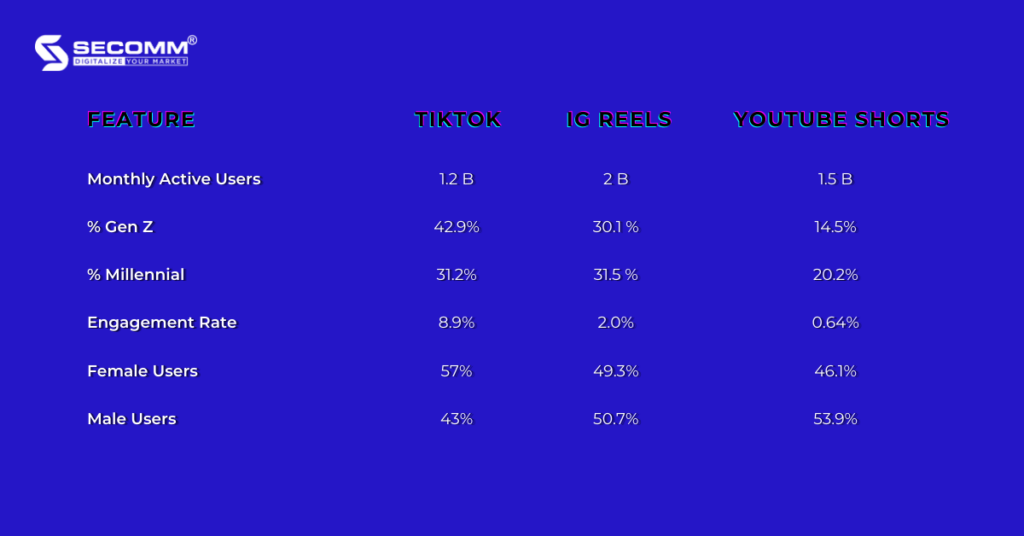
Another thing that makes TikTok special lies in its algorithm. When opening the app, users will see the “For You” page where TikTok displays videos that users may be interested in and immediately capture their attention. However, these videos don’t come from creators or brands that the user is already following but from the users’ interactivities on the videos, which is completely different from other social media platforms.
The “For You” page is the most successful feature of the app as it creates content every second specifically tailored to each user’s personal preferences. These successes have led to a new step for the social platform – TikTok Shop
TikTok explained in its launch statement:
“TikTok Shopping is a suite of solutions, features, and advertising tools that give businesses the opportunity to capture the full power of TikTok’s influence on purchase decisions”
Simply put, TikTok Shop is a new feature that allows TikTok users to buy products right on the app. Also, it provides businesses a way to display, promote and sell their products to a huge user base on TikTok.
After setting up the TikTok Shop feature, a dedicated shopping tab will appear on the brand’s profile. That way, customers can browse through and purchase within the TikTok app or be transferred to the brand’s eCommerce website for checkout.

Besides the TikTok Shop feature, TikTok Shop Live is also a great resource to take advantage of. Brands can integrate their products from TikTok Shop into their live stream to encourage customers to interact with the brand and whenever they see a product they like, they can buy it during the live shopping stream.
Let’s see the key TikTok Live Shopping stats:
Ha Linh, a female beauty vlogger in Vietnam, is widely recognized by everyone in the Vietnamese beauty community for her genuine product review videos. She fearlessly provides critical feedback on any brand, and her reputation precedes her. Recently, Ha Linh held her first live stream on TikTok, which incredibly got 11 million hearts and 80K views. To everyone’s surprise, within an hour, all the products from the three factories of the brands she collaborated with were sold out. This case highlights the effectiveness of influencer marketing campaigns in conjunction with TikTok Live Shopping for brands targeting young customer demographics.

According to research, 87% of customers make their purchasing decisions through information provided on social media, 90% discover brands through social media, and the average spent per day on social media is over 2 hours. This is a new great boost for Social Commerce globally. In 2022, global Social Commerce sales reached $992B and are estimated to exceed $3 trillion in 2026.
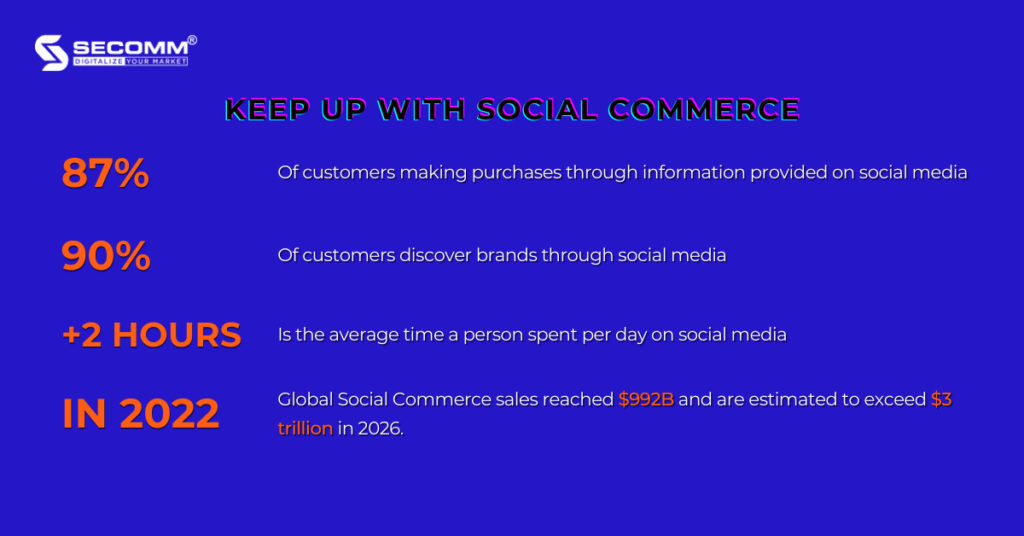
With a massive user base of over 1 billion, TikTok has the potential to become the leading platform in global Social Commerce, and the TikTok Shop feature has been launched to achieve that goal. TikTok Shop is currently available in Europe, North America, and 7 Asian markets, including Vietnam.
The short videos on TikTok are already very appealing, and when combined with cleverly integrated advertising content, they can attract users’ attention. This not only entertains and engages users, but also motivates them to make purchases from the advertised shoppable content. According to data compiled by TikTok, 67% of users have purchased after watching a video even if they didn’t intend to do so beforehand.
Thus, TikTok has created an infinite loop of shoppertainment that combines shopping and entertainment within the app. As TikTok prioritizes user-generated content and 83% of its users have created videos on the platform, after purchasing, they are more likely to share their experience with other people on the app. This ultimately creates an endless loop of shopping, discovery, consideration, purchasing, reviewing, and engaging that repeats itself.
The majority of TikTok users are in the age range of 18-34. According to Statista, as of January 2023:

Bên cạnh đó, những danh mục nội dung phổ biến nhất trên TikTok bao gồm giải trí, thể thao/fitness, nấu ăn, mỹ phẩm, thời trang,…
Do đó, nếu các doanh nghiệp đang kinh doanh trong những lĩnh vực này và hướng đến phân khúc khách hàng trẻ tuổi thì xây dựng hiện diện nhanh chóng trên nền tảng TikTok và tận dụng tính năng TikTok Shop là điều cấp thiết phải triển khai, như cách mà Kylie Cosmetics đã làm.
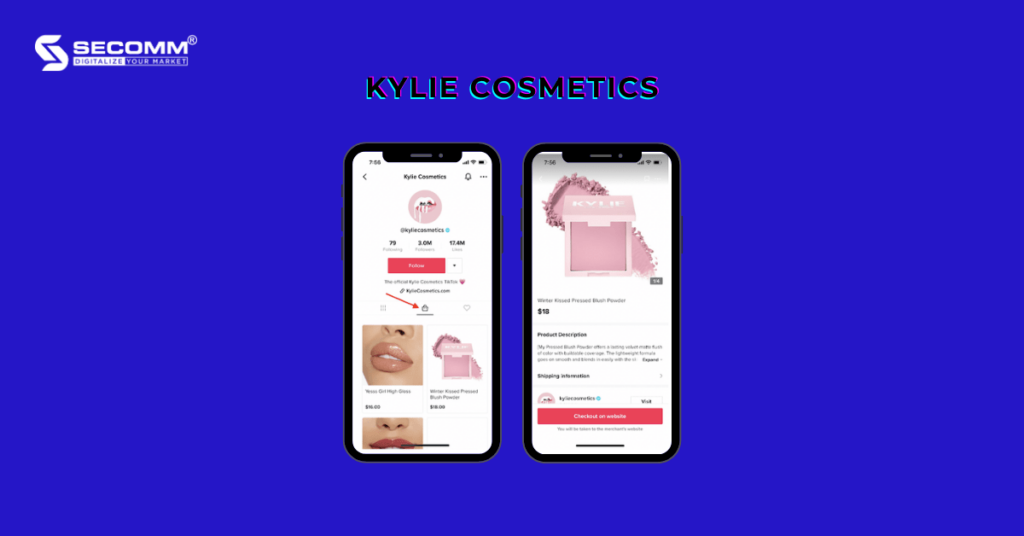
Moreover, the most popular content categories on TikTok include entertainment, sports/fitness, cooking, cosmetics, fashion, etc. Therefore, for businesses operating in these fields and targeting younger customer segments, building a quick presence on TikTok and leveraging the TikTok Shop feature is crucial to implement, as Kylie Cosmetics has done.
As soon as TikTok Shop was launched in the US market, Kylie Cosmetics was one of the first brands to get involved. To date, the brand’s TikTok account has over 3.5 million followers. Kylie Jenner once explained: “I built my business on social media; it’s where my fans go first to look for what’s new from Kylie Cosmetics. I have so much fun creating TikTok videos, and I love sharing posts of my fans using the products. That’s why I’m excited for Kylie Cosmetics to be one of the first to let customers shop directly on our TikTok!”.
If Influencer Marketing plays a crucial role in the brand’s success on other social platforms, TikTok is no exception. This strategy is primarily used to increase brand awareness, run promotional campaigns, and boost sales. TikTok is a place for creative and engaging short videos, so TikTok users have a special love and interest in creators with their unique style and creativity that attracts users’ attention.
TikTok Influencer Marketing is where business brands and personal brands are closely linked. Thus, some experts advise that in order to successfully implement TikTok Influencer Marketing, businesses should let their partners freely create promotional content as long as it meets ethical and cultural standards. This is because if TikTok videos are too focused on advertising, it will make users or potential customers “turn away”.
Walmart, the American retail chain, recently sponsored a dance challenge called “SavingsShuffle”, which required players to show how to save money while shopping at Walmart with their creative fun dance moves, and then post the recorded video on TikTok. Six influencers were chosen to promote this campaign, including Trinity, AdamW, Sam Hurley, Bdash, Kidrl, and Ajani.

With many years of experience in successfully implementing eCommerce for many customers in many countries, SECOMM understands the difficulties and challenges of implementing eCommerce. Talk to our expert to get free advice on eCommerce implementation.
 2
2
 7,586
7,586
 1
1
 1
1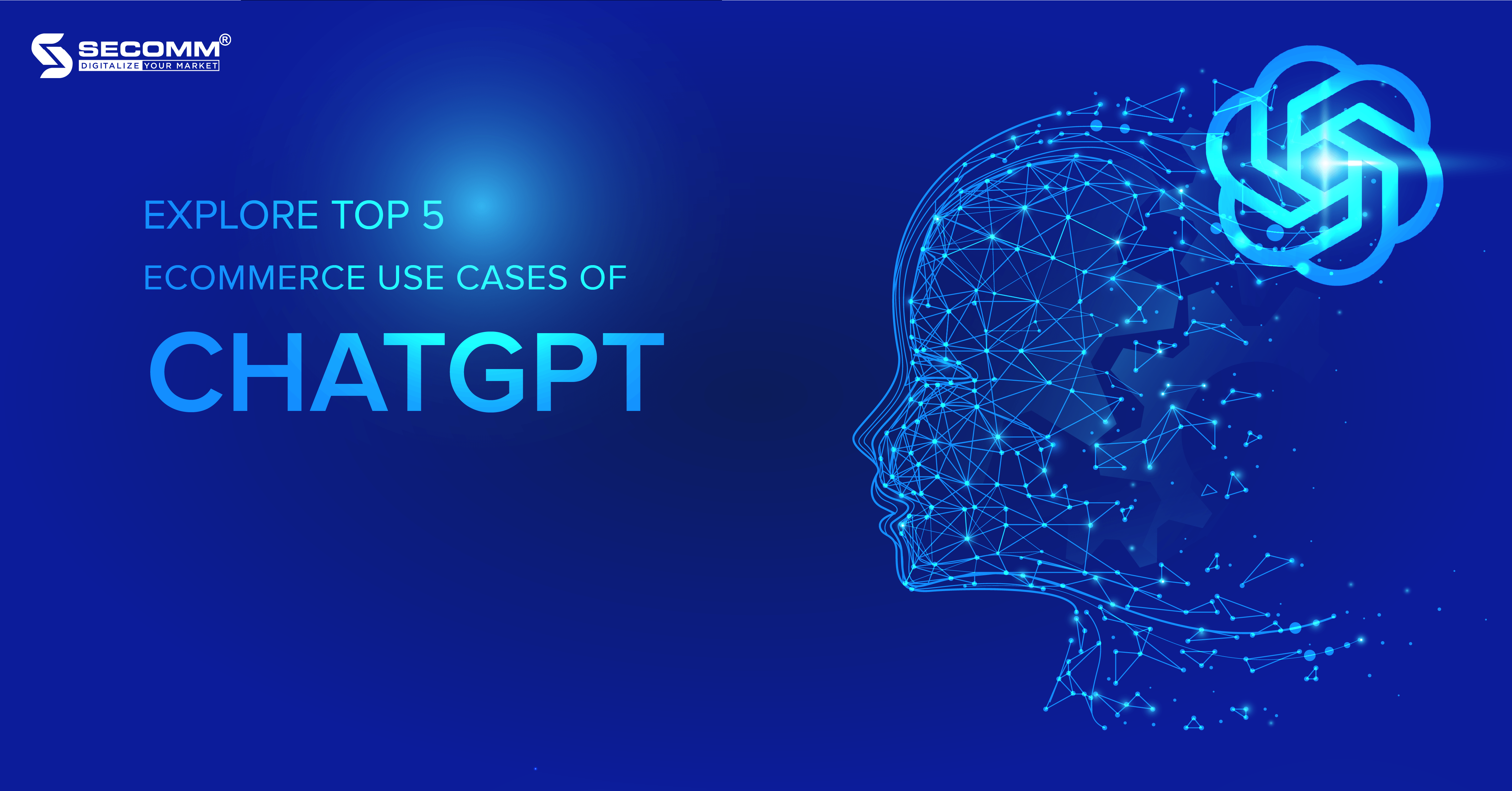
ChatGPT is a new popular AI-powered tool. With the ability to generate human-like text, ChatGPT has a variety of applications in healthcare, education, entertainment, and even in the eCommerce world.
In this article, we will share the top 5 use cases of ChatGPT that business owners can leverage to accelerate their eCommerce.
ChatGPT (Chat Generative Pre-training Transformer) is a large-scale language generation model developed by an AI company called Open AI, which was formed in 2015. ChatGPT is regarded as one of the most advanced language models available today since it can produce human-like text. It can be used for a variety of tasks, including answering questions, creating essays, emails, poems, and even programming.
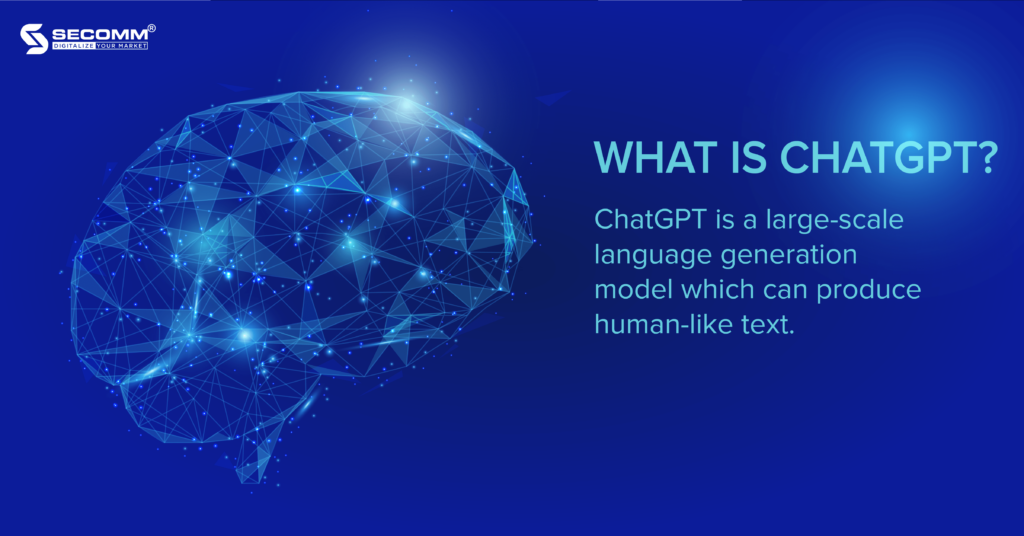
You can simply use ChatGPT by visiting OpenAI’s website to create an account. Once you’ve logged into your OpenAI account, on the ChatGPT side of the website, you need to read through and accept ChatGPT terms. Then, you can start your conversation with it by asking questions.
Because it is still in the research and feedback-collection stage, it is free to use. But as of February 1, 2023, the OpenAI company launched a new version of ChatGPT Plus in the US for $20/month, while keeping the free version.
ChatGPT runs in a language modeling architecture called Generative Pre-training Transformer (GPT), specifically GPT-3. This type of AI model is trained on vast amounts of information from the Internet, including websites, books, articles, and so forth.

It is fine-tuned using reinforcement learning. Meaning that ChatGPT “learns” from information found on the Internet as well as the user input. Due to Reinforcement Learning from Human Feedback (RLHF), ChatGPT is unique.
RLHF enables human AI trainers to build conversation models in which humans act as both users and AI assistants, according to OpenAI. That helps ChatGPT learn new information rapidly and grow more intelligent.
ChatGPT is a language model to generate conversation with the end users, whereas Search Engines index web pages on the Internet to help users find what they desire. ChatGPT can understand and respond to input information quickly. But, it does not search on the Internet for the information, instead, it uses the training data to generate a response.
Another difference is that ChatGPT’s information update speed is still slower than that of search engines. Some search engines like Google can access the latest information but ChatGPT can only access data up to September 2021. Thus if you ask ChatGPT who is Miss Vietnam 2022, it would not be able to answer while Google could give you an immediate answer in just 0.6 seconds.
Using ChatGPT helps increase revenue and enhance eCommerce business operational effectiveness. Here are 5 great ways to use ChatGPT in eCommerce.
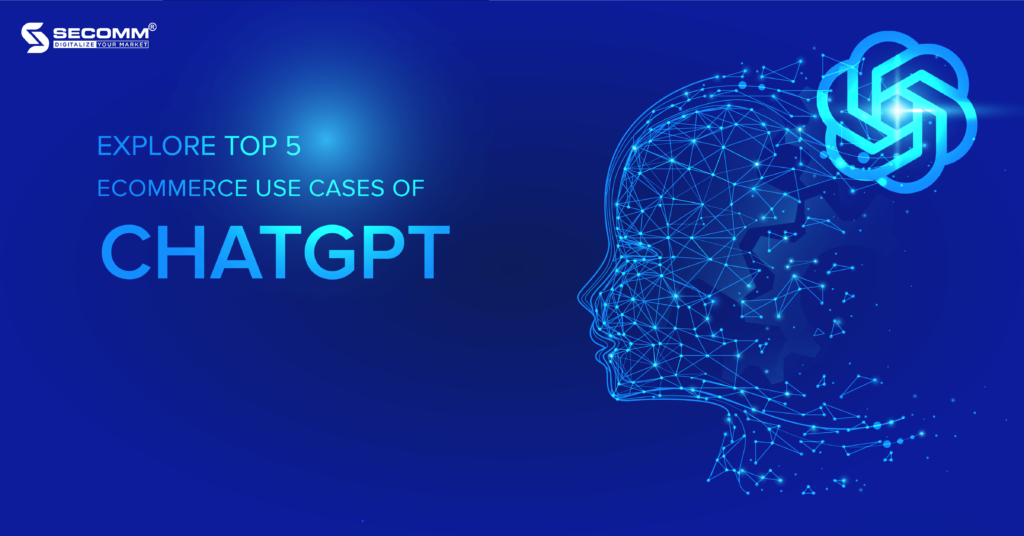
Because an eCommerce website has different product categories, writing a unique description for each product takes a lot of time and resources. ChatGPT can be used to automatically generate compelling product descriptions. This can save time and effort for business owners while still providing customers with high-quality information about the products. Moreover, this language model can create SEO-optimized descriptions that improve product visuality.
For example, a fashion retail brand has launched a new sportswear collection. ChatGPT will generate descriptions focused on moisture-wicking, comfortable fit, and the full range of motion and flexibility. It not only informs customers about the technical aspect of the product but also encourages them to shop with compelling and persuasive words.
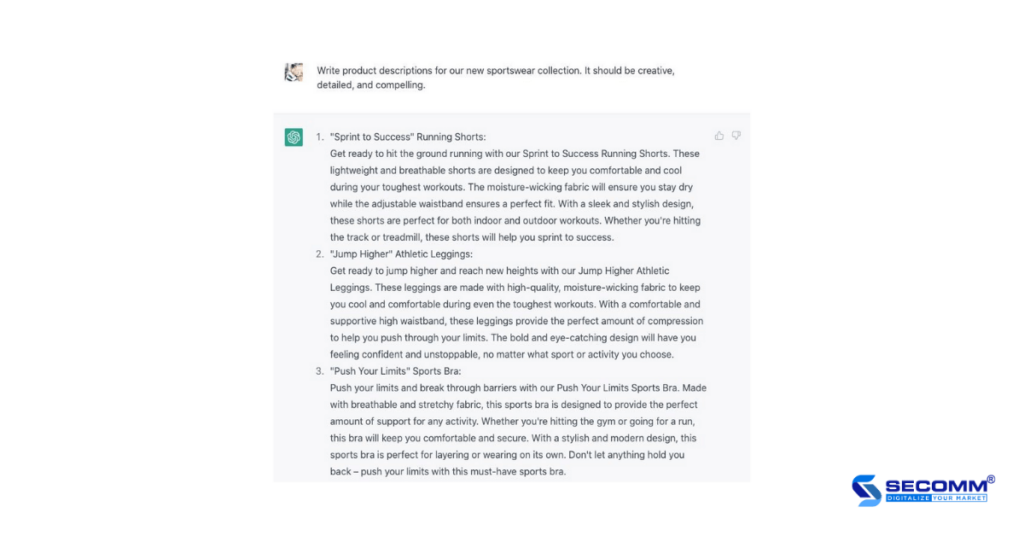
ChatGPT còn được các doanh nghiệp thương mại điện tử sử dụng trong việc đưa ra đề xuất cá nhân hoá sản phẩm. Bằng cách sử dụng dữ liệu khách hàng và lịch sử duyệt web, ChatGPT có thể đưa ra các đề xuất sản phẩm phù hợp cho từng khách hàng cụ thể.
Ví dụ: Gần đây có một khách hàng tên Mỹ đã mua một chiếc áo thun thể thao tại cửa hàng, doanh nghiệp có thể sử dụng ChatGPT để đưa ra đề xuất sản phẩm tương tự mà khách hàng này có thể quan tâm. Từ việc gợi ý sản phẩm phù hợp và cá nhân hoá có thể giúp tăng mức độ tương tác và doanh số bán hàng.
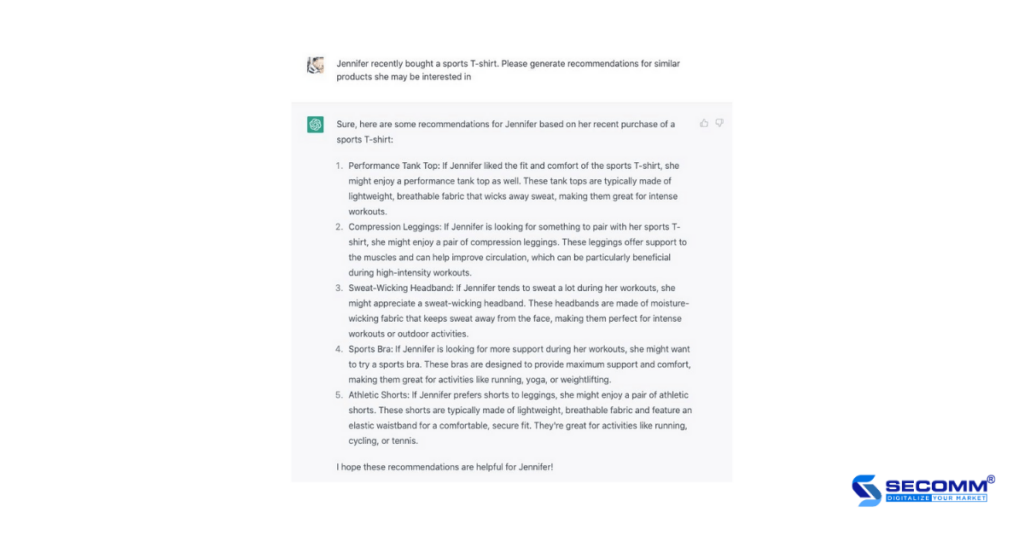
Another way to use ChatGPT is to generate engaging social media content.
For example, a company can use ChatGPT to generate promotional posts on social media platforms to introduce features and benefits of products engagingly and excitingly. Posts can include a caption, image, or video to highlight the advantages of that product. By leveraging the power of ChatGPT, businesses can promote their products and reach new customers on social networking sites effectively.
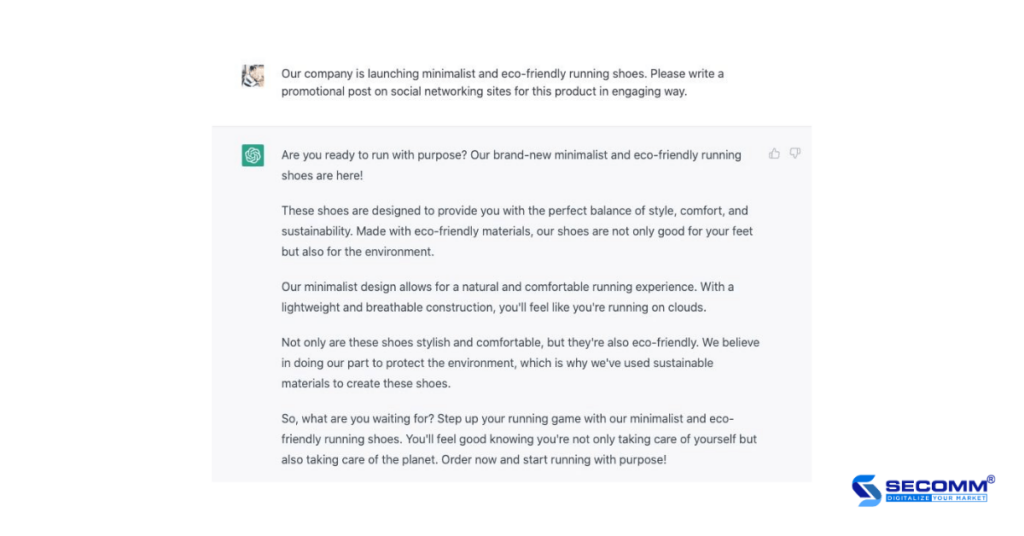
Running email marketing campaigns enables eCommerce businesses to build relationships with their customers, advertise their products and boost sales. By sending personalized ideal emails to customers and prospective customers, businesses can earn customer loyalty and encourage repeat purchases.
ChatGPT can be used in your email marketing campaigns targeting specific customer segments to achieve the desired results.
Example: Jennifer is a regular customer of a sports fashion company. Now the company launches eco-friendly sneakers with a minimalist design. The company uses ChatGPT to compose content for email marketing campaigns to introduce Jennifer to new products and ideal incentives for loyal customers.
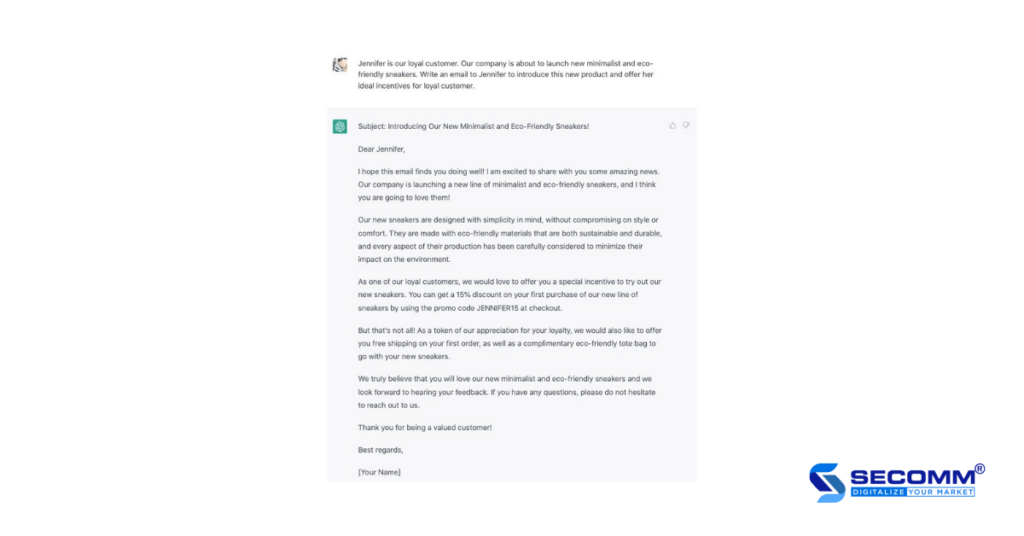
eCommerce business owners can use ChatGPT to handle customer requests in a personalized way. It could be responding to inquiries about order status, product availability, shipping fee, or return concerns. By providing ChatGPT demographic information such as age, gender, and interest, it will immediately generate text for a specific customer in a specific case. That helps increase customer engagement and conversion rate. Businesses will free up time and workload for the team to focus on more important tasks.
For example, if a customer named Jennifer asks for a return process, ChatGPT can generate a response with detailed information including requirements and time for return.
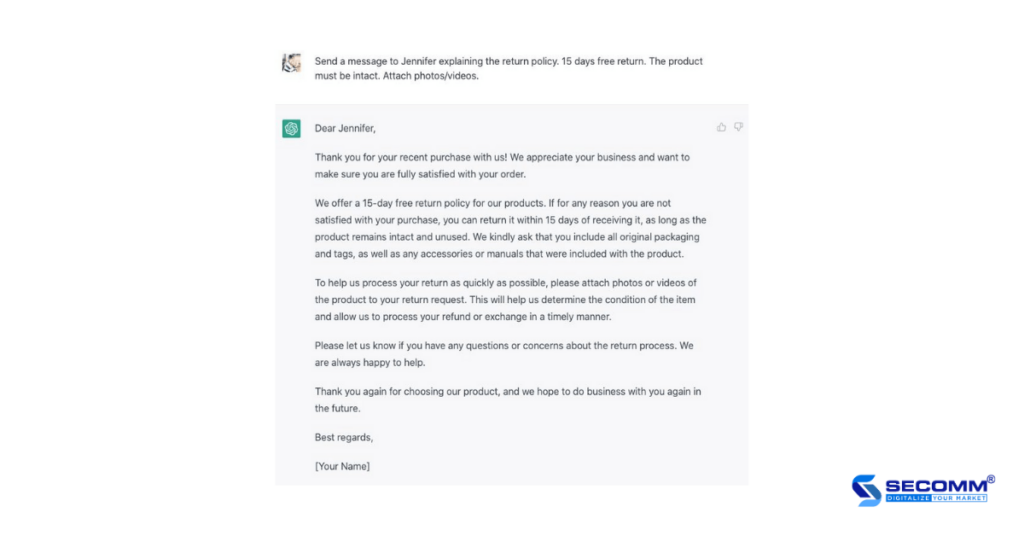
Like every AI-powered tool, ChatGPT has its downsides when used in eCommerce.
Firstly, although ChatGPT helps generate content for marketing campaigns quickly and automatically, it still can’t compete with the original writing by humans. If people depend too much on ChatGPT, their writing will become robotic and clunky which might affect their marketing campaigns the most.
In addition, as mentioned above, ChatGPT is trained by reinforced learning. This leaves room for issues since the information ChatGPT “learned” might not be accurate, hence generating wrong answers for users.
Last but not least, businesses should use ChatGPT with caution. They might want to clarify the information given by ChatGPT carefully before using or publishing their content, which could harm the businesses’ reputation when incorrect or misleading information is used.
Every business owner today can use the five most effective ways to use ChatGPT in eCommerce to stand out from the crowd. Yet, it’s not easy to use it properly and make it an important factor of eCommerce business without being dependent.
Talk to SECOMM now to get started.
 2
2
 4,781
4,781
 1
1
 1
1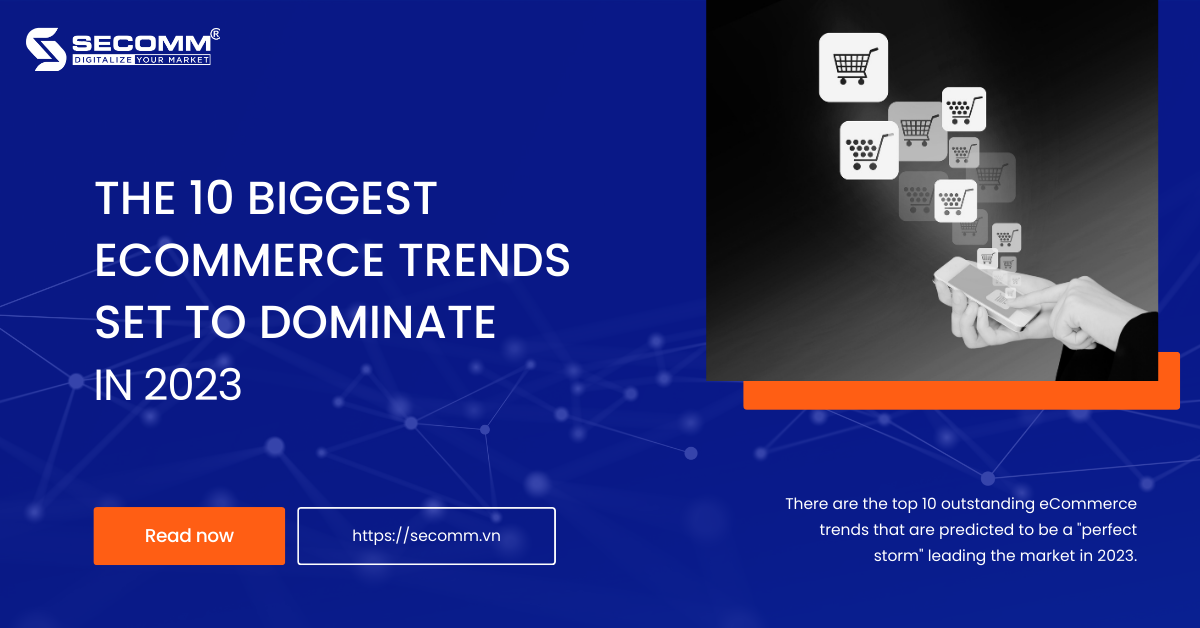
The eCommerce industry has a sizable market share in the Vietnamese economy and has shown impressive growth over the past two years due to the effects of the worldwide pandemic and social isolation.
After a year of society adjusting to the “new normal”, customers have started to buy at traditional stores again but the established trend of eCommerce consumption and the push from the wave of global digital transformation have encouraged businesses to change in order to suit the way the digital economy works.
Therefore, recognizing and anticipating the eCommerce trend of 2023 is extremely necessary for businesses’ New Year’s Marketing strategies to be implemented effectively and successfully.
Below is a list of 10 eCommerce trends that are forecast to “storm” the market in the next year.
Omnichannel is an omnichannel sales model that helps businesses reach customers through many channels such as eCommerce websites, social networks, eCommerce platforms, chain stores, and distribution agents but operating in just one management system.
Additionally, there is a second type of sales model called “Multi-channel” that differs from Omnichannel in that it allows for discrete marketing content, unlinked data, and independent channel operation.
When purchasing across numerous channels, continuous and seamless updates result in a heterogeneous and seamless customer experience.

Due to the lifting of social distance restrictions, consumers are beginning to return to in-store buying after two years of online shopping.
However, that doesn’t mean that eCommerce’s growth momentum is stagnant; on the contrary, it keeps exploding.
Businesses there make use of the current rise in popularity of online shopping to encourage the use of Omnichannel to improve the varied and efficient shopping experience.
As researchers have noted:
As a result, 2023 will still be recognized as a strong year for omnichannel in eCommerce.
Mobile Commerce or mCommerce is a business model that allows companies and individuals to deliver goods and services directly to consumers through handheld wireless devices such as smartphones and tablets.
According to Bankmycell, the number of smartphone users worldwide in 2022 is 6.648 billion, equivalent to 83.07% of the world population owning a smartphone.
Moreover, it is predicted that this number will increase to 7,516 billion by 2026. In addition, the percentage of global users participating in online shopping in 2022 accounts for 58.4%.
In Vietnam alone, interesting figures are listed in the Vietnam eCommerce White Book in 2022:
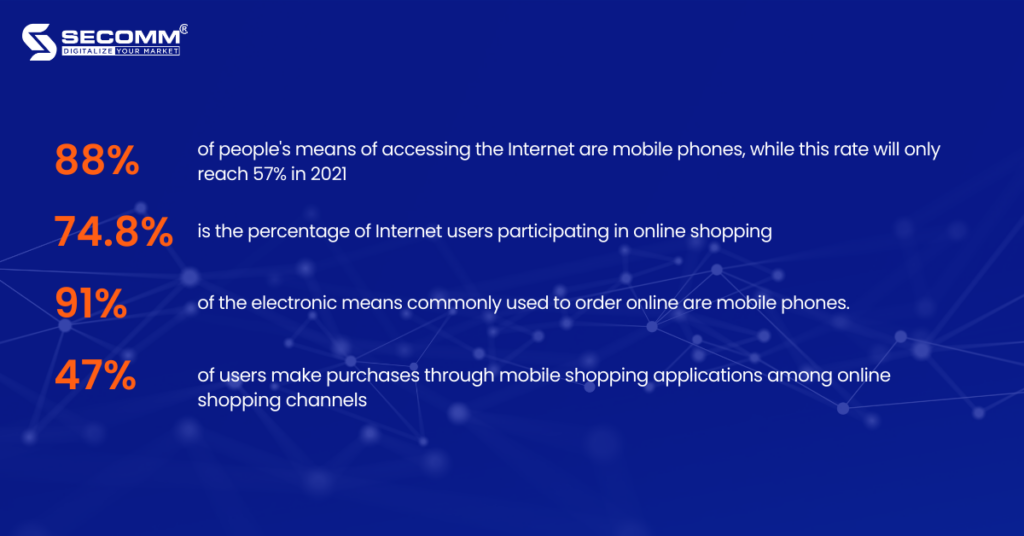
In upcoming years, the percentage of global people and Vietnamese people as well who own mobile devices and use them for online shopping is high and predicted to increase significantly.
Social commerce refers to the method through which companies advertise and sell goods and services online using social networking sites like Facebook, Instagram, TikTok, Youtube, Zalo, etc. In other words, this type of business combines eCommerce and social media.
The impact of social networks has grown significantly in recent years. Over 59% of the world’s population uses social media, it is not surprising that this percentage will continue to rise.
While in the past businesses used social media to raise brand awareness and draw in new customers, today eCommerce businesses boost sales by offering goods and services to clients online via social media.
As a result, it’s incredibly handy for customers to interact, exchange information, and search and shop online all in one location.
According to Statista, global social commerce sales will reach $992 billion in 2022 and are projected to reach nearly $3 trillion by 2026.

Thanks to the development of social networks, social commerce has had a strong acceleration and has become a magnet for brands to come to approach and analyze a large number of potential customers, and achieve marketing and sales goals.
As a result, failing to prioritize social commerce in enterprises’ marketing strategies in 2023 is probably to lead to a significant loss of competitive advantages in the eCommerce market.
Today, businesses have a lot of choices to build an eCommerce website, but basically, the structure of a website will include the following main parts:
For websites using a traditional structure, the frontend and backend will be operated on the same platform and from there will be closely connected with each other. Therefore, any changes on the website will be edited in two parts at the same time. However, with Headless Commerce, the backend and frontend will be decoupled from each other and operate independently on two separate systems.
The benefits of deploying Headless Commerce:
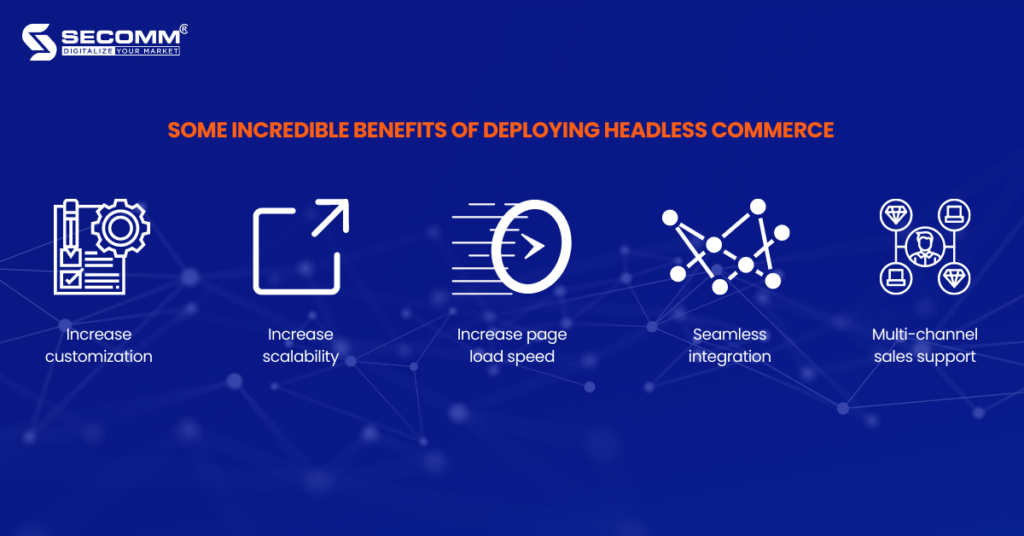
By using the Headless structure, Nike has become a brand with a much larger market share than Adidas – a formidable competitor of Nike.
Moreover, Nike’s website recorded more than 60 million pageviews in just 1 month. In addition, the proportion of direct purchases without intermediaries also increased significantly.
From Nike’s Case Study, one of the practical alternatives for companies looking to encourage eCommerce sales growth is Headless Commerce.
Shoppertainment is a form of shopping combined with entertainment that is used as a marketing strategy to encourage customer engagement with brands and consequently increase shopping demand. Moreover, it is used and takes over most of the online commerce in the era of digital transformation, when eCommerce is positioned at the forefront of contemporary business trends.
Some common practices of Shoppertainment trends:
These three practices all focus on entertainment and interaction. Then, the emotional element is aroused, leading to a series of unwise and unplanned shopping decisions. From a business perspective, this is beneficial for brands. TikTok‘s recent research proves it:
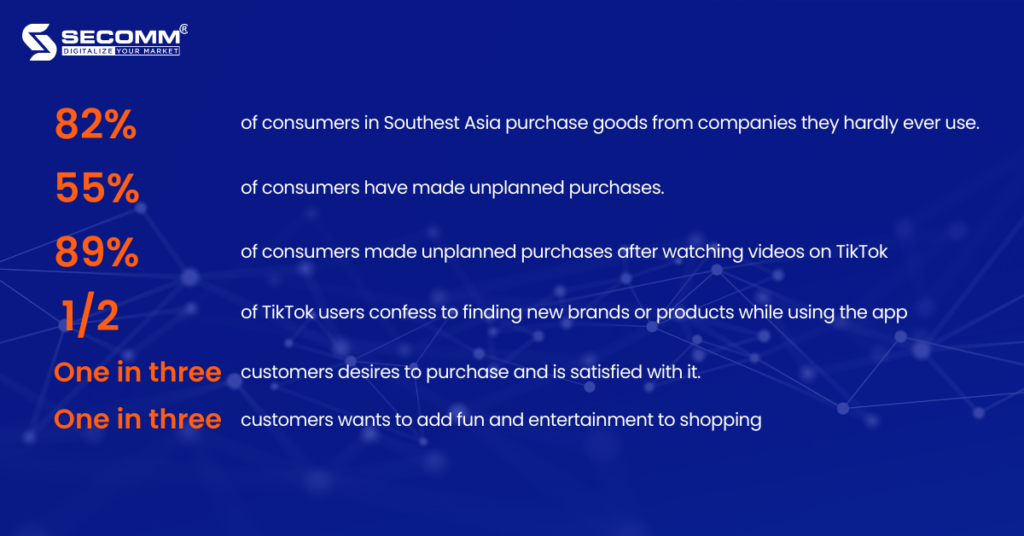
The growth of the Shoppertainment trend in recent years demonstrates the extreme demand for social interaction and connection following the period of Covid’s life.
Shoppertainment is the solution that businesses seek. This is a way to make the most of the customer’s biggest weakness – emotions.
When feelings of euphoria and joy are elicited during the shopping process, customers engage more, and purchase more unplanned products, conversion rates are higher, and sales follow.
Artificial intelligence now has a significant impact on eCommerce businesses in providing solutions to optimize the online shopping experience of customers.
The following statistics demonstrate the incredible influence of AI on the eCommerce market and businesses operating in this field:
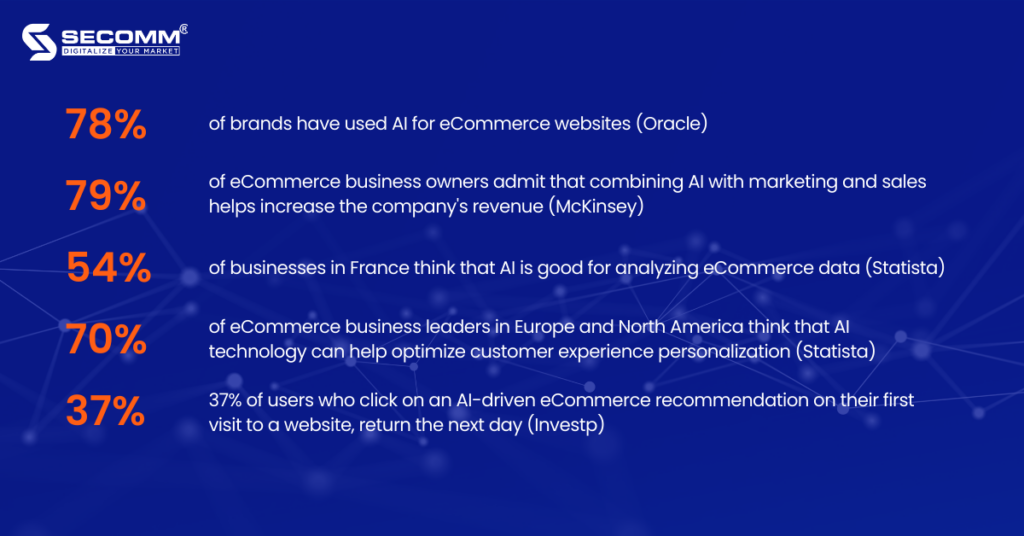
Currently, there are two applications of AI technology that are commonly used in eCommerce:
For eCommerce businesses, Chatbots will be like salespeople who can interact directly with customers 24/7. This helps businesses narrow the distance in terms of geography and time zones, helping the sales and customer services process to take place effectively without interruption.
By collecting customer data, AI can create tailored content and recommendations for each specific customer. To improve marketing campaigns and personalize the customer experience, AI can also predict purchasing behavior based on a user’s browsing and search history, when the data is legally available.
VR (Virtual Reality) is a modern technology that brings users into a simulated but still very realistic space with only 3D glasses (virtual reality glasses). The virtual world that the user sees is actually set up and controlled by a highly configurable computer system.
AR (Augmented Reality) is a new technology enhanced from VR technology. This technology has the potential to erase the boundary between the real world and the virtual 3D model. That is, users will experience virtual models in real space through smartphones or computers.
With a clear plan and the appropriate approach, Lazada has been in front of the augmented reality trend for a number of years and developed a certain competitive advantage in luring both consumers and sellers.

In particular, the VTO (Virtual Try On) function on Lazada includes a wealth of features to assist customers in freely selecting and trying goods like eyeshadow, eyeliner, foundation, and cushions whenever and wherever they like.
Since its launch, LazMall brand partners in the cosmetics sector have experienced tremendous success with the VTO function, which has helped to boost conversion rates by 3.1x and average order values by up to 11%.
The rapid growth of social networks and eCommerce has given marketing efforts a fresh and original breeze thanks to KOL/KOC. Although KOL and KOC have long existed in some form, they have truly taken off in recent years.
KOL – Key opinion leader, also known as an “influencer”, is an individual or organization with expert product knowledge and influence in their field or industry.
KOC – Key Opinion Consumers are “the most influential consumers in the market”. Their job is to test products and services and make comments and reviews.
KOL will suit mid- to high-end brands, while KOC will suit mid-range brands. If KOL is used to select brand ambassadors, holiday season ambassadors, or product launch campaigns, KOC is used to boost sales in a short time or direct customers to websites or eCommerce platforms.
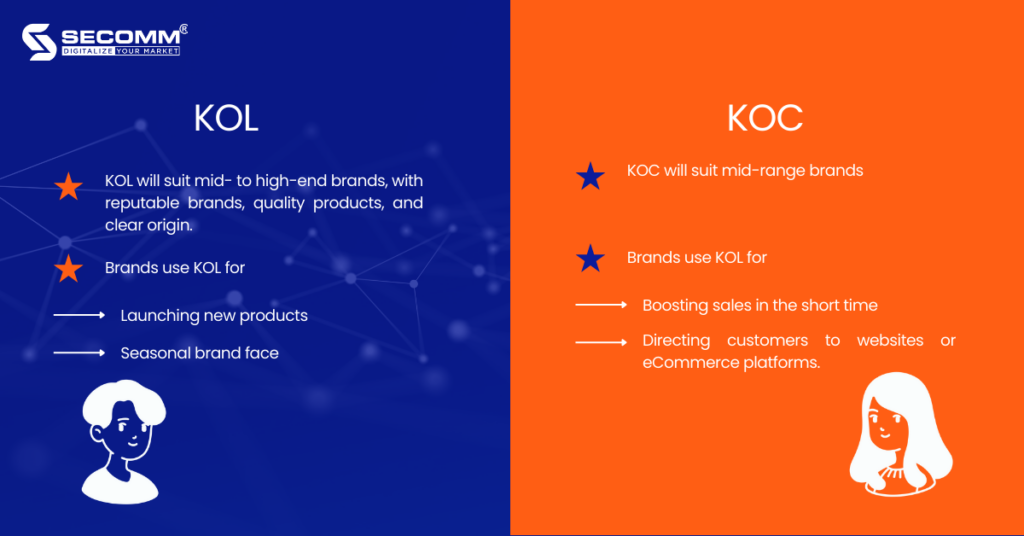
Some famous KOLs in Vietnam: Helly Tong, Giang Oi, Dino Vu, Co em Trendy, Chau Bui, Khanh Vy, Khoai Lang Thang,…
Some famous KOCs in Vietnam: Ha Linh, Call Me Duy, 1m88, Ong Giao Review, Chau Muoi, Hoang Viet, Pu Met 7,…
BOPIS – Buy Online Pick-up In Store is one of the shopping trends that promise to explode in 2023. Customers won’t have to be concerned about shipping costs, extended delivery times, or the risk of receiving unexpected goods when using BOPIS.
Businesses all around the world are pushing up their BOPIS implementation to meet customer expectations when merging online buying with in-person pickup. This is the ideal approach to boost store visits and close the gap between the offline and online buying experiences.
According to GlobeNewswire, the global BOPIS market is projected to reach $703 billion by 2027 with an estimated CARG of 19.3% between 2021-2027.
In addition, the following BOPIS trend statistics can help businesses consider implementing in 2023:
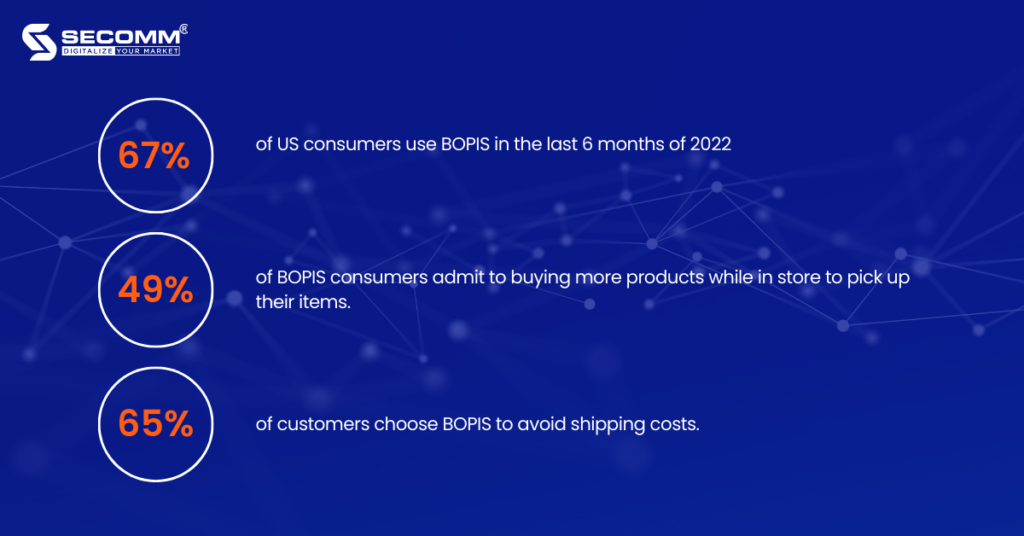
The BOPIS model also aids businesses in cutting expenses, expediting deliveries, boosting demand for retail goods, and lowering the risk of product returns.
User Generated Content, also known as UGC, includes text, photos, video and reviews. Because people are becoming less and less engaged in the brand’s message over the past ten years, UGC has grown in importance.
According to a recent Salesforce survey, 53% of Millennials think user-generated content (UGC) influences their shopping decisions, and 92% of consumers prefer content created by friends and family over that created by brands. The reason for the above numbers is trust.
Therefore, user-generated content (UGC), such as photos, videos, and customer evaluations, is trustworthy social proof and aids in the development of a company’s reputation.
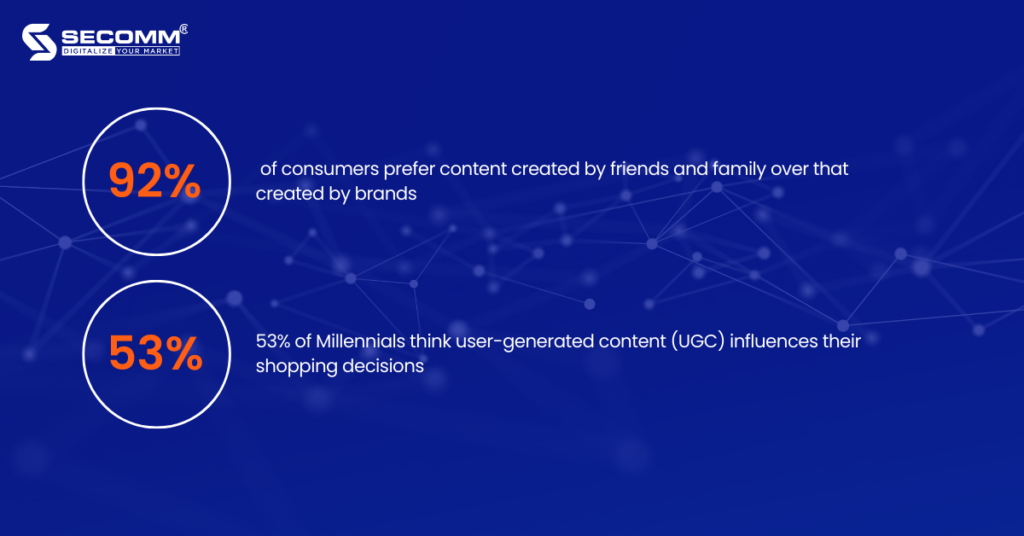
In a nutshell, businesses must quickly adapt to evolving eCommerce and digital technology trends in order to avoid falling behind and being driven out of the market. By reading 10 eCommerce trends that stated and analyzed above, businesses will have an overview to be ready for the new journey.
With many years of experience in successfully implementing eCommerce for many customers in many countries, SECOMM specializes in providing consulting services with comprehensive and professional eCommerce implementation solutions.
Contact SECOMM today for free support and advice.
 2
2
 5,494
5,494
 0
0
 1
1
Over time, the Covid-19 pandemic has greatly damaged the world economy, with significant consequences for investors and business owners across a wide range of sectors, including the wine sector.
Sales of alcoholic beverages have decreased dramatically as a result of the closure of hotels, restaurants, and nightclubs as well as the postponement of big events and festivals.
Despite the global economic issues, eCommerce must be considered among the industries that perform very well. Some companies across multiple areas have enthusiastically embraced eCommerce to weather the downturn.
Also, wine firms follow that wave of change, making eCommerce shine in the new era – the era of digital transformation.
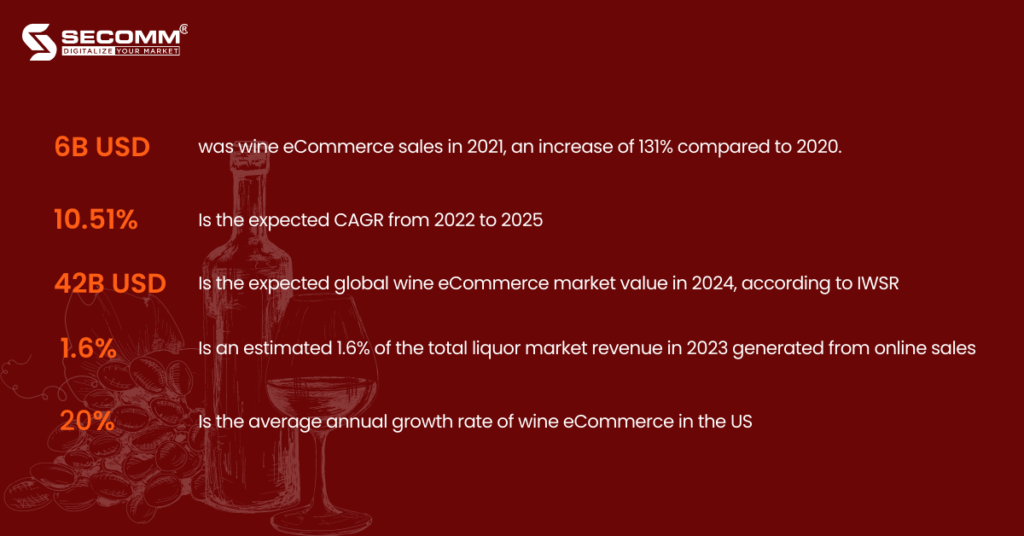
Global Pandemic
In the midst of the global pandemic-related crises, the wine business, like many others, saw a breakthrough in the speed of online purchasing.
When the pandemic breakout occurred, 44% of American consumers placed their first-ever online wine and liquor orders.
The year 2020 saw a 42% increase in wine eCommerce as a result. Online wine sales increased from just $1 billion in 2018 to $6 billion by 2021.
Young wine consumer
In the US, according to Avalara, Millennials and the legal drinking age population are steadily increasing.
By 2023, the Millennial generation is estimated to account for nearly 45% of the LDA (Legal Drinking Age) population under the age of 80. By 2030, this number is projected to be 54%.
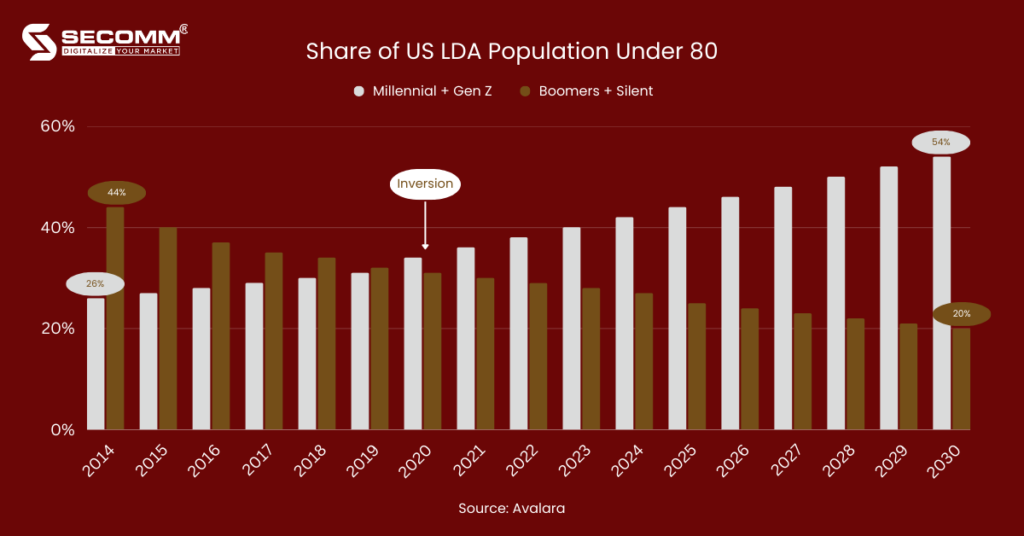
In Vietnam, Millennials (25–38 years old) and Gen Z (18–24 years old), often known as MillennialZ, currently make up 47% of the population or about 45 million people who are of drinking age. The population structure of the MillennialZ generation is expected to keep growing.
The primary factors influencing the growth of the eCommerce sector as well as the digital economy of Vietnam will also be the young people’s awareness of and keeping up with new trends in digital technology compared to previous generations.
The Duty Free Shop Group (DFS) and Changi Airport Group (CAG) collaborated on the iShop Changi Wines eCommerce online project, which offers world-renowned and premium wines and spirits with exclusive discounts to visitors to Changi Airport, particularly those who are CAG members.
The iShop Changi Wines website is cutting-edge and exquisitely styled, showcasing the distinctive qualities of the wine industry as well as the aesthetics from page layout, color, font text, logo, and banner, all of which are guaranteed to optimize the purchasing experience while also, and this is crucial, emphasizing the identity and brand-development elements for both CAG and DFS.
Due to the fact that this is a project of well-known companies, the iShop Changi Wines website has consistently received a lot of traffic, averaging approximately 592 thousand views each month since its introduction.
Therefore, to combat the unexpected surge in traffic and orders during the busiest shopping seasons of the year, the eCommerce system must be continually enhanced and optimized.

The fact that major corporations CAG and DFS both started and developed successful wine eCommerce websites shows the enormous potential of this industry now and in the future.
Previously, the business scope of wine businesses was quite limited, but now that limit has been broken thanks to the dominance of the Internet and the rise of eCommerce.
Moreover, the government’s assistance in lowering legal restrictions has given wine producers the assurance to confidently market their goods to a significant number of potential buyers in several nations across the world.
The Warehouse, established in 2001, is renowned as a top supplier of wines and spirits in Vietnam, offering more than 16 different varieties of wine from numerous nations.
In addition, along with Annam Gourmet Market, Yves Rocher, and Flormar, this is another well-known retail brand of the Nam Group. Before being formally put on the market, products at The Warehouse are consistently inspected and carefully chosen to fulfill quality criteria.
The company has so far increased the reach of its distribution network across the nation, including Ho Chi Minh City, Hanoi, Da Nang, Nha Trang, Hoi An, Quang Ninh, and Phu Quoc.
The Warehouse achieved its objective of serving the wine market with B2B and B2C business models by utilizing the Magento platform.
This implies that the business will broaden the retail channel to include private customers in addition to distributing wines to restaurants, hotels, resorts, pubs, and lounges.
A series of symbols, logos, and banners created especially to fit the characteristics of the wine industry are combined with Bordeaux red to create a website interface that is focused on UI/UX perfection.

The Warehouse is flexible, secure, and has quick ordering, payment, and delivery options. Therefore, customers can place orders through phone, mobile app, or eCommerce website.
Customers can then pick up their purchases from the store or, in major cities like HCM, Hanoi, and Da Nang, the company will deliver them quickly within 2 to 3 hours. In other places, conventional courier delivery takes 2 to 5 days.
The Warehouse has been successful in raising brand recognition, expanding its customer base, and increasing both offline and online sales as a result of the timely growth of its business model and digital transformation
Long-standing Australian company Trentham Estate Winery, founded in 1988, focuses on the manufacture and distribution of wine.
After many years in business, the company is well regarded for its creativity in the wine-making process, which resulted in a variety of wines with different delicious flavors. Also, the brand has received hundreds of medals, titles, and other industry awards.
In the beginning, the business created and ran a WordPress website system for branding purposes.
Trentham Estate, however, has been forced to increase its company scale by making a substantial investment in an entire eCommerce website system due to the growth of eCommerce and the increasingly varied purchasing needs of potential clients.

In the beginning, the business created and ran a WordPress website system for branding purposes. Trentham Estate, however, has been forced to increase its company scale by making a substantial investment in an entire eCommerce website system due to the growth of eCommerce and the increasingly varied purchasing needs of potential clients.
That is what led to the creation of the website trenthamestate.com.au, which has a modern interface while still accurately capturing the distinctive features of the wine industry.
Similar to The Warehouse, Trentham Estate likewise creates an eCommerce website based on the Magento platform with a variety of features that satisfies eCommerce requirements and wine industry specifics.
Therefore, businesses can access and serve a wide range of large customer files not only in Australia and internationally thanks to effective marketing and branding strategies, towards a sustainable business model along with the changes of the digital age.
It would be hard to believe that an industry as sensitive as wine could be traded online so easily and efficiently. In that efficiency and convenience, there is a great contribution of the trend of eCommerce and the comprehensive National Digital Transformation program that is committed to supporting by the Government. This is an extremely appropriate time for wine businesses to confidently deploy eCommerce because of the support from the Government and the push from the market.
However, planning to implementation are two completely different categories. Businesses are required to have a practical strategy and technical assistance from highly skilled firms to hasten the success journey and help advance the National Digital Transformation goal.
SECOMM has many years of expertise in effectively executing eCommerce for numerous customers in various countries. We specialize in offering free consultation services with qualified eCommerce implementation solutions.
Contact us right away for free counsel and assistance.
 2
2
 4,878
4,878
 0
0
 1
1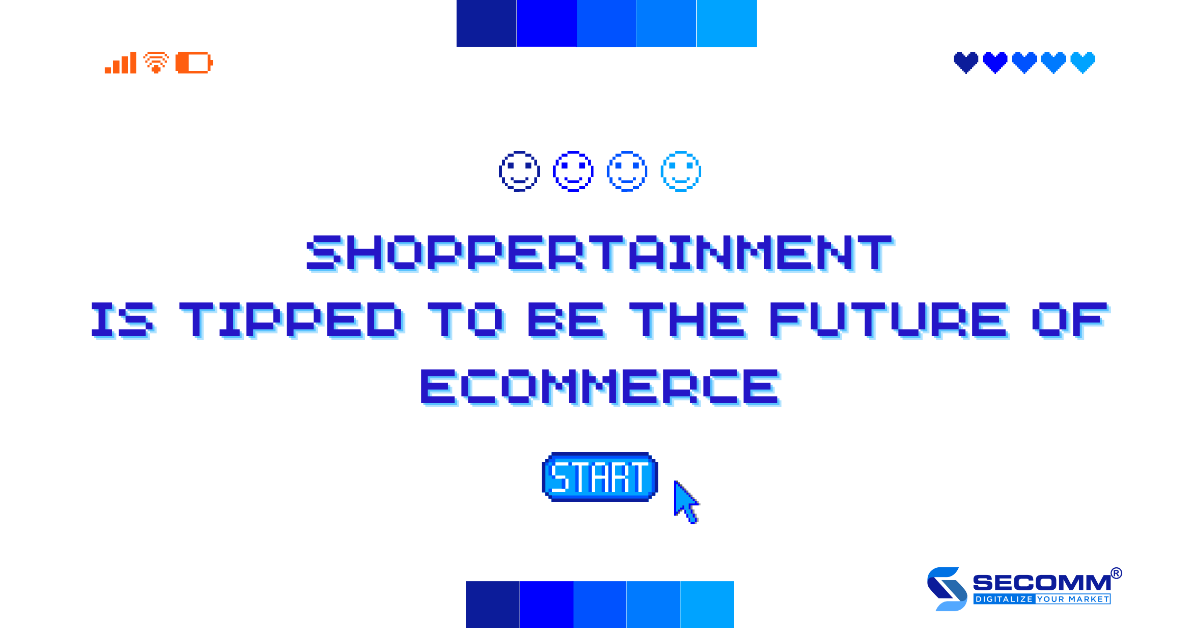
The Covid-19 pandemic not only encourages the tremendous growth of eCommerce but also helps shift consumers’ priorities from in-store to online buying. However, instead of just buying, consumers frequently prefer to seek out novel, inspiring experiences.
Therefore, every company should strive to implement the approach of shopping combined with entertainment (Shoppertainment) in order to improve marketing effectiveness and boost sales.
Shoppertainment is a combination of two elements “shopper/shopping” and “entertainment”.
Shoppertainment is described as “the provision of recreational or leisure facilities within or next to a retail store or shopping center, as part of a marketing strategy, which is designed to attract customers and stimulate purchasing” in the Oxford Dictionary (1990).
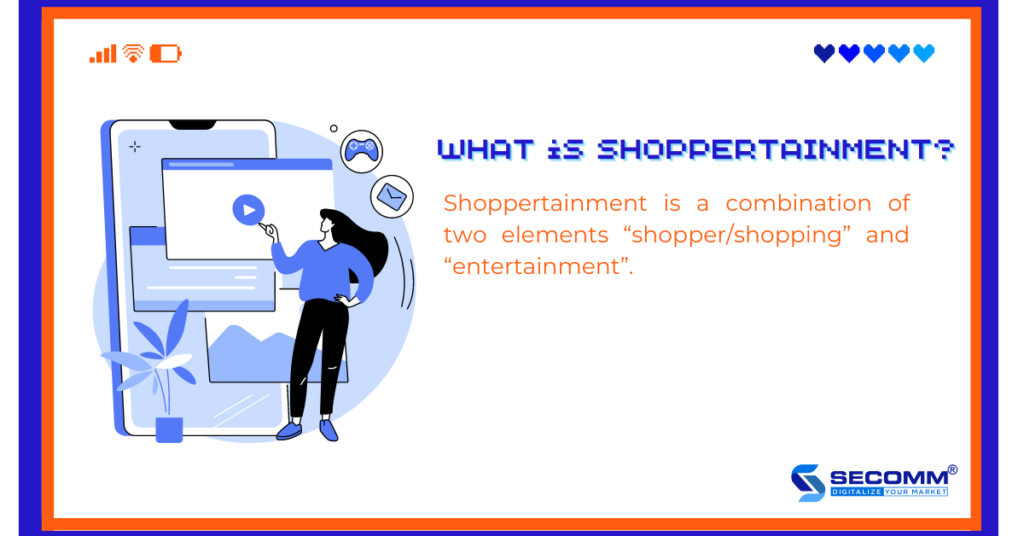
Many companies, notably IKEA, the biggest furniture retailer in the world, have used shoppertainment with success in the past. IKEA launched a campaign in 2019 called “IKEA nightclub – Tonight is to sleep” for 100 lucky individuals.
During this campaign, customers can partake in activities like manicures, massages, snacks, and tea instead of cocktails before spending the night in rooms with IKEA furniture that is soon to be released.
The brand has had remarkable sales success thanks to the campaign’s resonance in North America.
The shoppertainment trend, however, is no longer just restricted to stores or other physical locations thanks to the growth of eCommerce and digital marketing but has instead gained popularity and taken over online shopping activities.
In comparison to the prior definition, shoppertainment has been enlarged and changed. Shoppertainment is a trend that combines online shopping with entertainment, allowing buyers to engage with merchants in addition to purchasing products as usual.
In Vietnam and in the Asia-Pacific region, certain forms of entertainment-infused shopping are very common. Examples include live streaming, shoppable videos, and gamification.
According to the Vietnam eCommerce White Paper 2022, the size of the retail eCommerce market in Vietnam will increase from $11.8 billion in 2020 to $13.7 billion in 2021 and is estimated to reach 16.4 billion USD in 2022.
Meanwhile, the percentage of consumers shopping online on eCommerce websites is 78% in 2021, up 4% over the same period last year.
Because of the urgency, lack of options, and social isolation, the effects of the epidemic have actually contributed to a change in consumption tendencies from in-person purchases to online purchases.
Since that time, it has seen the quick decline of the conventional commerce model and the rise of eCommerce. By 2026, Statista projects that eCommerce sales will total $8.1 trillion.
Additionally, it is not surprising that consumers like shoppertainment. Although this combination is not novel, it promises to set the consumption trend in the years to come as eCommerce takes center stage.
The demand for online shopping will be higher there, and expectations for the best shopping experience—including both online shopping and fascinating experiences will also be higher.
Retail businesses around the world have seen a significant rise in sales during the outbreak by combining online shopping with live streams, entertainment videos, and video games to create real-time digital interactions with customers.
For instance, Taobao Live, which Alibaba introduced in 2016, saw a 150% surge in sales in 2020 when the epidemic first appeared in China.
“Shoppertainment is now a basic expectation. You really have to leverage engaging tools so the shopper gets to learn about the product, its superiority, and has fun along the way,” notes Alex Vogler, senior director and head of marketing, eBusiness, Procter & Gamble (P&G) Asia, Middle East, and Africa.
The Covid-19 pandemic has had a significant negative impact on the human psyche, causing issues including depression and anxiety. On the other hand, a portion of the populace said that the social connections they were unable to have prior to the epidemic significantly improved their psychological well-being.
People need to connect with the community and others like them more than just for amusement. Brands have therefore concentrated on improving the consumer experience by transforming personal experiences into shared ones that bring communities together.
As an example, consider the hashtag #TikTokMadeMeBuyIt. Through the TikTok platform, users can easily and amusingly share their shopping experiences, resulting in videos going viral and receiving more than 4.5 billion views.
Shoppertainment will result in emotional and impulsive purchasing decisions since it emphasizes entertainment and connection. According to a recent TikTok research:

The studies mentioned above demonstrated the enormous influence that social networks and online shopping trends have on consumer decisions.
Because of this, Vietnamese retail companies have prioritized shoppertainment in their marketing plans.
Customers demand a more social and engaging online shopping experience, as well as the ability to connect and converse with one another while buying, which is the reason for any of this.
In recent years, both buyers and sellers in the Asia-Pacific (APAC) area have grown accustomed to live selling. Live selling is less common in the US and Europe than it is in APAC, but businesses there are nonetheless keeping an eye on this trend.
For instance, AliExpress initially introduced the live selling feature in France in May 2020, and since then, more than 3,000 live programs have been launched, with the involvement of more than 100 vendors.
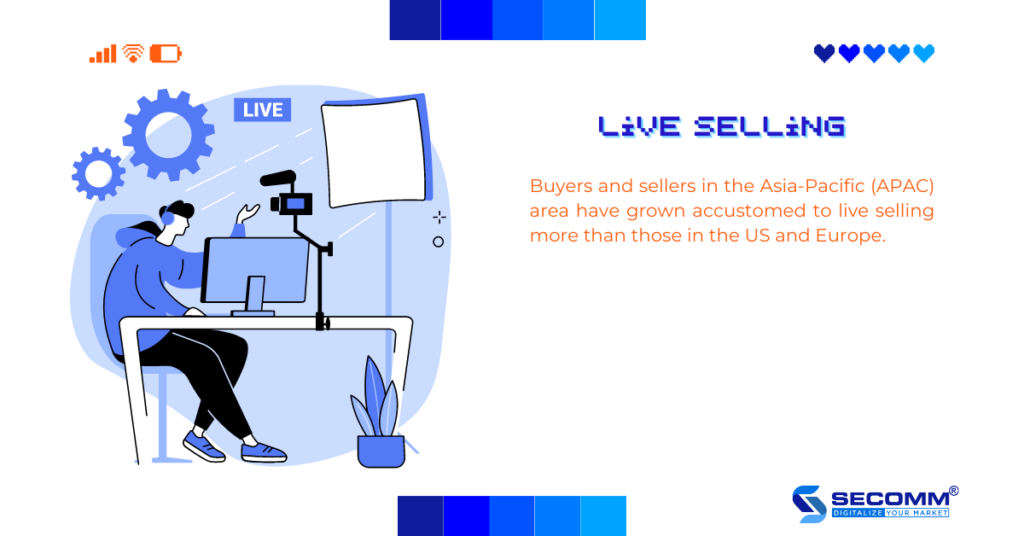
The combination of sales, interaction, and entertainment makes this one of the top social selling strategies. Customers can interact with vendors directly, view actual product photos, and make decisions by pushing their shopping emotions.
Plus, the engaging social interactions that take place throughout live streaming help retailers make an impact on customers, resulting in a high return rate.
Due to the growth of the Shoppertainment trend and the effectiveness of live streaming in generating sales through social networks, eCommerce marketplaces have started to put more of an emphasis on investing in producing engaging entertainment material for users on their apps, particularly through live streaming.
The customer buying experience is improved by several well-known live stream channels, like TaobaoLive, LazLive, Shopee Live, TikiLive, etc.
These companies have the resources to develop this feature for themselves, but lower-budgeted companies can still try the live-selling concept by integrating Facebook or YouTube live stream with an eCommerce website.
Live-streaming videos will be effectively replaced by shoppable videos. One of the joys of using this type of video is that companies may produce videos in their own distinctive styles that quickly introduce customers to their products, explain how they operate, and demonstrate how to use them. These videos can be attached to an eCommerce website. Users can always click the product link in this kind of short video to find out extra details or to make a purchase. The short-form video has overtaken popular platforms like TikTok, Instagram Reels, and Youtube Shorts as the go-to method for branding, cultivating customer trust, and influencing purchasing decisions.
83% of people, according to Nielsen study, prefer watching videos of advertisements to GIFs or text. Short-form videos have gained popularity as a result of global digital transformation and consumer preference, and many brands now opt to use those as part of their video marketing strategies due to their useful advantages, which include the following:

Gamification or Gamification Marketing is the skillful incorporation of a video game’s mechanics into promotional operations in a unique and impressive method to meet marketing objectives.
Gamification’s primary advantage, similar to live selling, is engagement, which keeps people on the site, drives conversions, and boosts sales.
Users are actually more likely to return for more shopping if a business can convince them that engaging with it is an interesting experience rather than a transaction.
A study by Bazaar Voice demonstrates the impact of gamification on businesses’ marketing strategies as follows:
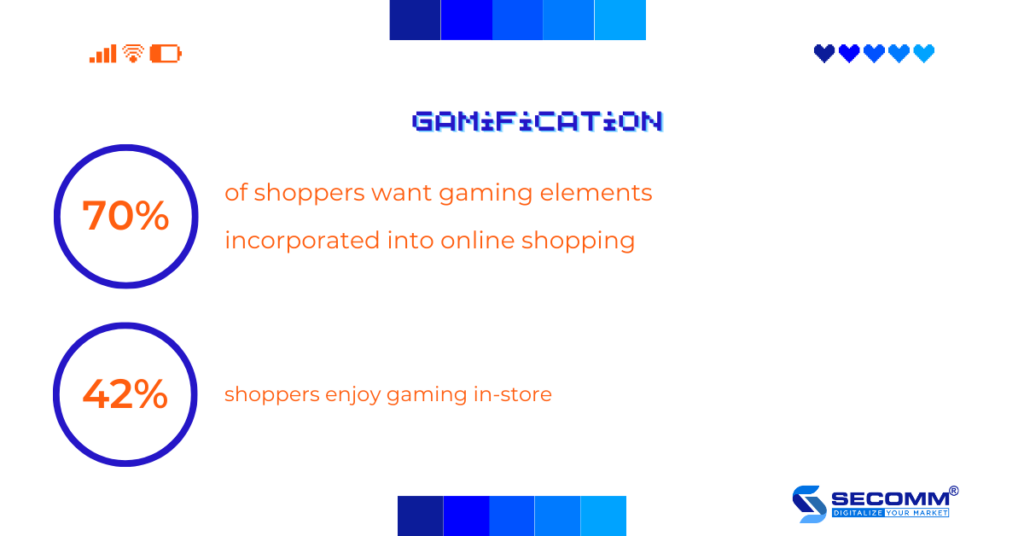
For instance, take Bajaj Finserv’s Indian financial company’s Gamification Marketing campaign. The game was created by this firm to encourage people to use its travel loan services.
Users will complete tasks and respond to questions about their preferred travel destinations. Customers adored the campaign, and it immediately trended on Twitter with more than 75 million impressions.
Thus demonstrating Bajaj Finserv’s efforts to develop engaging experiences and provide them to customers in line with its marketing strategy. Brands attract more potential customers, enjoy the better engagement, and increase conversions as a result of the viral impact.
Shoppertainment has been around for a while, but it wasn’t until Covid-19’s effect that this trend truly took off. Businesses should take advantage of this trend to improve the online shopping experience for customers and increase sales in the era of eCommerce.
Due to the growing demands of customers for a better shopping experience and the ongoing changes in the market, achieving this goal is difficult and labor-intensive. As a result, companies must work with expert agencies to plan the proper eCommerce deployment from the start.
With many years of experience in successfully implementing eCommerce for many customers in many countries, SECOMM specializes in providing consulting services with comprehensive and professional eCommerce implementation solutions.
Contact SECOMM today for free support and advice.
 3
3
 6,042
6,042
 0
0
 1
1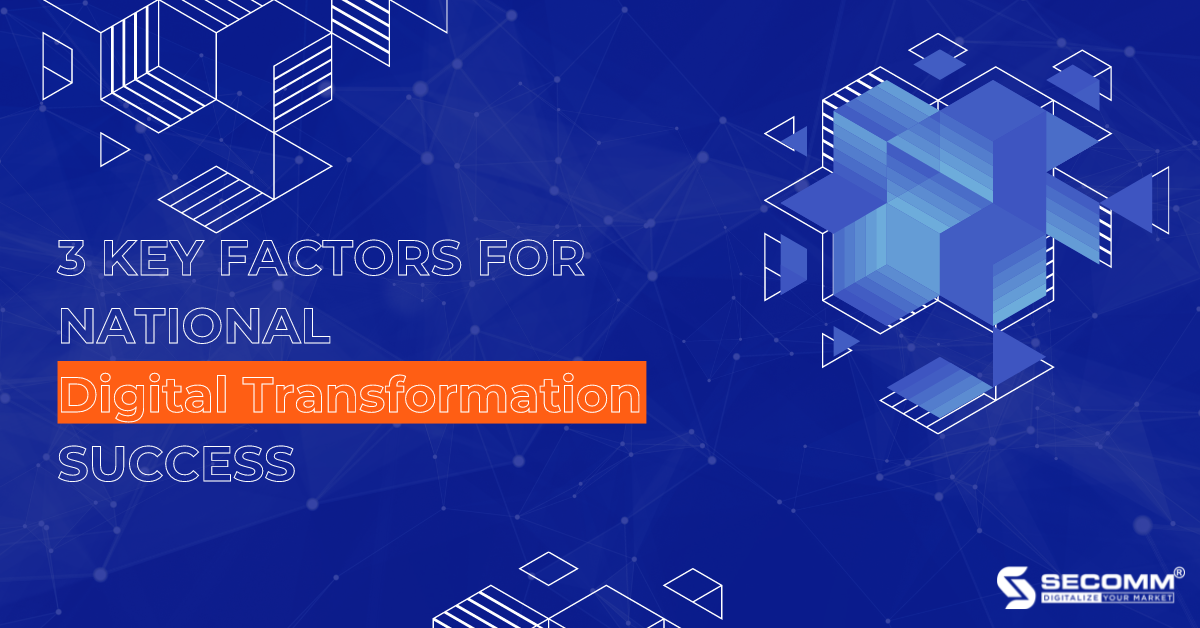
When the Prime Minister approved the “National Digital Transformation Program to 2025, with a vision to 2030,” national digital transformation became formally a goal shared by the entire Vietnamese people in 2020.
Since then, localities, ministries, branches, and even the government have all gradually incorporated the term “Digital Transformation” and applications of digital technology into their everyday activities.
Thus, we all realize the significance and impact of the digital transformation trend. What essential elements, nevertheless, determine the National Digital Transformation Program’s success or failure?
The process of using digital technology to completely alter each person’s lifestyle, each company’s business model, and each nation’s government operations in order to create new values and prospects for future development is referred to as transformation, also known as digital transformation.
Today, all businesses, big and small, have to decide whether to embrace innovation or risk lagging behind, becoming ineffective, and going out of business.
Furthermore, digital transformation involves- not just comprehending and utilizing technology but, more importantly, reinventing the complete business strategy as well as the vision and development priorities of the nation in relation to the global development trend.
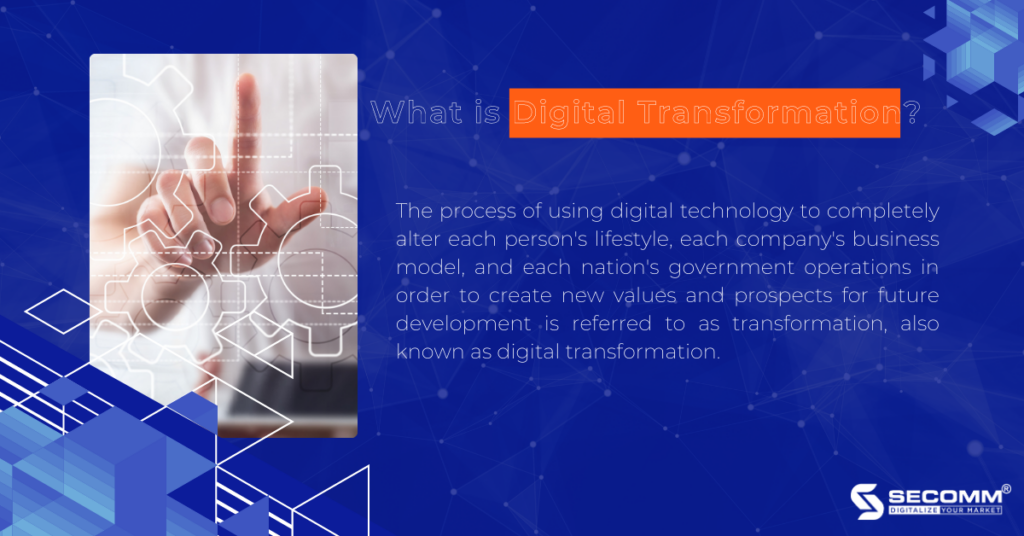
According to data from Mordor Intelligence, the digital transformation age is shining in practically “every nook” of the global economy, confirming that this is not a “soon to fade” trend but rather a new and sustainable development orientation following the pandemic crisis.
In Vietnam alone, the government has established a National Digital Transformation Program for 2025, with a vision to 2030, with particular targets to shorten the distance with other countries around the world, including:
The fact that the goals are stated in great detail in the national digital transformation program with a focus on 2030 demonstrates how seriously the Vietnamese government takes the significance of digital transformation for the prosperous growth of the nation.
Think about the global Industrial Revolution 4.0 wave that is currently in motion. With the aid of connection provided by the Internet of Things (IoT), real-time data access, and the introduction of cyber-physical systems, the Industrial Revolution 4.0, also known as Industry 4.0, primarily focuses on advancing modern digital technology to an entirely new level.
Every Government, organization, corporation, and individual throughout the world must transform its business model, and the manner of working from non-digital to digital operation, in order to keep up with this current technology and immerse itself in the Industry 4.0 wave. The name of this procedure is “digital transformation”.
Vietnam, despite having a minor economy compared to other countries, is a crucial part of the massive Industrial Revolution 4.0 that is currently underway. Vietnam must therefore undergo a digital transformation in order to compete.
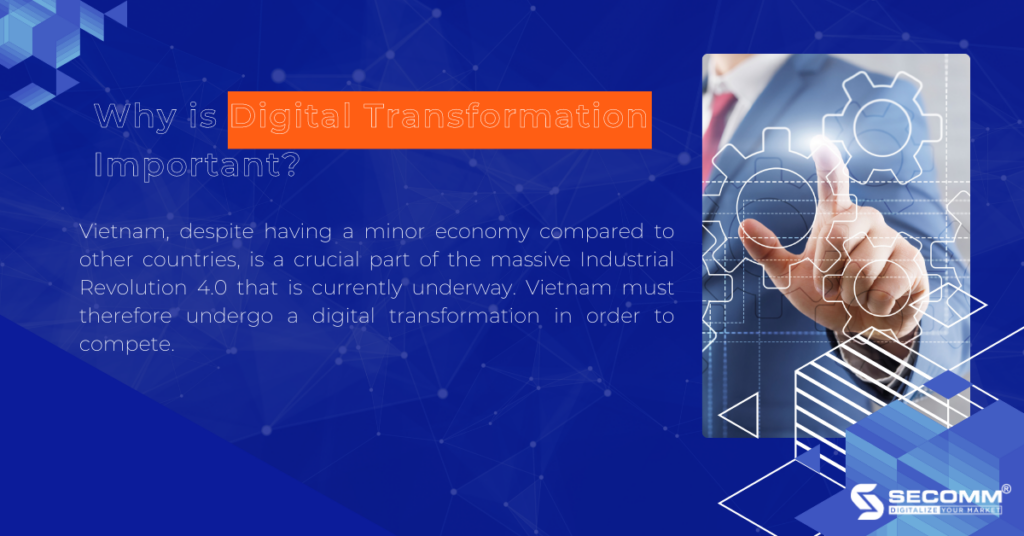
The goal will be challenging to accomplish if just businesses execute digital transformation because the capital and costs are quite high; therefore, businesses require assistance from the government budget and outside finance.
On the other hand, even with a massive budget, it can be challenging for businesses to implement effective digital transformation if the government does not go digital, but continues to run in the old manner, handles administrative procedures slowly, lacks direction, and supports businesses clearly and methodically.
Furthermore, without the support of the people, the National Digital Transformation process to catch up with the global Industry 4.0 wave will be impossible. However, the public needs the government to inform, direct, and inspire digital transformation.
Also, businesses must create useful digital transformation strategies that both before and after implementation considerably raise people’s quality of life.
Vietnam must structure three main areas of digital transformation: the government, businesses, and people, or in other words, the digital government, digital economy, and digital society, if national digital transformation is the outcome it seeks to achieve in order to gradually join the Industrial Revolution 4.0.
These three crucial overlapping and interdependent relationships make up the National Digital Transformation.
Throughout the earlier years, Vinasa reports that in 2019, 40.6% of organizations and businesses confirmed that they have resources available for digital transformation and that 23.6% of them are putting it into practice. However, 30.7% of them are uncertain of what to do despite doing some research, and 38% are unsure of where to begin.
Due to the Prime Minister’s approval of the “National Digital Transformation Program to 2025, with a vision to 2030” and the abrupt change brought on by the impact of the global pandemic, Digital Transformation is now regarded as the process’ starting year. This makes it a top priority to maintain Vietnam’s economy.
The government and Vietnamese enterprises have been able to promote awareness of the importance and urgency of digital transformation in order to help the country overcome the obstacle thanks to the economic crisis brought on by the effects of the Covid-19 outbreak.
According to the UN, Vietnam’s digital government statistics are better than the average for the area. Vietnam specifically saw a rise of 2 places in 2020, moving up to rank 86th out of 193 UN member states globally and 6th out of 11 Southeast Asian nations.
The establishment of the National Digital Transformation Committee and the decision to appoint October 10 of each year as National Digital Transformation Day in accordance with the National Digital Transformation policy for a better life for the people are two additional significant events that will forever be remembered in Vietnam in the years 2021 and 2022.
As a result, leaders and people are more conscious of the significance, function, and advantages of digital transformation, and there are coordinated actions throughout the entire system, from the government to the general populace.
According to data from the Ministry of Information and Communications, the databases that Vietnam has built up to the second quarter of 2022 include:
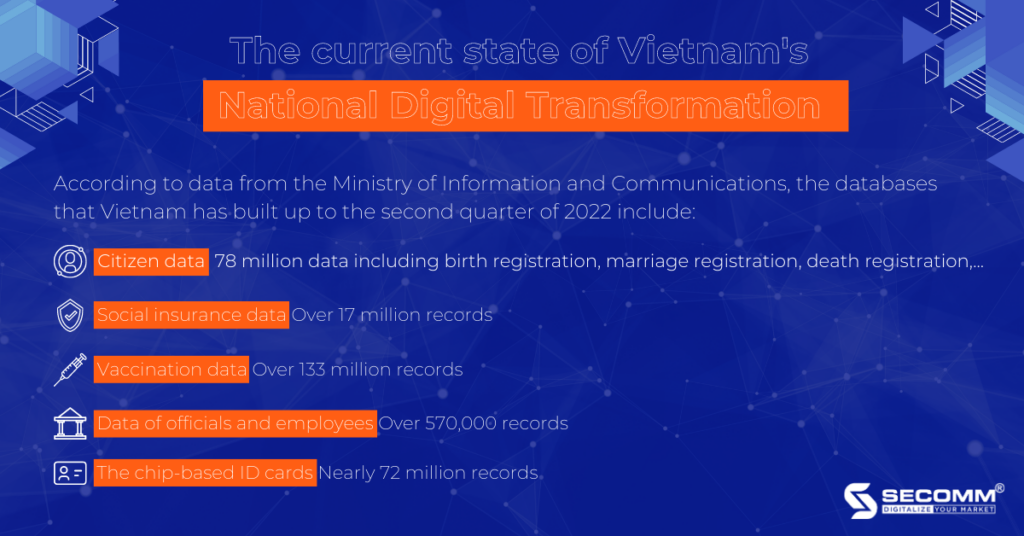
Additionally, the percentage of qualified online public services offered to individuals and enterprises has surpassed 97.3%; the percentage of these services that produce dossiers has gotten to 67.8% and the percentage of administrative procedures handled online has gotten to 43.2%.
Moreover, the economic sector has seen some very good improvements as a result of digital transformation. The Ministry of Information and Communications predicts that by the first quarter of 2022, the value of Vietnam’s digital economy will be 53 billion USD and that there would be 500 more newly founded digital technology businesses than there were at the same point in 2021.
The number of monthly users on Vietnamese mobile digital platforms climbed by more than 100 million compared to the same period in 2021, and the percentage of the digital economy in GDP increased to 10.41% in the first half of the year from 9.6% in the end of 2021.
Based on specific analysis and data on the situation of National Digital Transformation in Vietnam, it is clear that there are 3 main pillars that lay the foundation for the success of the National Digital Transformation process: Digital Government, Digital Economy, and Digital Society.
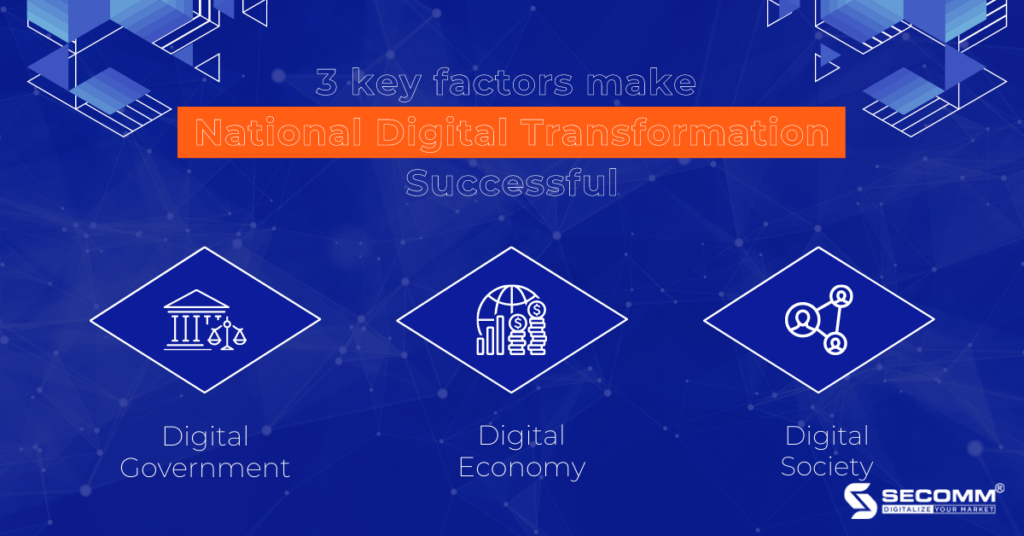
In order to increase operational efficiency and develop new operating models and alter the way services are offered using digital technology and data, a government must transition all of its operations to a digital environment. This allows enterprises to take part in the service delivery process. In other words, this is how the government is becoming digital.
Vietnamese citizens have been instructed in the past to finish the registration processes necessary to access the Citizen Identity Card with a chip, which is gradually replacing the previous ID card. This serves as one illustration of how well the digital government is progressing in Vietnam.
The process of processing dossiers and issuing ID Cards in the early stages is not really effective because the National Database on Civil is still under construction and staff training on how to use digital technology and digitize paper data on the data system is still limited. However, the procedure for issuing chip-based ID cards in addition to the cost is public and transparent.
As a result, when people arrive at the location where the chip-based ID card is made, processing will go more quickly if their information is already in the National Database; otherwise, they will need to provide more birth certificates and household registration information and will have to wait a long time for staff to check, enter data, and complete related procedures.
After that, the chip-based ID card will be sent to the registered address by post, but for the above reason, this process also takes quite a while.
The Public Service Portal of the Ministry of Public Security, however, is currently supported by the government and simply requires people to visit the location to capture pictures and fingerprints.
This demonstrates the government’s prompt responsiveness in streamlining business procedures while also saving time for both citizens and employees. This is evidence of the Government’s ongoing attempts to modernize itself digitally.
In addition, on the CCCD chip, more than 14 information fields of citizens are stored: (1) CCCD number; (2) Full name, other names; (3) Date of birth, month, and year; (4) Gender; (5) Nationality; (6) Ethnicity; (7) Religion; (8) Hometown; (9) Place of permanent residence registration; (10) Identification characteristics; (11) Date of issue; (12) Expiration date;
(13) Full name of parent, spouse; (14) issued 9-digit ID card number; (15) Portrait photos; (16) Features of fingerprint extraction and selection of two index fingers; backup for iris images, and other information.
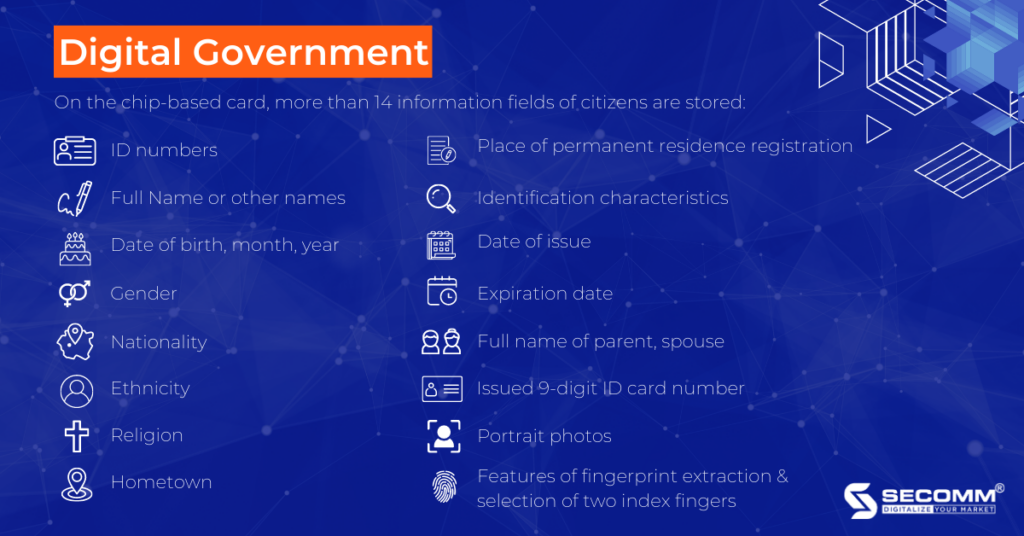
Moreover, a chip-based ID card can replace important papers such as Identity Cards, Health Insurance (HI), Social Insurance (Social Insurance), Birth Certificate, Marriage Certificate, and Household Registration Books….
It is clear that switching from conventional ID cards to chip-based ID cards has several advantages for both the general public and the government. People’s personal information is highly secure, preventing the creation of fake documents.
Also, ID cards with chips make paperwork and transactions straightforward because many pieces of crucial information are combined onto a single card, saving time and preventing the scenario where someone forgets to bring the necessary paperwork and causing the processing of documents to be interrupted.
The government made a wise choice by implementing chip-based ID cards.
The government can save, control, and check information about a specific individual quickly and efficiently with the use of chip-based ID cards and the National Database, helping to effectively control the situation of local security and order as well as national security.
Also, this helps free up labor for government employees who deal with people, handle paperwork, and maintain correctness, speed, and synchronization.
The second factor that makes the success of the National Digital Transformation process is the Digital Economy.
Digital Economy is an economy that maintains and develops constantly based on modern digital technology. The digital economy is also known as the Internet Economy, the New Economy, or the Web Economy. This particular economy is made up of electronic transactions over the internet.
According to the definition from the Vietnam Private Economic Forum, the digital economy is all economic activities based on digital platforms. Digital economy development is the use of digital technology and data to create a new model of cooperation and business, in line with the development trend of modern technology.
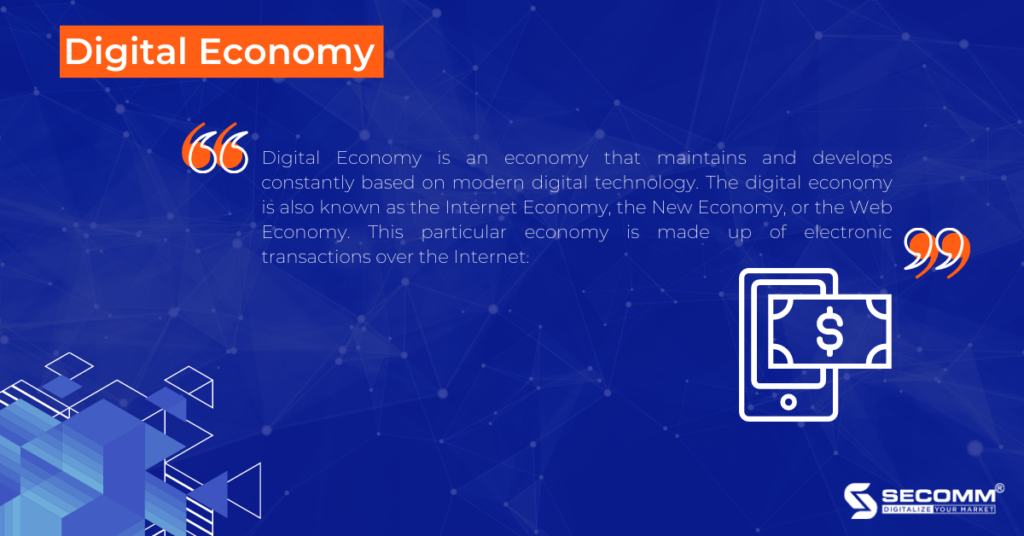
Therefore, everyone would immediately think of eCommerce when discussing the digital economy or the most prominent business model of the trend of digital transformation, and the strong push that this industry provides for high-volume industries catches the trend of digital transformation.
Few people anticipate that the conventional market model, which has become ingrained in Vietnamese culture, would soon be replaced by the market model 4.0, which accepts cashless payments. In several of Hai Phong’s traditional markets, this novel method of buying and selling was introduced for the first time, to the delight of the locals.
The Viettel Money application of Viettel Military Telecom Group, a pioneer in the digital transformation of market 4.0 models in 63 provinces/cities, enables all small businesses and individuals to purchase and sell things at the market by scanning QR codes or transferring money via phone number.
Moreover, cashless payment makes it easier for customers to shop at the market without worrying about issues like carrying change or budgeting extra cash for purchases. Also, many shopkeepers in the market are afraid of this issue pretty much.
Previously, if customers paid in cash with a denomination that was too big, shopkeepers would have to run everywhere to change money, causing time-consuming for both parties and other customers waiting to be served, the issue is now solved with just one smartphone.
Following the success of Hai Phong’s 4.0 market model, many other localities have also implemented this model and received positive feedback signals from the people such as Da Nang, Quang Ninh, Thai Nguyen, Lang Son, etc.
The market 4.0 model has spread to every nook and cranny of the nation’s small trading places, including farmers’ markets, grocery stores, sidewalk shops, amusement parks, parking lots, and more.
The digital transformation trend has quickly extended to places where it was previously impossible, helping to advance the digital economy and achieve the objective of a comprehensive national digital transformation.
Finally, the term “digital society” refers to all human activities in a broad sense. Digital technology, which is based on the exponential growth of information and data, is the primary driver behind digital society.
It transforms all facets of social structure, from the government and business to the individual. In a limited sense, “digital society” refers to both digital citizenship and digital culture.
From this perspective, the three pillars of a digital nation are the digital society, the digital government, and the digital economy.
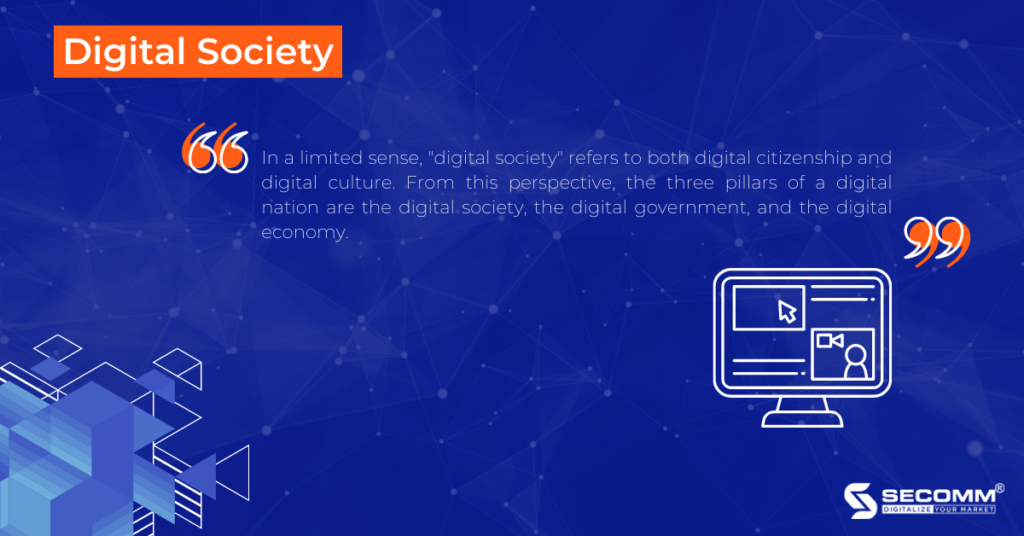
Teachers, parents, and students all adore the eLearning model, which is developing into a popular teaching and learning trend, especially in light of the recent pandemic and widespread implementation of social distancing policies.
Students can access lessons at any time, studying at home, using simply an electronic device with an Internet connection. As a result, teachings can be discussed and interacted with by professors and students without them having to actually meet.
This model also supports student doing teamwork well because it is not time- or space-constrained, saving on travel expenses in addition to using many other helpful resources.
However, for eLearning to really replace traditional teaching and learning methods, it takes a lot of effort from both the Government, the school system, and the student’s parents.
In fact, eLearning is only a small part of the digital society effort besides many other important aspects of society that need to be digitally transformed to make life more convenient for people.
National Digital Transformation has become one of Vietnam’s top goals and this is also a rare project that has received special attention from the highest levels of leadership and international support. Since then, Vietnam has had a full foundation to hope to realize the goal of becoming a digital country from now to 2030.
The development of a digital society, economy, and government, in particular, is a necessary and sufficient condition for a successful national digital transformation.
In fact, every citizen, from intellectuals to regular citizens, is gradually demonstrating a certain understanding in their own way about the digital transformation and awareness that the country is in a transition period to match the general development trend of the times.
This is in addition to the efforts of businesses and the support from the government.
Especially for businesses, digital transformation is an imperative remedy to withstands to withstand the tsunami of eradication brought on by the pandemic’s rapid shift in new business patterns.
Following Covid-19, business digital transformation flowed slowly, gently, and steadily, assisting the economy’s continued rotation.
The first step of the digital transformation journey for businesses is to start implementing eCommerce.
With many years of experience in successfully implementing eCommerce for many customers in many countries, SECOMM specializes in providing consulting services with comprehensive and professional eCommerce implementation solutions.
Contact SECOMM today for free support and advice.
 2
2
 4,143
4,143
 0
0
 1
1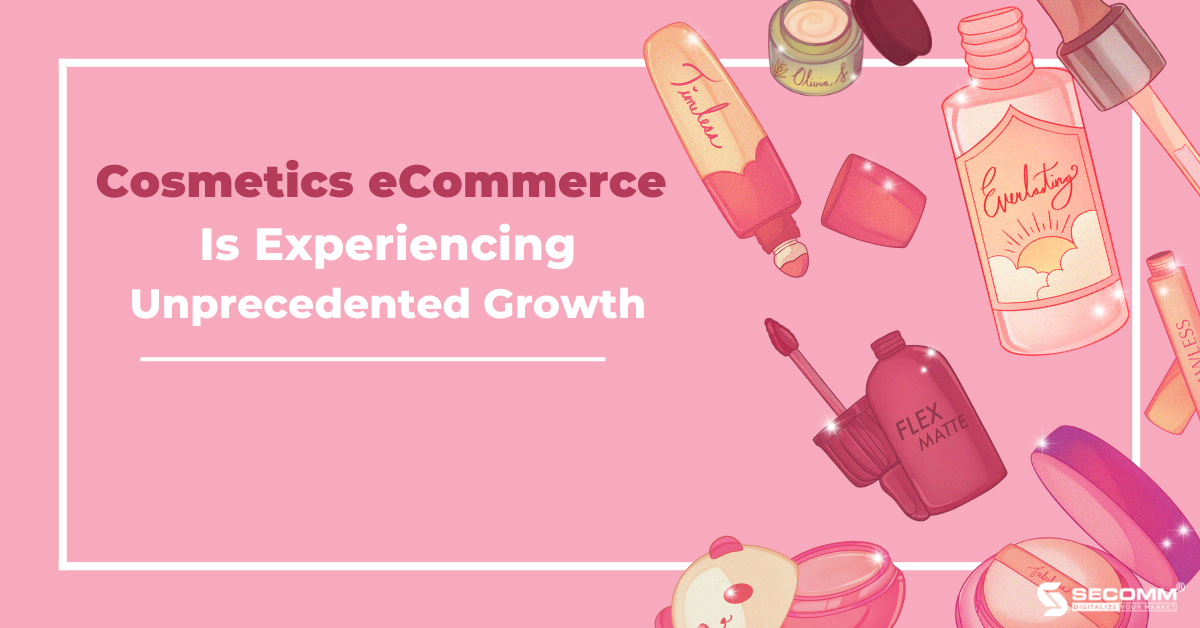
Consumer demand for beauty and health care is rising as the quality of life gradually improves. The fact that so many individuals are involved in commerce has also contributed to the cosmetics industry’s reputation as one of the most important sectors in the modern economy.
Additionally, the rapid growth of eCommerce following the pandemic is gradually emerging as a successful business strategy and a crucial step in the digital transformation of every industry, including the cosmetics industry.
The market size for cosmetics sold online is estimated by CommonThread to be $483 billion in 2020 and expand to $511 billion in 2021 at a compound annual growth rate (CAGR) of 4.75%. The market size is anticipated to surpass 716 billion USD by 2025 and reach 784.6 billion USD by 2027.
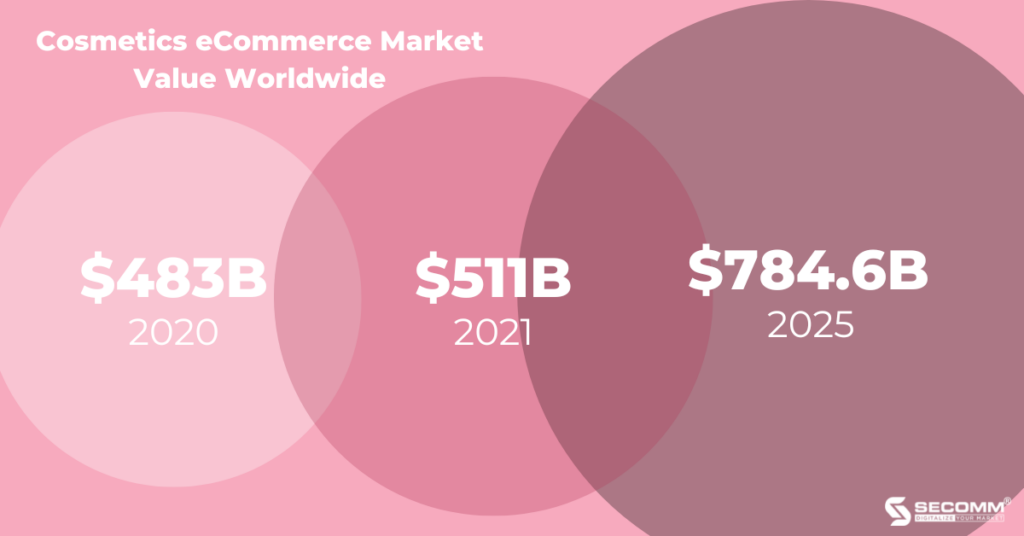
In the past pandemic years, the global economy has witnessed a sudden decline in sales in many industries, including the cosmetics industry.
People are compelled to reduce their social interactions while social distancing mechanisms are in effect.
At this time, people’s psychology will be more concerned with keeping an eye on and caring for themselves. Due to the unpredictable changes of the pandemic, there has been a sharp rise in the need for skincare, hair care, and body care products to enhance spiritual life.

Due to restrictions on leaving the house, online shopping at the time had become not only a need but also an urgent method of purchasing in place of in-person purchases. That serves as a springboard for eCommerce to take off and spur significant growth in other industries like fashion, grocery, wine, and even cosmetics.
These two elements highlight the enormous potential of this “cake,” assisting several cosmetic companies in realizing and swiftly implementing eCommerce for both sustainable development and market revolution.
Using eCommerce as a solution will allow the cosmetics industry to shift from offline to online (O2O) business models rather than allowing their businesses to “get lost” in the crisis of the global pandemic.
Additionally, if businesses still do not have a competent eCommerce website to introduce and sell products to customers who love to shop online in the age of digital transformation, they will quickly lose many potential customers to rivals.

This is especially true for a highly competitive industry like cosmetics, but several firms, including Hasaki, LixiBox, Watsons, Guardian, etc., have embraced the trend early and are now the market leaders in cosmetic eCommerce.
Furthermore, early eCommerce development will also provide benefits that will make marketing efforts more successful, broadening the economic opportunities for businesses.
Businesses must consider customers’ purchasing experiences when launching eCommerce websites, and not just for the cosmetic industry.
Thanks to the use of contemporary technologies, which are quite popular in the cosmetics industry, the purchasing procedure will be swift, and effective, and bring customers satisfaction when they choose to buy cosmetics online.
For example, a 360-degree intuitive vision, virtual reality (VR), or augmented reality (AR) technology (AR).

eCommerce enables businesses to quickly and effortlessly tailor the experience for customers by gathering, evaluating, and synthesizing the consumption behavior of each target group. Typically, this is done with the capabilities listed below: Products have seen, similar product recommendations, etc.
eCommerce provides clients with a seamless experience in addition to an intuitive one across a variety of channels, including social networks (Facebook, Instagram, Tiktok, Zalo, etc.), eCommerce platforms (Shopee, Lazada, Tiki, Sendo, etc.), eCommerce websites, mobile apps, etc.
One of the most successful cosmetic brands that has a significant global media impact is Kylie Cosmetics. When it comes to Kylie Cosmetics, it’s tough not to give Kylie Jenner credit.
She’s the youngest female millionaire in the US and has been hailed as a business genius by prominent publications like Forbes due to her success in the saturated cosmetics industry.
When Kylie Cosmetics was founded in 2015, it generated an astonishing $ 420 million in revenue in its first 18 months. It is predicted that by 2022, net sales will have reached $ 1 billion.
The sensible business strategy, in addition to the founder’s reputation, focuses on utilizing the “gold mine” of eCommerce and launching social media marketing campaigns, which are the factors that contribute to that respectable revenue block.
As a result, the company used Shopify, a platform that specializes in creating websites for the top online retailers in North America, to develop its eCommerce website.
With pink and white as its primary colors, the website’s design is incredibly clean and uncomplicated. The layout of the website centers on showcasing the company’s products.
Also, this is a part of Kylie Cosmetics’ business strategy, which includes releasing collections of cosmetic products like lipsticks, eyeshadow, and eyebrow pencils with limited design and manufacturing to appeal to customers’ FOMO (Fear of Missing Out).
It is not surprising that Kylie’s new collections or cosmetics Cosmetics are continually “sold out” every time it is published because this is thought to be a very intelligent strategy of Kylie Cosmetics, completely different from other well-known cosmetic firms.

The business also utilizes social media platforms that are hugely popular in the US, like Instagram, Youtube, and Snapchat, to create content to market brands and products and engage with a huge audience across three platforms before driving traffic to the eCommerce website and generating conversions.
The company’s inventiveness and innovation are also on display in offline events that draw customers to free product samples. Here, the company wins over even customers who have reservations about the product’s quality, which greatly increases sales.
Since Kylie Cosmetics established its first traditional cosmetic retail store in 2018, customers may now purchase cosmetics from this cult brand at Ulta Beauty locations around the US.
Indeed, Kylie Cosmetics started off quite shrewdly and went on to tremendous success by keeping up with market changes by building an online business model at first, that is, selling through an eCommerce website and relying primarily on social media for promotion.
Since entering the Vietnamese market in 2011, Guardian has grown to be a very well-known and recognizable brand among consumers of cosmetics. This brand is a part of the Dairy Farm Group, a company that manufactures and distributes health and beauty products in Asia.
Since its start, Guardian has made ongoing improvements to encourage millions of followers to lead healthy lifestyles and offer a trustworthy, high-quality purchasing experience at the finest rates and services.
With a system of more than 100 outlets “encompassing everywhere,” this retail chain is delighted to be a place to shop for cosmetics “for everyone” who can “purchase everything” and simply select appropriate items.
A clever business strategy and significant investment in successful marketing efforts are the only explanations needed to understand Guardian’s success.
When first entering the Vietnamese market, Guardian specifically pushed to quickly expand its business chain, focusing on cities with high purchasing power, with 80% of stores located in Ho Chi Minh City, the rest in Hanoi and some other major cities such as Da Nang, Can Tho, Bien Hoa, and Vung Tau.
Because at the time, online channels were not really well-known and powerful enough for this business to keep an eye on.
As a result, the company successfully raises the level of brand recognition with extensive coverage from the Guardian orange white wave, taking into account the characteristics of the cosmetics and beauty care industry, which require customers to have a direct point of contact, learn from, and test.
By 2019, the company began its journey toward digital transformation by combining offline and online (O2O) business models in parallel, and simultaneously, deploying Omnichannel.

It is even more critical for Guardian to immediately implement potential sales channels like marketplaces, applications, fast delivery services like GrabMart, and eCommerce website operate side by side with a chain of 105 retail outlets in strategic locations due to the pandemic’s dual effects, which include changing market trends and altering consumer buying habits.
The orange and white colors and quick page loads make the Guardian website’s design stunning. Additionally, Guardian offers enticing incentives in the shipping policy, such as free fast delivery within 4 hours with orders from 349,000 VND, to encourage online shoppers.
The company’s unique product catalog, which is prominently shown on Guardian’s eCommerce website and features items like shampoos, shower gels, and hand sanitizers, is another standout.
The foundation for helping Guardian dominate the cosmetic retail market and leave a lasting impact on customers is a deliberate investment in developing a multi-channel ecosystem.
Modernity and growth come with invisible pressures that have an impact on everyone’s life as people struggle to keep up with the “standards” of the times.
However, that does not result in a drop in the demand for beauty and self-care, on the contrary, it is always rising, with a diversity of sufficient options to match customer expectations.
Vietnamese women are among the most beautiful in Asia, but, due to the responsibilities of work pressure and family, they occasionally neglect to care for and love themselves.
Because of this, Hasaki Beauty & Clinic was established with the desire to become a reliable beauty and spiritual care destination for Vietnamese women.
The Hasaki store system, which was introduced in 2016 and now has 76 locations across 29 Vietnamese provinces and cities, has steadily established itself as one of the top retail chains for real cosmetics. Hasaki is dedicated to offering real cosmetics at discounted pricing, living up to its motto of “True Quality – True Value”.
Along with system expansion, Hasaki also works on creating an eCommerce website with features appropriate for the cosmetics industry and always enhancing and upgrading the system to provide customers with the greatest online shopping experience.

The Magento platform was used to build the website, and the interface is attractive with green serving as the primary color tone for the entire eCommerce website and app system. Customers can check current promotions and conveniently look up order details when accessing the Hasaki website.
Additionally, the “handbook” section at Hasaki has a wealth of knowledge on cosmetics and skin care tips that each customer may learn and arm themselves with before making a purchase decision. Since then, the process of beauty restoration is safe and effective.
Similar to Guardian, Hasaki encourages people to order online with NowFree 2h and take advantage of free shipping rules.
As a result, Hasaki will provide free delivery to customers within two hours of receiving orders of 90,000 VND in 29 provinces and cities where the company has locations, including on Saturday and Sunday. Customers will benefit from free national shipping on orders that are at least 249,000 VND.
Therefore, Hasaki has sparked a “green craze” among many beauty fans and is now gradually competing with the country’s top cosmetics brands thanks to its quick recognition of market trends and broad perspective with an efficient marketing mix strategy.
It is clear that the growth of the furniture market has been hastened by the speed at which eCommerce is developing.
Today, numerous local and international cosmetics companies participate in and offer the greatest shopping experiences to customers through the effective implementation of an eCommerce website, including Kylie Cosmetics (USA), Guardian, and Hasaki (Vietnam).
From there, companies may quickly connect with a wider pool of Internet users and generate conversions through efficient marketing strategies.
However, business leaders need to carefully and comprehensively take into account the growing customer expectations and rapidly shifting market trends, not to mention specifically describe a systematic and precise business strategy for taking the most advantageous actions in the short and long term.
Completing that difficult task will take a lot of time and resources. As a result, many cosmetics companies opt for a more straightforward approach to the issue, enlisting the assistance of a highly qualified and dependable unit.
SECOMM has many years of expertise in effectively executing eCommerce for numerous customers in various countries. We specialize in offering free consultation services with qualified eCommerce implementation solutions.
Contact us right away for free counsel and assistance.
 2
2
 5,051
5,051
 0
0
 1
1
Exporting and trading internationally has become challenging due to the Covid-19 epidemic. In order to increase sales and find online customers, numerous companies in several industries, including the cosmetics industry, have used eCommerce.
Additionally, to support eCommerce activities and achieve the objective of growth and scalability, cosmetic retailers shift from traditional business practices to keep up with the general development trend of the global economy.
In Vietnam alone, a handful of cosmetic firms in Vietnam have demonstrated extraordinary flexibility and agility in reacting to market adjustments “despite” the complicated changes brought on by the global pandemic.
The following brands have gained the trust of and made a lasting impression on cosmetic customers by creating professional and insightful eCommerce websites.
Hasaki, a company founded in April 2016 to provide full health and beauty care for Vietnamese people, has developed secure and quick online shopping experiences with a choice of high-quality cosmetic items from many of the world’s leading brands in today’s market.
Hasaki’s eCommerce website was invested in and methodically developed from the start with the open-source platform – Magento – in order to deliver clients satisfaction in terms of comfort and efficiency when purchasing online.
More than 7 million visitors per month of traffic at a very high level demonstrate the wisdom of Hasaki’s eCommerce investment. This company’s expansion of its distribution network increased market penetration, and identification and diversification of the target customer were all made possible by sensible strategy.

The Gioi Skin Food is another well-known eCommerce site with over 2 million monthly visitors that focuses on selling cosmetics. This business worked with Haravan to create an effective eCommerce website with an easy-to-use interface.
The Gioi Skin Food has up now employed eCommerce in addition to the conventional retail shop method, which has been incredibly successful. This would enable the business to catch up with the online-to-offline (O2O) trend and raise brand awareness and revenue.

The Watsons Group, Asia’s top retail organization for health and beauty products, owns the Watsons Vietnam brand. The company desires to provide Vietnamese customers with the finest shopping experience possible while also bringing them high-quality products that are appropriate for their needs.
Notably, Watsons adopted the O2O business model right away after entering the Vietnamese market. With the goal of dominating the market, Watsons Vietnam invests in developing an eCommerce website with SAP Commerce Cloud in addition to the store system dispersed throughout the neighbourhoods of Ho Chi Minh City.
Additionally, the user-friendly and aesthetically designed interface contributes to the website’s amazing monthly visitation of more than 1 million.

The Gioi Son Moi is one of the places where people go to get lipstick that is well-known and reputable because of the guaranteed product quality and the courteousness of the staff. Every day, new products are added to the site, ensuring that there is always enough supply of well-known companies’ lipstick lines in the right hues at competitive rates.
The Gioi Son Moi also swiftly launched an eCommerce website to join the common playground of the cosmetic retail sector, in addition to two physical locations in HCMC that are constantly being renovated, extending the amount of shopping space. As a result, the website is built on the Haravan platform and has a straightforward interface that is nonetheless opulent and complex.
Also, the extremely high monthly traffic volume (more than 1 million) also demonstrates the company’s successful business strategy in the context of the market’s innovation trend.

Beauty lovers in HCMC can’t help but be aware of Bo Shop, a company that provides a broad range of high-quality cosmetics, from skincare to makeup, at rates that are specifically stated to fulfil customers’ demands for all types of beauty care.
The company quickly creates an eCommerce website using WooCommerce to keep up with contemporary business trends in order to become the top cosmetic retail brand in Vietnam.

For many years, Vietnamese consumers of cosmetics have been familiar with the name Guardian. This is a brand from the Dairy Farm Group that manufactures and distributes well-known health and beauty care goods all over Asia. In Vietnam, where Guardian first opened in 2011, the company now has more than 100 outlets.
In 2019, the business started its transformational path and parallel fusion of offline and internet business models. In order to create an omnichannel sales network (Omnichannel), Guardian focuses on building eCommerce websites with Shopify in addition to deploying potential sales channels like eCommerce platforms, apps, and fast delivery channels via GrabMart.
This gives customers more affordable, quick, and convenient home shopping options. After only a short period of time in operation, the Guardian website has attracted close to 1 million visitors each month.
Guardian has risen to the top of the industry and evolved into the biggest and most prominent retail chain for health and beauty products in existence today thanks to a significant investment in developing a multi-channel ecosystem.

Since Lam Thao Cosmetics’ formal opening in 2017, young people have come to love it as one of their favourite cosmetic shops. Lam Thao Cosmetics is continually upgrading its product line with the most affordable rates in an effort to give customers more options with the trendiest goods and improve their experience.
Along with offering high-quality goods, Lam Thao also runs an eCommerce site on the Haravan platform to enhance clients’ offline and online purchasing experiences. The success of eCommerce implementation has also helped Lam Thao Cosmetics reach a significant number of online prospects, boosting both sales and brand recognition.

For those who love cosmetics, Nuty Cosmetics is regarded as a cosmetics heaven. After operating and growing for more than ten years amid market ups and downs, the business is still a renowned source for real beauty products from well-known manufacturers in the US, Germany, France, Japan, and Korea.
The WooCommerce platform was used to create Nuty Cosmetics’ website, which has an easy-to-use interface and exceptional features that may satisfy clients when they shop online. Additionally, Nuty Cosmetics’ website offers thorough information about each product, along with clearly stated costs.
Because of this, despite the fact that there are only roughly 200,000 visitors per month on the site currently, Nuty Cosmetics has the potential to become a major player in the cosmetics industry with the correct efforts and attitude.

In the midst of the Covid-19 outbreak that was raging in 2020, AB Beauty World (ABBW) was founded with the goal of being the top family-friendly cosmetics retailer in Vietnam. The brand has not given up despite the fact that this birth appears to have occurred at the wrong time.
In fact, AB Beauty World has grown and expanded with approximately 20 branches spread throughout the city’s districts in just two years since opening the first store in HCMC, concentrating on growing eCommerce, thanks to the timely redirection.
The WooCommerce-powered cosmetics website for AB Beauty World features an interface and capabilities tailored to the sector. The website has already seen more than 150,000 visitors in the short time since it launched, which is nonetheless viewed favourably for a newcomer to the fight for digital transformation.

Beauty Garden is one of the top retail and distribution brands for real cosmetics today. Since its establishment in 2014, the company has effectively extended its retail network to be present in numerous provinces and major and minor towns throughout the nation, including Hanoi, Da Nang, Ho Chi Minh City, Dak Lak, Gia Lai, Dong Nai, and Can Tho.
In addition, Beauty Garden concentrates on developing eCommerce websites in the context of economic integration. As a result, the company’s website is expertly and systematically constructed using WooCommerce, the most popular eCommerce development platform worldwide, and is ideal for the cosmetics business.
The eCommerce implementation of Beauty Garden is seen as a sensible move since the development potential of this area is extremely great and at that time, the company had many advantages to build a business model, even though the number of users is still modest with more than 100,000/month.

All things considered, the Covid-19 pandemic outbreak has impacted and altered consumer shopping behaviours for a variety of goods. Shopping for cosmetics, in particular, has seen a significant change from physical to online formats.
The information above is a summary and evaluation of SECOMM for 10 eCommerce sites with a good reputation and the capacity to meet customers’ demands when making a decision to purchase cosmetics.
These companies demonstrate their efforts to create the technological infrastructure needed to enhance the online shopping experience as well as their well-founded optimism regarding the market’s growth potential and dominance in Vietnam.
With many years of experience in successfully implementing e-commerce for many customers in many countries, SECOMM specializes in providing consulting services with comprehensive and professional e-commerce implementation solutions.
Contact SECOMM today for free support and advice.
 37
37
 16,791
16,791
 1
1
 4
4
Many businesses have promoted winery eCommerce in the context of the Covid-19 pandemic, which has been described as a “nightmare” for many economic sectors but appears to be “luck” for eCommerce.
According to Rabobank, eCommerce sales in the wine industry will reach USD 6 billion in 2021, up 4% from the same period in 2020. As said by Forbes, the percentage of online wine orders increased significantly compared to previous years before the pandemic.
Recognizing the potential of this field, many wineries in Vietnam have begun to develop eCommerce websites in order to quickly establish a market position.
Nam An Market is a retail chain of healthy food stores that Nam An International Investment Co., Ltd. invested in in 2012. Its eCommerce website, which receives over 100,000 visits per month, was built successfully on the Haravan platform.
Aside from fruits, vegetables, meat, and fish, alcoholic beverages, particularly wines, are popular on Nam An’s website. Furthermore, the online shopping experience focuses on safety, convenience, speed, reasonable prices, and various appealing incentives.
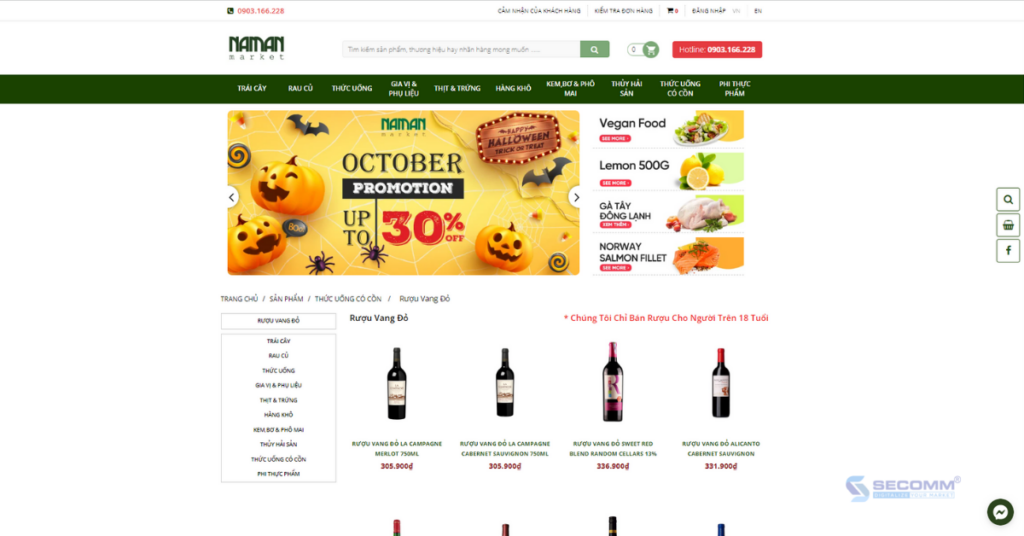
Winemart was founded in 2015 to provide consumers with the best services and products possible. Currently, Winemart operates in two main areas:
Winemart’s eCommerce website receives over 60,000 visits and is regarded as one of Vietnam’s most prestigious online wine suppliers.
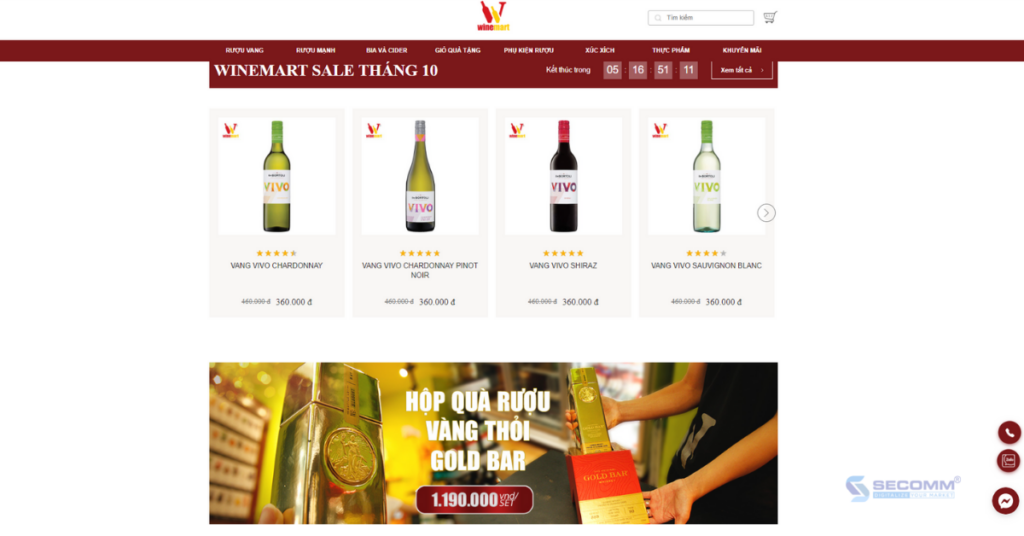
Sieu Thi Ruou Ngoai is not only an eCommerce website that sells imported foreign wine but also a knowledge system about culture, history, and how to choose, preserve, and enjoy wines from around the world, allowing people who are passionate about or want to learn about wine culture to share and improve their understanding.
Sieu Thi Ruou Ngoai now has its own eCommerce website system, which receives over 50,000 visits per month and is highly regarded by customers for both product quality and online shopping experience.
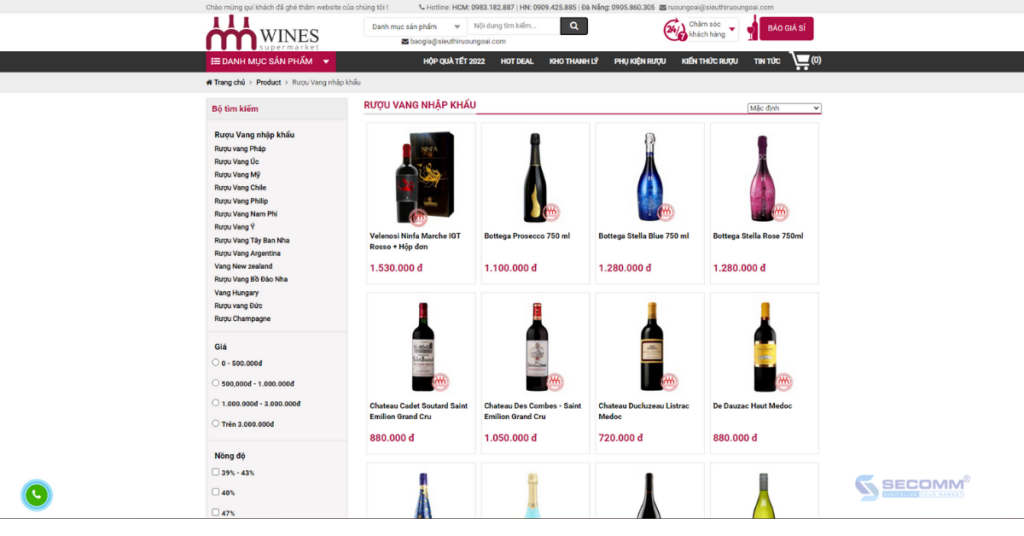
Cao Minh was founded and developed by CEO Thanh Dung, a wine enthusiast who is passionate about learning about wine culture. After many years of research, learning, and improving service quality, Cao Minh has fully converged all the factors to become Vietnam’s leading wine supplier.
Cao Minh’s website is written in PHP and includes all the necessary features and an easy-to-use interface. Cao Minh Wine has become a household name among customers who prioritize online wine shopping.
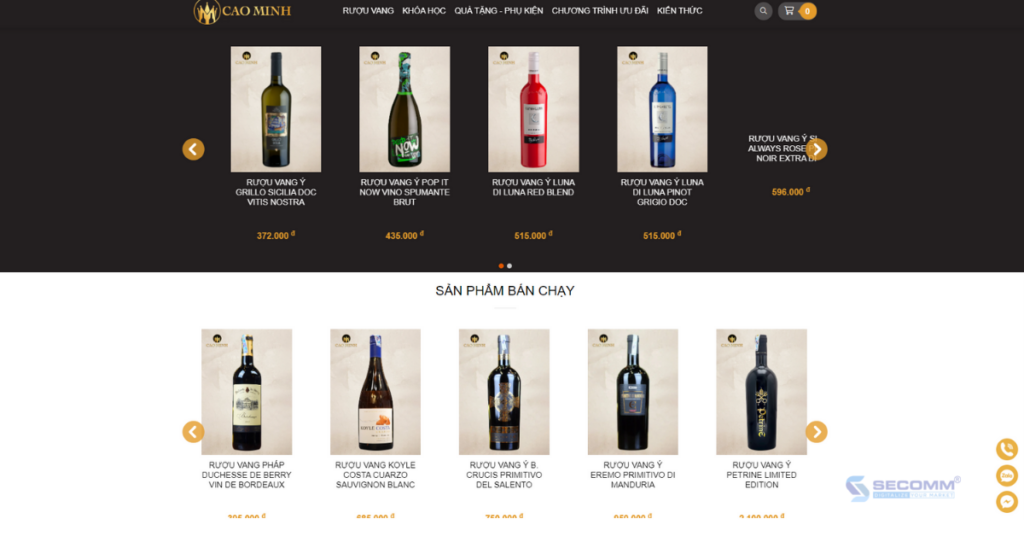
Kho Ruou, also known as Kho Ruou Co., Ltd., is Vietnam’s leading importer and distributor of foreign wines and spirits, with over 3000 products of wine, spirits, beer, Japanese sake, and genuine high-end accessories.
Kho Ruou pursues an eCommerce business model by investing in developing a website using the WooCommerce platform. As a result, the company can easily reach a large number of potential customers both online and offline.
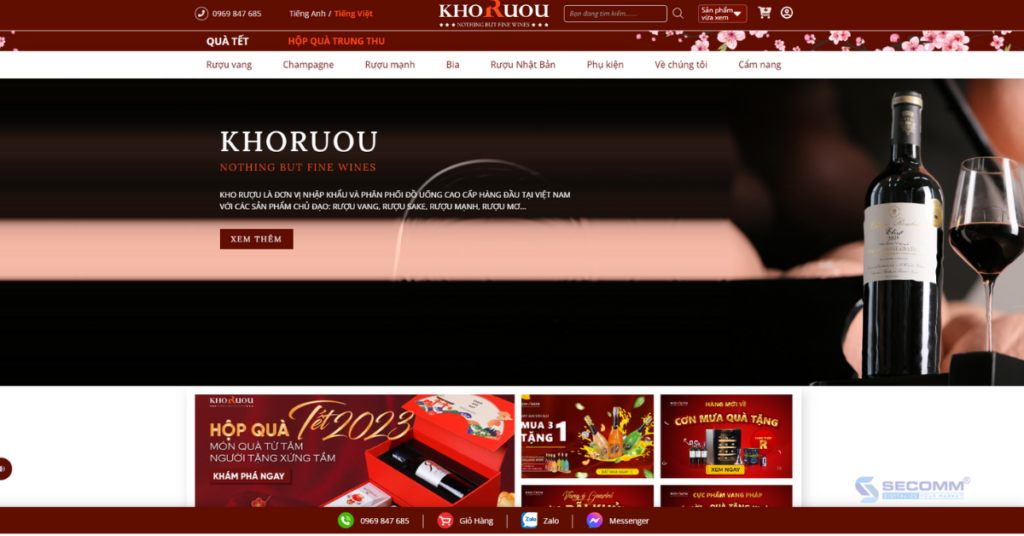
When eCommerce is a new trend widely praised by the Covid-19 pandemic. To keep up with that trend, Wine Tot built an eCommerce website with WooCommerce, which helped to increase brand coverage and reach a large number of potential customers on the Internet.
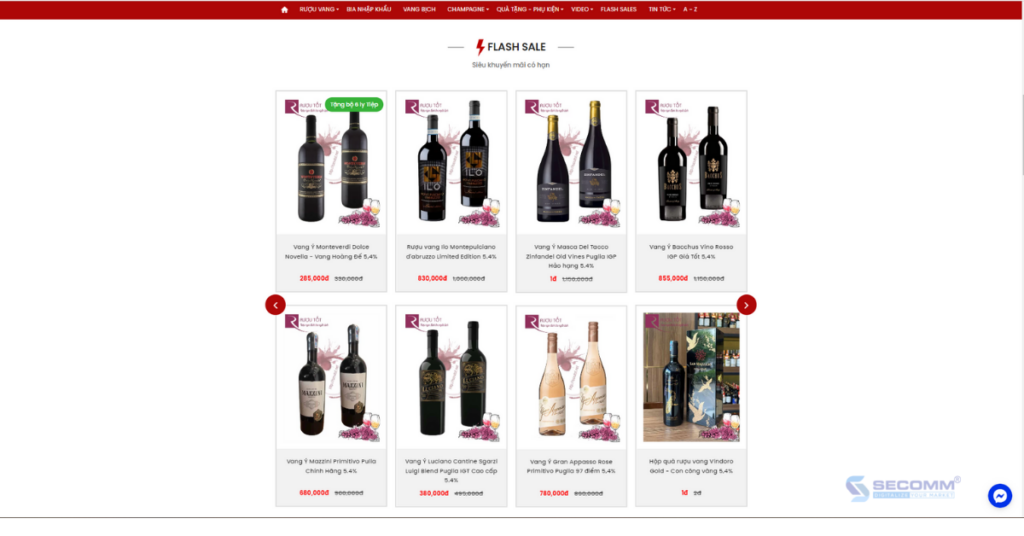
Ruou Nhap Khau is a wine eCommerce website operated by Ham Ruou Vietnam Co., Ltd, one of Vietnam’s leading import and distribution businesses.
Ruou Nhap Khau creates an e-commerce website with the PHP programming language. With an easy-to-use interface and good product quality and service, the company has gradually gained customer trust for its imported wine product lines ranging from popular to high-end.
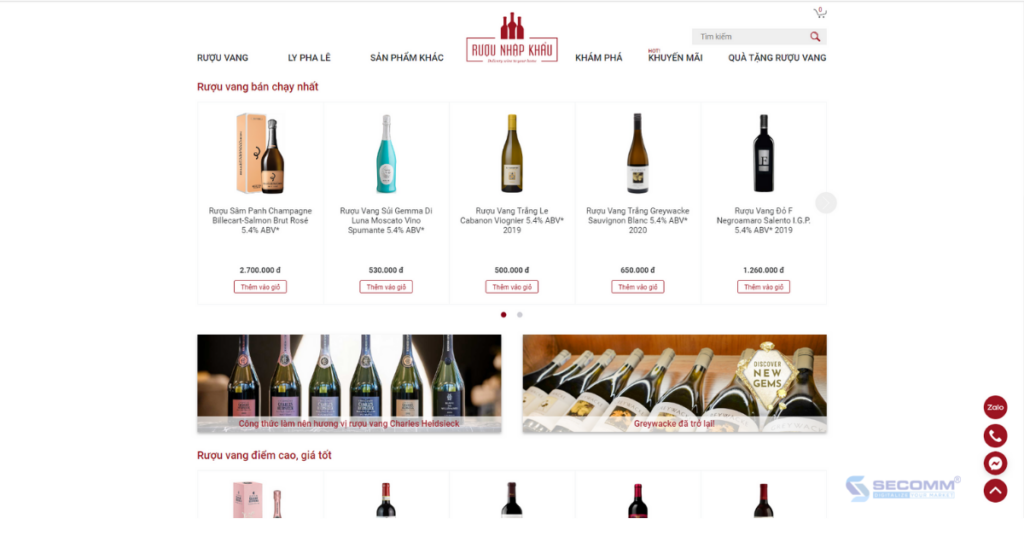
Sanh Vang is a wine distribution brand founded in 2015 by Saigon Hoang Kim Investment and Trading Company Limited. Sanh Vang has expanded its branch network to many provinces, including Ha Noi, Ho Chi Minh City, Bien Hoa (Dong Nai), and Buon Ma Thuot.
Furthermore, Sanh Vang’s eCommerce website receives over 25,000 visits per month, and the brand receives many positive reviews from customers due to its wine quality, competitive price, available stock, and variety.
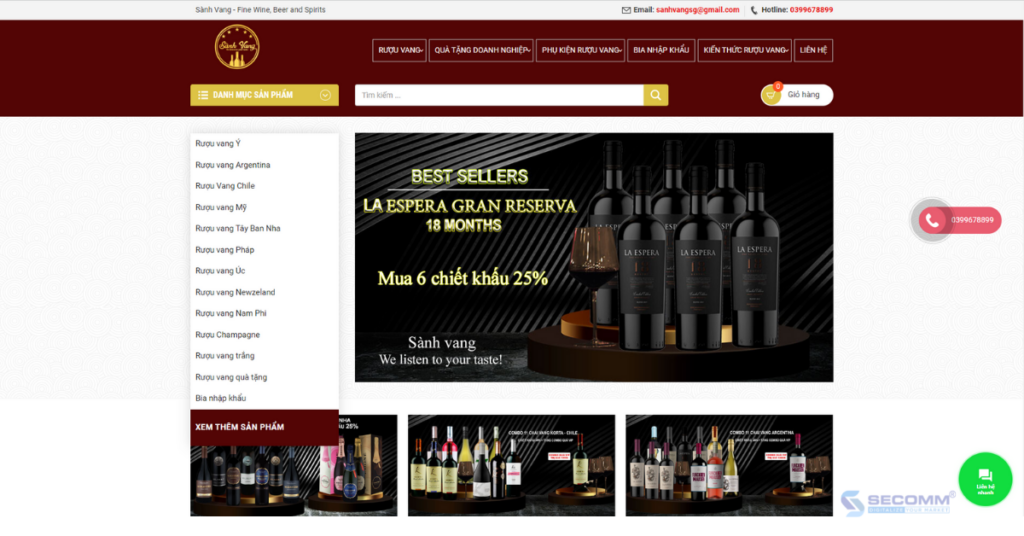
Winecellar, founded in 2007, is one of Vietnam’s largest wine companies, specializing in high-quality wine, beer, whiskey, food, mineral water, tea, and ceramic products. Winecellar, like Kho Ruou and Sanh Vang, uses the WooCommerce platform to implement eCommerce.

The Warehouse is a wine and spirits distributor in the Vietnamese market, as well as one of An Nam Group’s retail brands.
With a long-term and sustainable eCommerce business in mind, this brand has decided to invest in developing its own eCommerce website on the open-source Magento platform and continuously upgrading this system to provide a better eCommerce experience for customers.
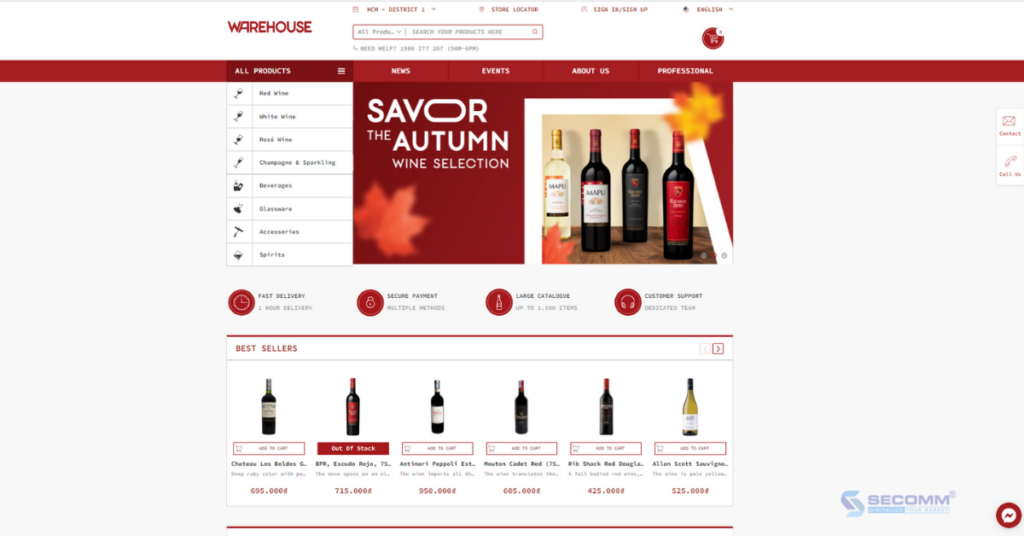
In general, Vietnamese wine brands are reaping numerous market successes after successfully developing their own eCommerce websites. However, the wine eCommerce business necessitates careful consideration of tactics to take the most effective steps not only in the short term but also in the long term.
Furthermore, wineries need to find a support unit or build a highly qualified in-house team to help them to achieve a common goal.
With many years of experience implementing eCommerce in many countries, SECOMM provides free consulting services with professional eCommerce solutions.
Contact us today for free support and advice!
 2
2
 5,271
5,271
 0
0
 1
1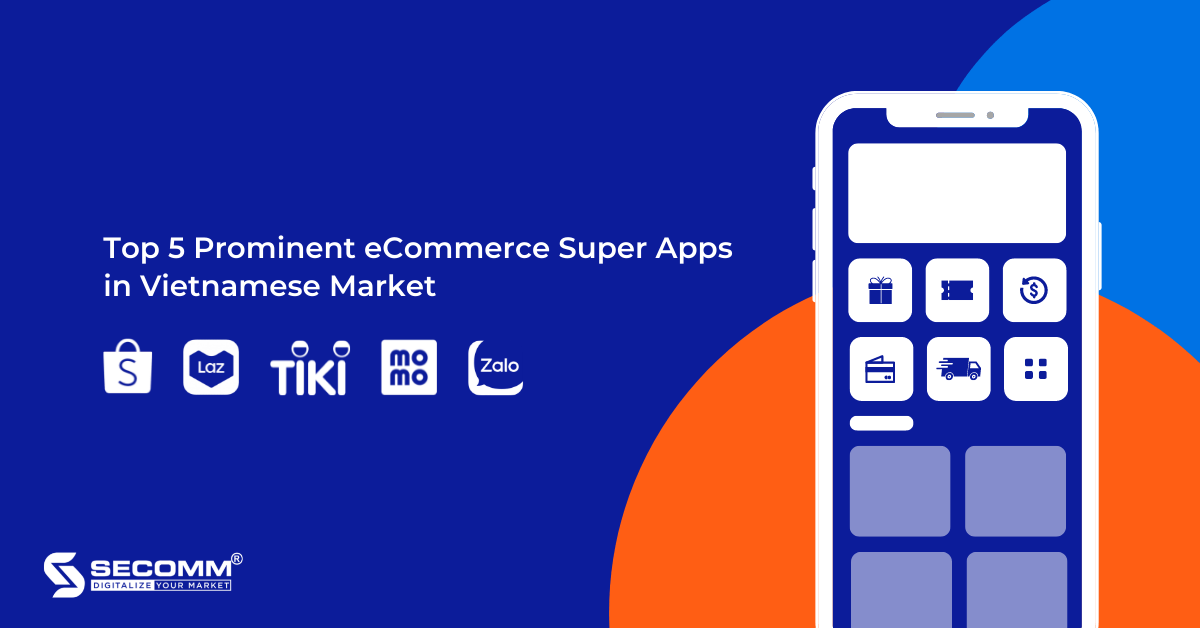
According to the latest of Ministry of Industry and Trade of the Socialist Republic of Vietnam in 2022, the eCommerce industry’s revenue is estimated at 13.7 billion USD, increase 16% compared to 2020 and accounting for 6.5% of the total retail revenue of Vietnam. Due to e-Commerce SEA, Vietnam’s eCommerce will grow by an average of 25% per year from 2022 – 2025, possibly reaching 35 billion USD in 2025.
The impact of the Covid-19 epidemic and social distancing orders, as well as changes in consumer behaviour, are driving the growth of this industry.
Thanks to super apps, such as Shopee, Lazada, Tiki, MoMo, and Zalo, it’s easier to deploy mini apps, creating a premise for inexperienced brands to build eCommerce systems to enter this billion-dollar market.
Shopee is the most popular eCommerce market in Southeast Asia and Taiwan. Shopee was founded in 2015 to provide people with an easy, safe, and quick online buying experience.
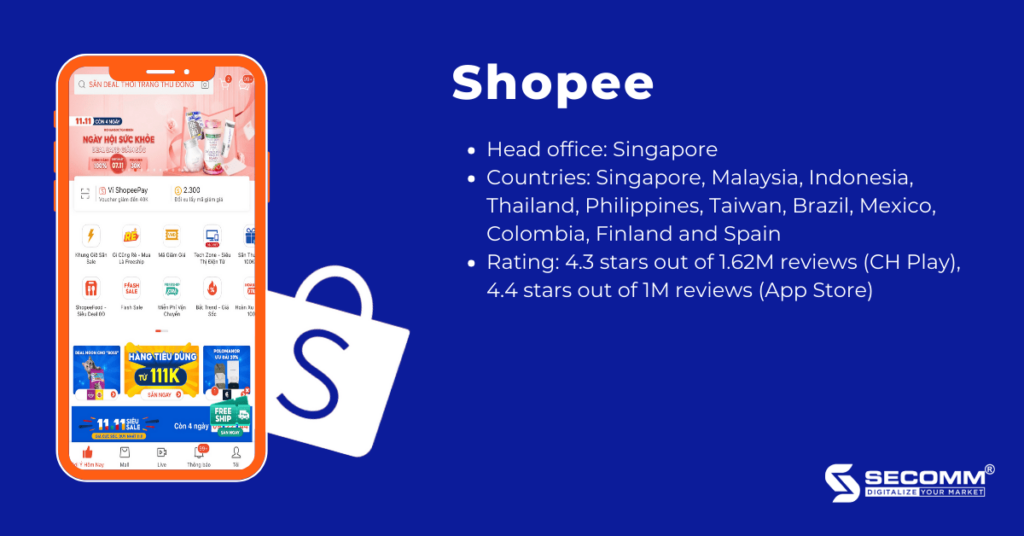
Shopee is gradually becoming an eCommerce super app, not only offering online shopping services but also owning various mini-apps such as Shopee Food, Shopee Mart, Shopee Wallet, insurance services from banks, booking flights, hotels and so on.
Lazada, founded in 2012, is one of Southeast Asia’s biggest eCommerce marketplaces. This brand has always been a pioneer in fostering regional development via commerce and technology, intending to service 300 million consumers across Southeast Asia by 2030.
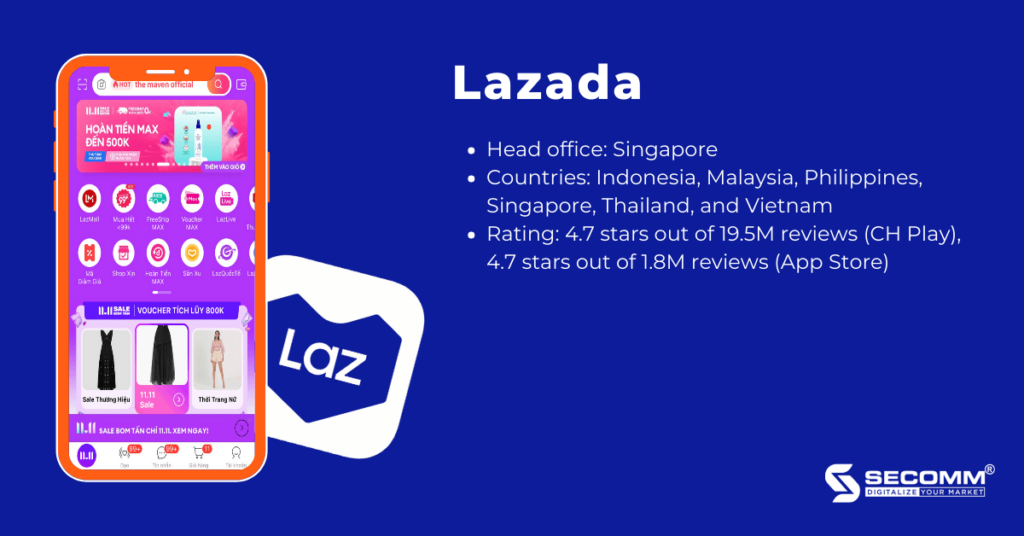
Like Shopee, Lazada has many mini apps and utilities for its own e-commerce business strategies, such as eM wallet, card and eVoucher recharge, online shopping, etc.
Tiki is one of Vietnam’s most successful eCommerce marketplaces. Tiki was founded in March 2010 as an online English book-selling site. Since then, Tiki has evolved into an eCommerce super app, focusing on delivering hundreds of thousands of goods from a variety of product categories.
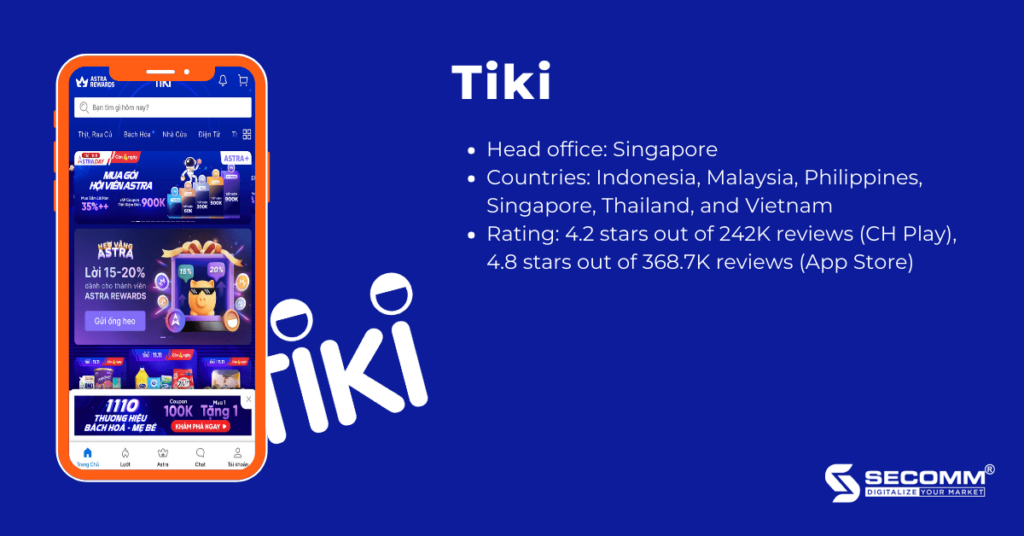
Tiki has been a pioneering marketplace in applying digital currency to business concepts, as proven by the launch of Astra, to boost up eCommerce. At the same time, Tiki refined its ecosystem by creating a series of extensions with mini apps from brands in various industries, including finance, gaming, food, shopping, health, insurance, entertainment, lifestyle, tourism, and community.
MoMo is an e-wallet created by Online Mobile Services Joint Stock Company (M Service) that allows users to make mobile payments and transactions. Through partnerships with more than 90% of Vietnam’s banks and 10,000 local businesses, the company dominates more than 80% of the market for digital payments. As of 2022, MoMo e-wallet has more than 31 million users.
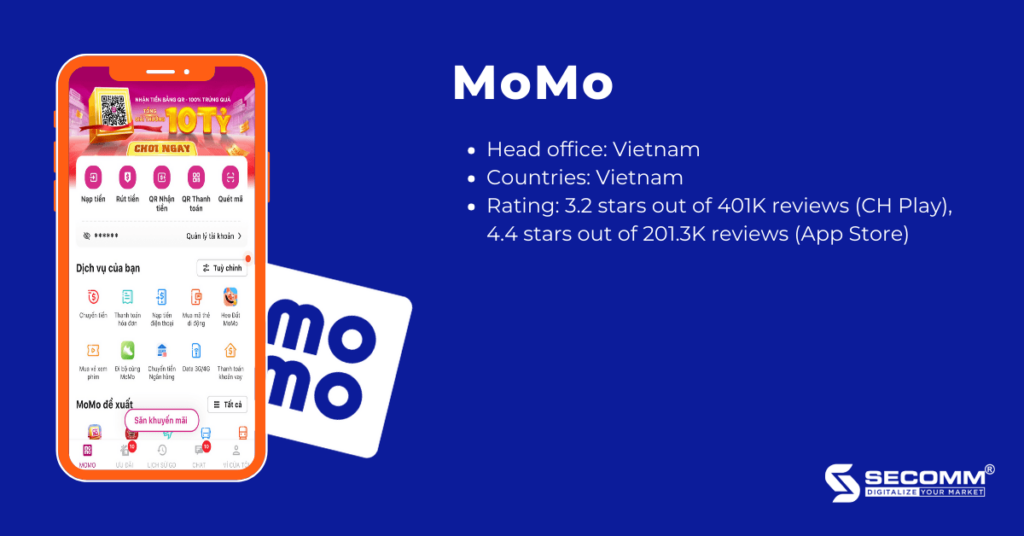
Since 2022, MoMo has developed a mini app technology, formally identifying itself as a super-payment app, helping small and medium companies to “climb on the shoulders of giants,” and construct an ecosystem for MoMo. In particular, utilities from businesses such as online shopping, restaurants, transportation services, tourism and hotels, investing and banking, medical services and so on.
Zalo was formally launched in December 2012, with the essence of a cross-platform instant messaging software built by the Vietnamese startup VNG. Zalo is a blend of Zing (a VNG-created social network) and alo (a phrase used to pick up a phone in Vietnam). Zalo has progressed to become a multi-functional, multi-platform social networking super app.
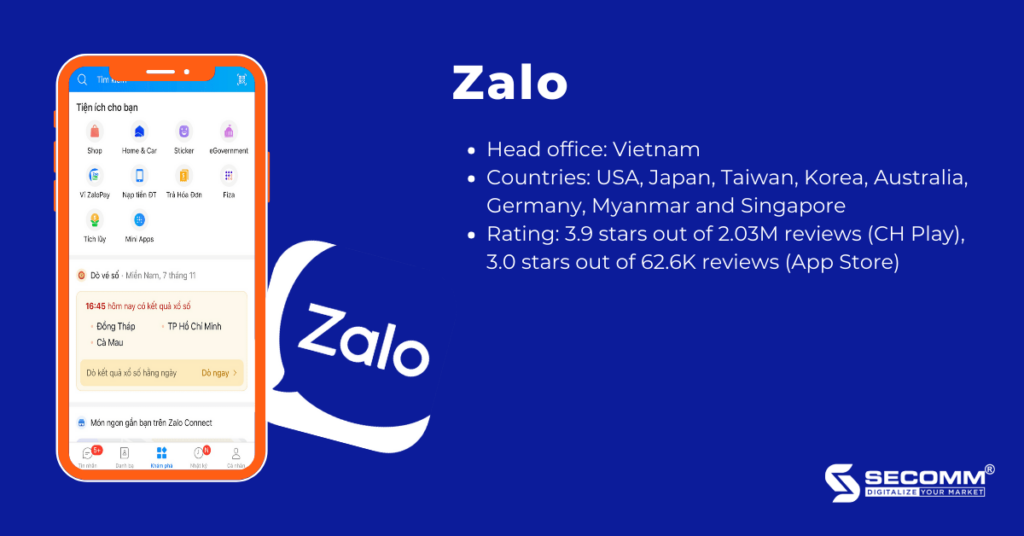
Like MoMo, Zalo created a new brand named Zalo Mini App to help other brands reach 65 million regular users on Zalo, and make diversity for this messaging platform. Since then, Zalo has also supported other services, primarily through partnerships with brands in finance, eCommerce, entertainment, games, restaurants and hotels.
As can be seen, the future of Vietnam’s eCommerce industry will continue to rely on these “giants,” thus businesses should incorporate eCommerce super apps into their business models as soon as possible to reap the full advantages of these applications. However, companies should not rely on these apps for long periods of time since it will result in a loss of customer data, income from commission per order, and so on.
With more than 8 years of experience in consulting and deploying eCommerce systems, SECOMM understands the challenges businesses face in implementing eCommerce business effectively.
So we provide a free eCommerce consultation to help businesses catch on to this industry!
 2
2
 8,368
8,368
 0
0
 1
1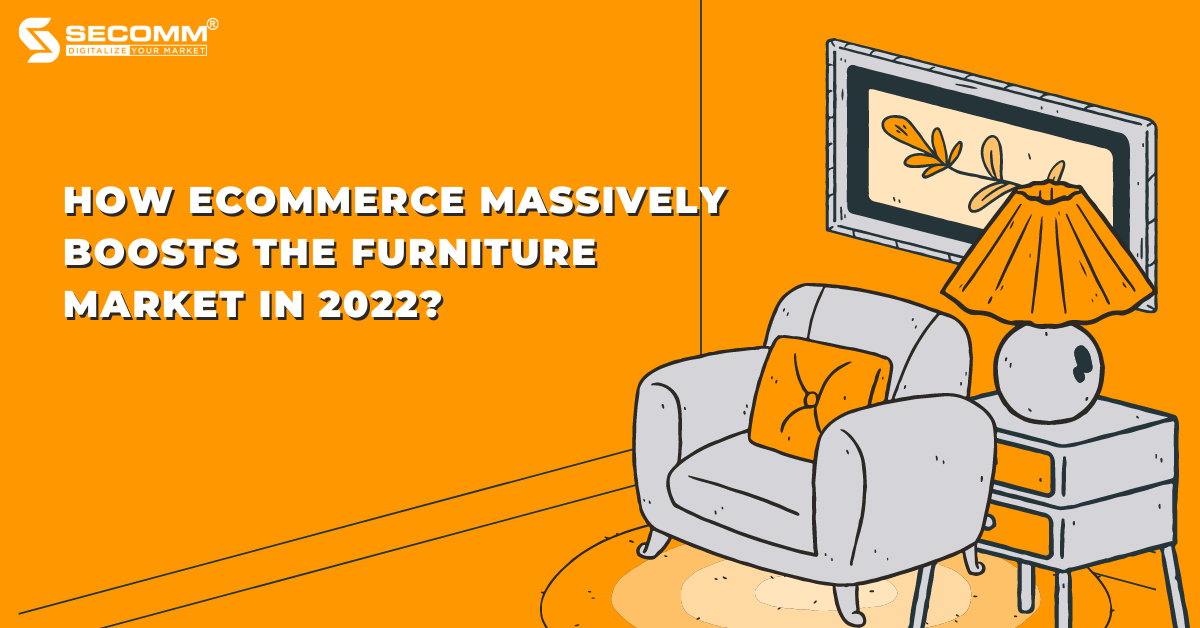
The desire for home furnishings and design among consumers has significantly increased as life gets better and better. The majority of consumers still prefer to choose and purchase products in physical stores and showrooms, but online furniture shopping is an increasing tendency. Additionally, the impact of the Covid-19 pandemic on consumer purchasing habits has changed how people purchase, which has greatly aided the development of the furniture eCommerce market.
BusinessWire estimates that the size of the furniture eCommerce market in 2021 was valued at USD 27.74 billion and that it would increase at a compound annual growth rate (CAGR) of 4.4% from 2022 to 2030 to reach USD 40.74 billion.
Recent findings made by Maddyness include the following intriguing details:
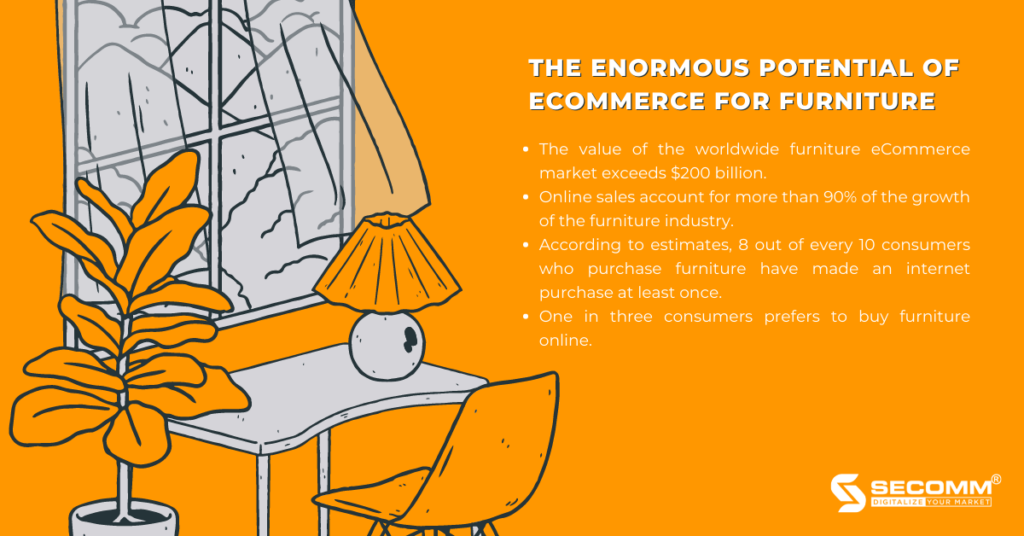
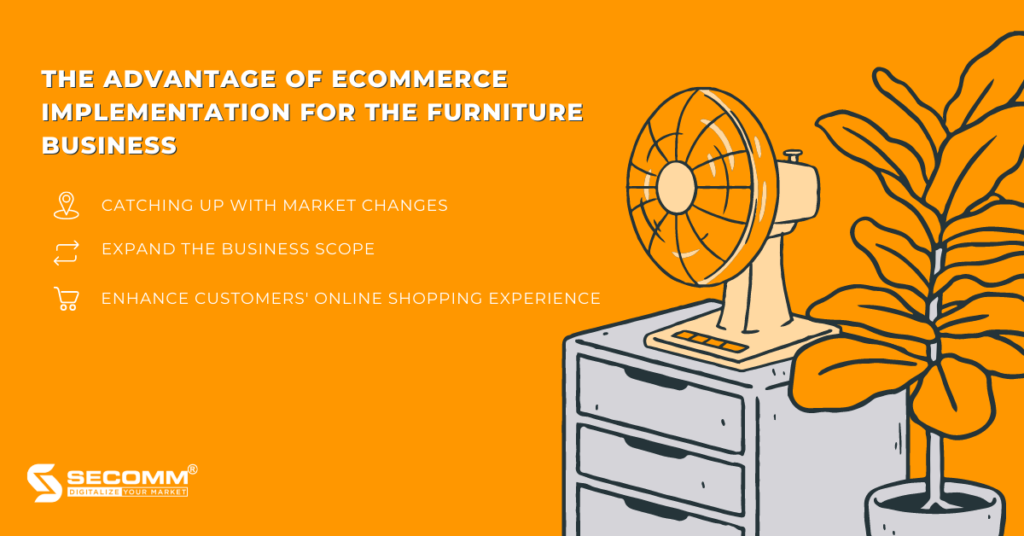
The furniture sector has experienced a significant decrease in sales over the past few pandemic years, along with many other industries.
People are compelled to reduce their social interactions during the social withdrawal period. They now spend more time working, living, entertaining, and teaching at home. In light of the unpredictable changes of the pandemic, the necessity to clean and renovate the dwelling has therefore substantially increased.
Due to limits on leaving the house, online shopping at the time had become not only a need but also an urgent method of purchasing in place of in-person purchases. That serves as the springboard that gives eCommerce its spectacular development and propels it into other industries like fashion, grocery, wine, and even furniture.
These two elements highlight the “cake’s” enormous potential and aid many furniture companies in realizing and swiftly implementing eCommerce for market revolution and sustainable development.
Due to the Internet’s rapid expansion and the burgeoning online shopping trend, which is gradually replacing traditional offline shopping, the adoption of eCommerce will benefit furniture manufacturers by providing a new sales channel and attracting a big number of potential clients (at stores, and showrooms).
eCommerce implementation will also help to broaden the market for businesses by improving the circumstances for marketing campaigns to be more successful.
When firms use technology to improve customer experience in eCommerce, furniture shopping will happen more quickly.
In the digital age, for instance, visual experiences from VR/AR technology, 3D product visualization, and 360-degree photography are very popular, gradually replacing in-store shopping while still being fully informed and realistic visualization of products, thereby increasing customer satisfaction during online shopping.
eCommerce enables businesses to quickly and effortlessly tailor the experience for customers by gathering, evaluating, and synthesizing the consumption behavior of each target group. Typically, this is done with the capabilities listed below: Products have seen, similar product recommendations, etc.
eCommerce provides clients with a seamless experience in addition to an intuitive one across a variety of channels, including social networks (Facebook, Instagram, Tiktok, Zalo, etc.), eCommerce platforms (Shopee, Lazada, Tiki, Sendo, etc.), eCommerce websites, mobile apps, etc.
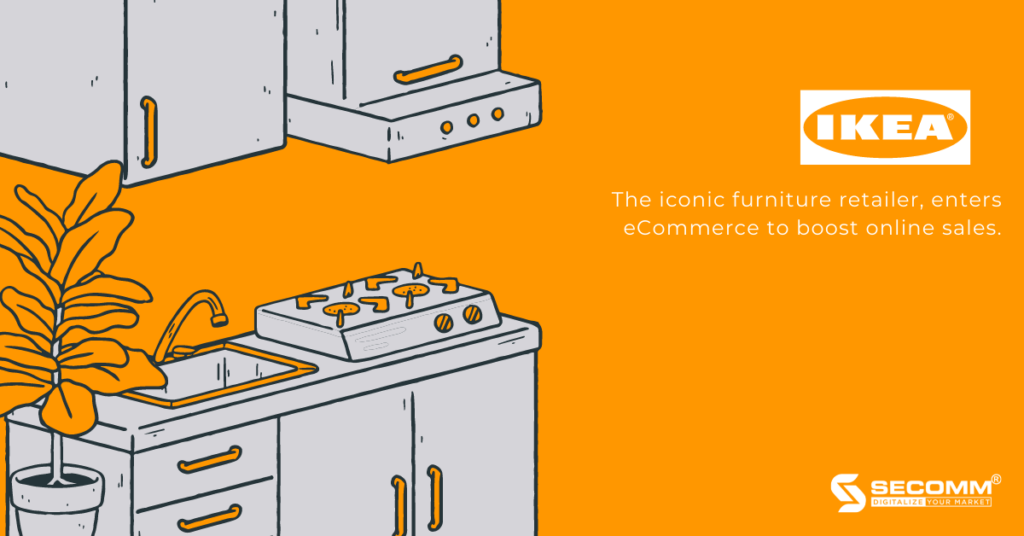
IKEA, or Ingvar Kamprad Elmtaryd Agunnaryd, is the world’s largest furniture retail enterprise and specializes in delivering minimalist-styled assembled furniture, household appliances, and accessories.
IKEA was established in 1943 in Sweden by Ingvar Kamprad, who started his business at the age of 17. IKEA swiftly gained global dominance with 392 locations across 48 nations.
With the goal of offering furniture with a lovely style and wide application while keeping the price low so that as many people as possible can purchase the goods. The majority of the departments, from marketing and sales to supply chain and warehouse, share this goal.
Everybody works together to keep IKEA’s “vital” competitive edge intact so that the company can publish catalogs with thousands of products offered at long-term stable prices.
Despite being the largest furniture retailer in the world, IKEA has lagged behind eCommerce trends, according to the Financial Times. This well-known retailer started “renovating” its sales technique only when it encountered numerous internet rivals.
The biggest barrier that makes it difficult for IKEA to adjust its previously successful business model is the maze-like arrangement of store layouts to create an engaging experience of sightseeing, interior shopping, or requiring customers to drive to the store and assemble the components to make their own furniture.
But IKEA has unimaginably succeeded in launching an e-commerce website by fusing cutting-edge technology with a well-organized marketing plan. In particular, IKEA specifically uses VR/AR technology, which is seen as a new eCommerce trend and is favored by many firms, to improve users’ online purchasing experiences.
IKEA thereby covers the sales void left by the prior on-site furniture business model, but the gap won’t truly be felt until the Covid-19 pandemic and social separation restrictions are in place.
From this point, IKEA expands its consumer base both online and offline, and sales are progressively encouraged to increase significantly.
Additionally, IKEA’s eCommerce website incorporates Instagram posts of photographs of IKEA furniture goods that consumers customize, share, and tag with the hashtag #IKEA.
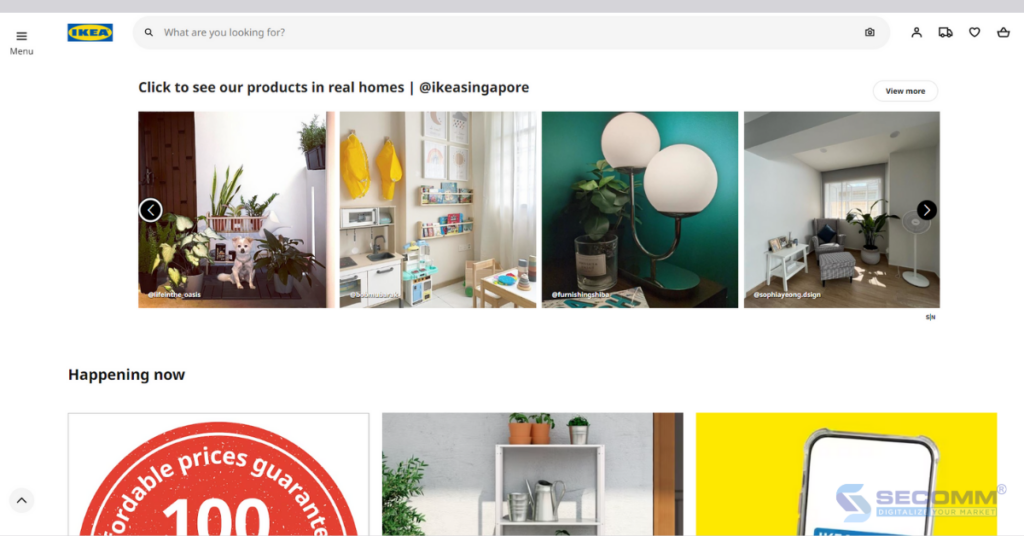
This not only helps this brand connect closely with Instagram users, increase its reputation and strengthen the loyalty of existing customers but above all, quick access to a large diverse customer base from the Internet in general and Instagram in particular thanks to the popularity and influence of this social network on young consumers.

Established in 1999, Nha Xinh is a well-known furniture brand in Vietnam. It has two sizable showrooms, one each in Hanoi and Ho Chi Minh City.
As a manufacturer and supplier of living room, bedroom, dining room, and kitchen furniture with an Asian design aesthetic that favors coziness, friendliness, and simplicity above sophistication and luxury, Nha Xinh is a specialist in this field.
Nha Xinh’s website belonged to the “long-lived” row in the Vietnamese eCommerce village when it was created and launched in 2007, a period in which Vietnam was still getting used to utilizing the Internet to progressively integrate with the rest of the world.
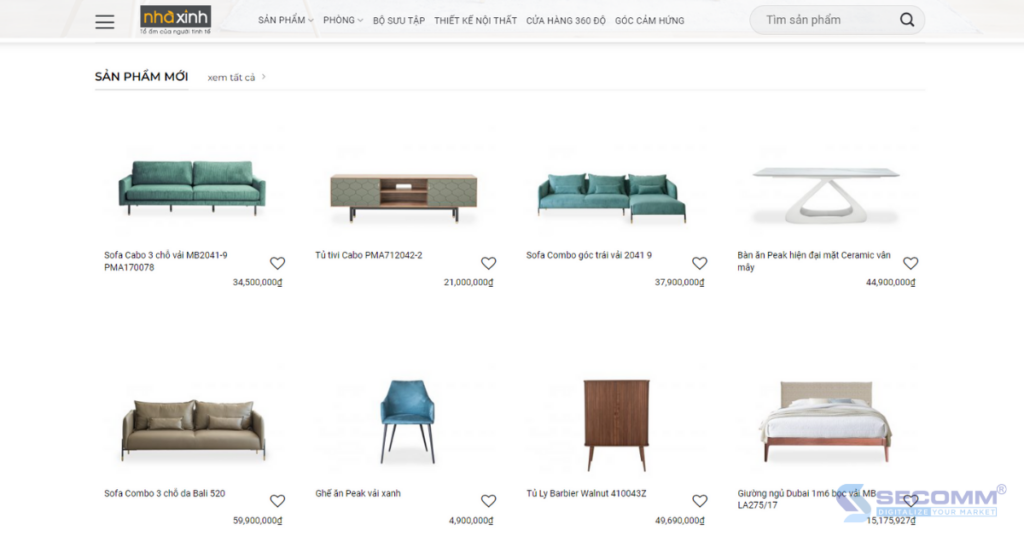
Nha Xinh’s eCommerce website has survived many years of market ups and downs while maintaining its inherent simplicity, intimacy, and sophistication.
Product categories are arranged clearly and harmoniously in each room to make it easy for customers to search, choose products that suit their needs, and get a sense of the room’s overall layout.
Customers can choose from a variety of options because the room’s layout is available with furniture and includes a detailed price. If they prefer, they can even select a combination of the interior and decor of the room without having to spend a lot of time figuring out how to combine each item because Nha Xinh already did it.
Additionally, Nha Xinh’s website has a unique section called “360-degree store” that uses 360-degree technology to let customers view the company’s interior products from a distance in an accurate manner from every nook and cranny of the room and every angle of the product, along with comprehensive information and price lists for each item.
Additionally, Nha Xinh’s “Inspiration Corner” catalog offers a wealth of thoughts and ideas to assist clients in designing their dream living space. Nha Xinh gives home design recommendations in a variety of styles, from elegant, and gentle to strong and personable depending on the individual’s preferences.
Therefore, Nha Xinh is more than just an eCommerce site that sells furniture; it is also a handbook that provides customers with never-ending design ideas.

Hoa Phat Furniture was founded in 1995 and over the course of over three decades has made a positive impact on Vietnamese consumers’ perceptions of quality products and exquisite design while fulfilling a variety of needs for office furniture, home, household furniture, and medical furniture.
With a consistent growth rate of 20–25% each year, the brand is getting stronger and reaffirming its position as Vietnam’s top supplier and manufacturer of furniture.
When Hoa Phat Furniture changed its name to The One Furniture in the year 2022, it left a lasting impression on the industry. The brand name change is linked to adaptable changes in strategy. The company focuses on enhancing the stature, appearance, and image connected with the growth of the nation, helping to instill a variety of ideals into society.
Hoa Phat Furniture (now The One Furniture) invests extensively in technology infrastructure to streamline the production and supply process at the same time as it aspires to expand throughout the area and the world. One might say that The One Furniture has carried on the brand’s good core principles and improved upon them in order to better suit the current market trend.
One of Hoa Phat Furniture’s greatest successes to date is the effective use of 3D printing technology in production, which has helped the company create a number of new products like the Smart Safe; sofa and chair folding in the Italian style while also reducing production costs and speeding up prototyping and increasing product accuracy.
Hoa Phat Furniture concentrates on creating an eCommerce website to reach many potential clients that have a habit or preference for online buying, in addition to being adaptable and prompt with changes in strategy.
The firm creates websites using the WooCommerce framework, a well-known and dependable open-source platform used by many companies to implement eCommerce.
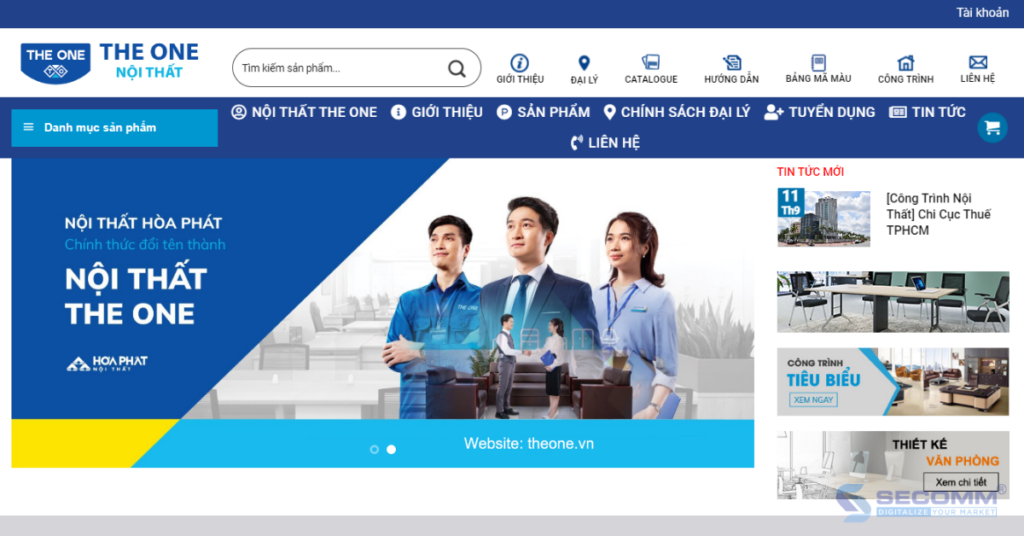
Compared to the previous version of Hoa Phat Furniture, The One Furniture’s new website (noithattheone.com.vn) features a more simplified, gorgeous, and contemporary interface (noithathoaphat.com.vn).
Additionally, the business supports the growth of well-known social media platforms like Facebook, Instagram, Youtube, and TikTok to broaden brand awareness, attract more customers, and enhance coverage.
Plus, the business offers a wide range of shipping and payment choices to accommodate the various needs of clients, making online buying at The One Furniture or Hoa Phat Furniture as convenient as it can be.
It is clear that the growth of the furniture market has been hastened by the speed at which eCommerce is developing.
Today, numerous local and international furniture companies participate in and offer the greatest shopping experiences to customers through the effective implementation of an eCommerce website, including IKEA (Sweden), Nha Xinh, and Hoa Phat Furniture (Vietnam).
From there, companies may quickly connect with a wider pool of Internet users and generate conversions through efficient marketing strategies.
However, business leaders need to carefully and comprehensively take into account the growing customer expectations and rapidly shifting market trends, not to mention specifically describe a systematic and precise business strategy for taking the most advantageous actions in the short and long term.
Completing that difficult task will take a lot of time and resources. As a result, many furniture companies opt for a more straightforward approach to the issue, enlisting the assistance of a highly qualified and dependable unit.
SECOMM has many years of expertise in effectively executing eCommerce for numerous customers in various countries. We specialize in offering free consultation services with qualified eCommerce implementation solutions.
Contact us right away for free counsel and assistance.
 2
2
 4,758
4,758
 0
0
 1
1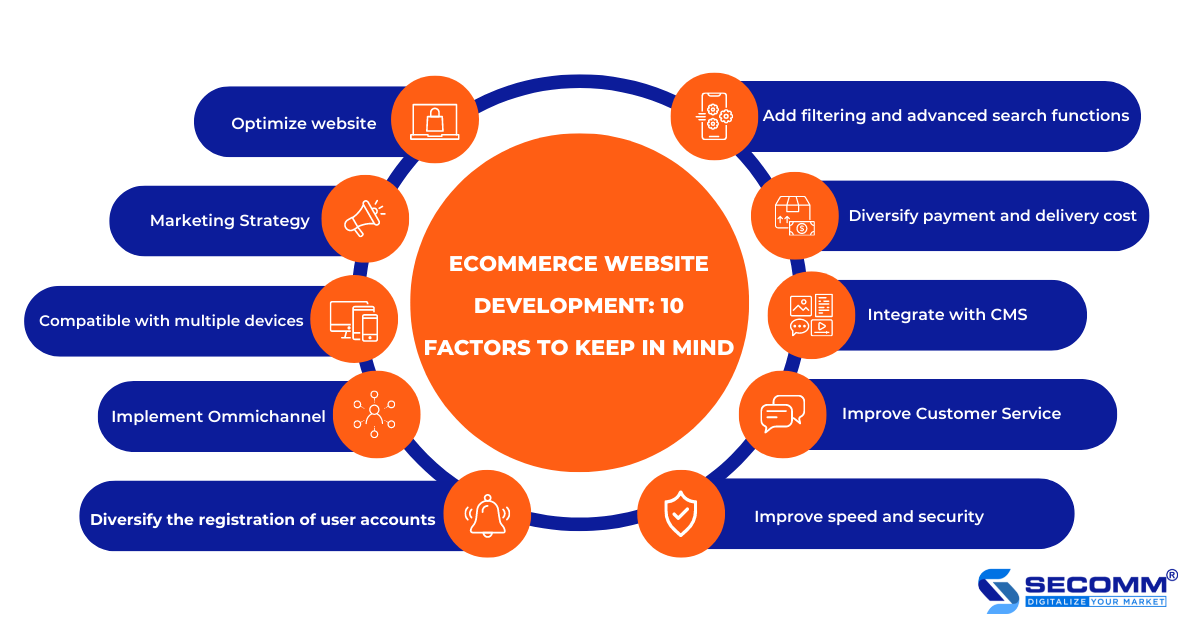
Creating an eCommerce website is a critical step in assisting businesses in spreading their brands and increasing their ability to reach potential customers on the Internet, thereby increasing revenue and profit. However, developing a business website is a complicated process with many aspects, particularly with eCommerce websites.
Businesses must consider everything from user experience to operational performance and many other aspects of the site. Here is a summary of the key factors of an eCommerce website that businesses and website developers should consider before getting started.
According to Think with Google research, if a web page takes up to 5 seconds to load, the likelihood of a user exiting increases by 90%. As a result, businesses must prioritize optimization and ensure that their eCommerce website is always operational.
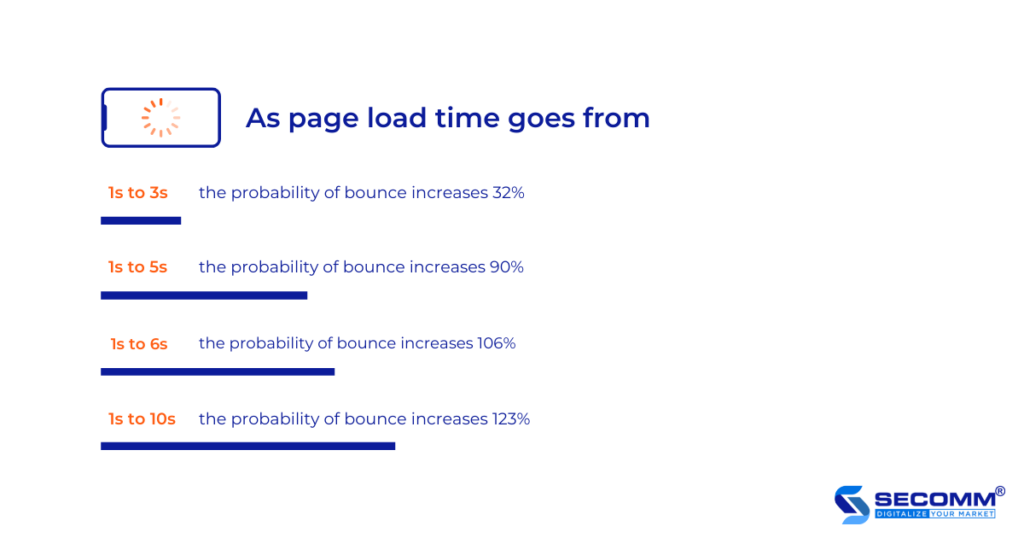
Furthermore, businesses must pay attention to optimizing SEO so that the website has the highest possible ranking on search engines using specific techniques and strategies if they want to maximize revenue on their brand websites. One of them is the strategy of incorporating keywords into the eCommerce website’s content, as well as description, title, and image information.
When adding an “alt text” description to an image, many businesses forget that customers can find their website through image search. This is also a significant flaw that results in a significant loss of potential customers.
Furthermore, in the early stages of e-commerce website deployment, businesses should consider hiring SEO experts. They can launch the website with the necessary meta tags, organize the page structure and internal links, create content strategies, design recommendations for cross-device-friendly functionality, improve page load speed, and many other critical aspects.
A good marketing strategy may benefit the first orders offline and online, particularly in eCommerce. Creating an early marketing strategy assists businesses in identifying the features that must be included in developing eCommerce systems.
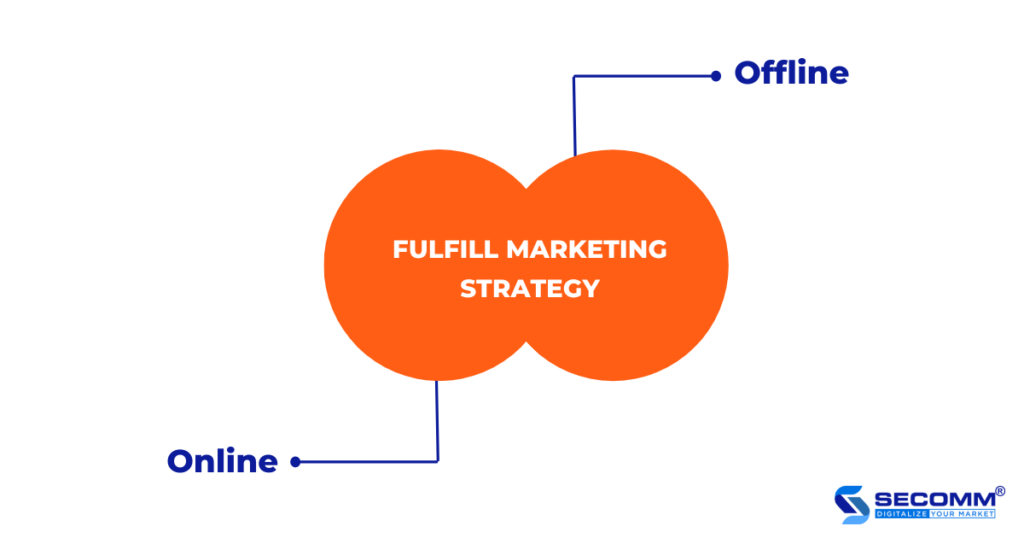
For example, when businesses want to add the option to share a promotion campaign to social networks or push notifications on mobile apps from an eCommerce website, it will be more effective if this is part of the Marketing strategy and is planned to be implemented during the development of the eCommerce website rather than proposed to be developed after the website has been launched.
According to the World Bank, two-thirds of adults worldwide use digital payments, with this figure expected to rise from 35% in 2014 to 57% by 2021. Although users prefer to make purchases via mobile apps, businesses can still increase conversions if the eCommerce interface is easily adaptable to the mobile web.
For example, after releasing a more optimized responsive design, Walmart Canada successfully increased website conversions by 20% and improved mobile order growth by 98%.
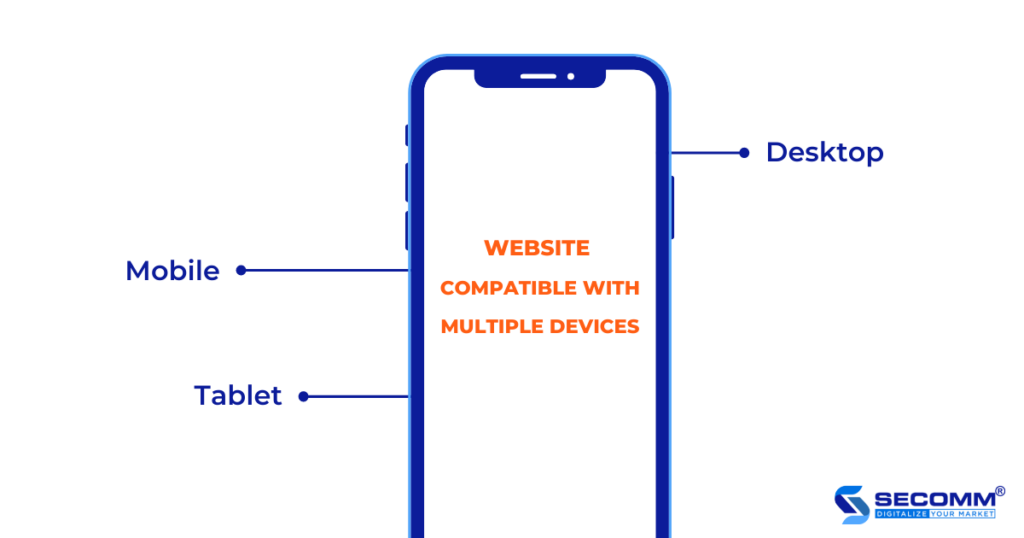
Furthermore, businesses must ensure that customers from all over the world can easily access and shop on their eCommerce website using any available browser.
As a result, businesses will conduct cross-browser testing using Google Chrome, Internet Explorer, Firefox, Opera, Safari, and other browsers to find and fix errors, ensuring customers have a great shopping experience on your website using any browser, any device, and anywhere. Businesses can hire a qualified third party to assist them, or they can conduct their own testing using a few available help tools.
In the digital age, “Omnichannel” is becoming increasingly popular and is an essential communication strategy between businesses and their customers. Every business should adopt an omnichannel strategy to connect with customers, increase traffic, drive sales, and survive the changes of the times.
As a result, implementing Omnichannel enables businesses to synchronize all sales channels for easier data management and increased eCommerce business efficiency. At the same time, Omnichannel provides customers with a seamless experience, allowing businesses to sell omnichannel and increase conversion rates.
When implementing Omnichannel, businesses can use Omnichannel platforms and systems (ETP Group, NEF, GoSELL) or choose one system as the data center for the entire system, such as an eCommerce system (Magento), ERP (Odoo, SAP).
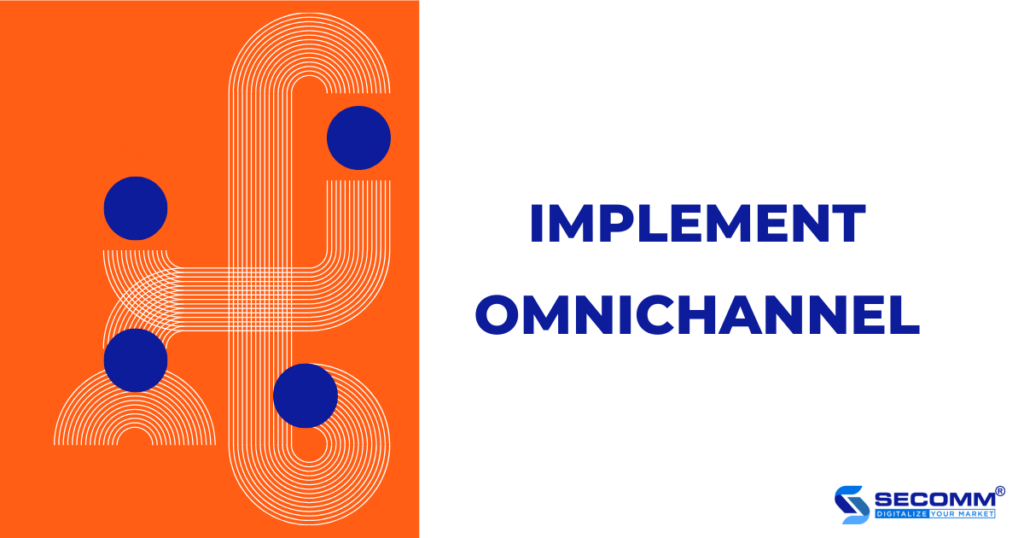
Omnichannel implementation process:
Most eCommerce websites require customers to create an account before making a purchase. This allows businesses to store the customer’s purchase history, delivery address for demographic analysis, purchase behavior assessment, sales analysis, and incentive to buy next time through Marketing campaigns.
Regular customers, in particular, will be willing to do this to reap the benefits of having an account on the website, such as quickly saving information for the next purchase or receiving notifications about upcoming big promotions. However, not all customers want to register for an account to purchase products.
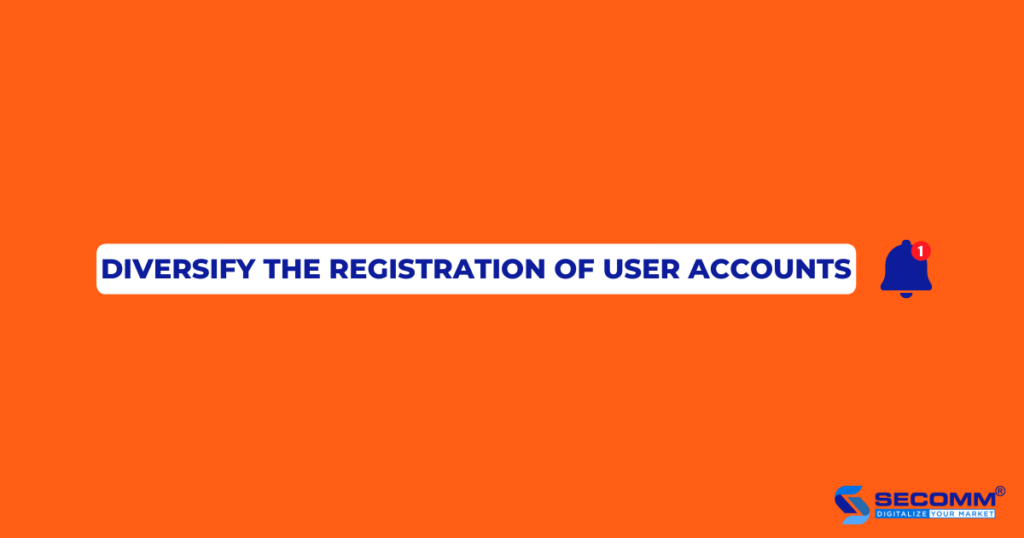
Therefore, businesses must provide options for customers who want to buy goods without registering an account, such as requiring customers to log in with a social network account or fill out a small payment form with their name, email, phone number, and address to complete the purchase process.
The eCommerce website system will automatically create an account and submit guest email login information in both cases.
Even on websites that do not sell anything, users frequently use the search bar. For businesses with eCommerce websites, the search bar must provide advanced search functionality.
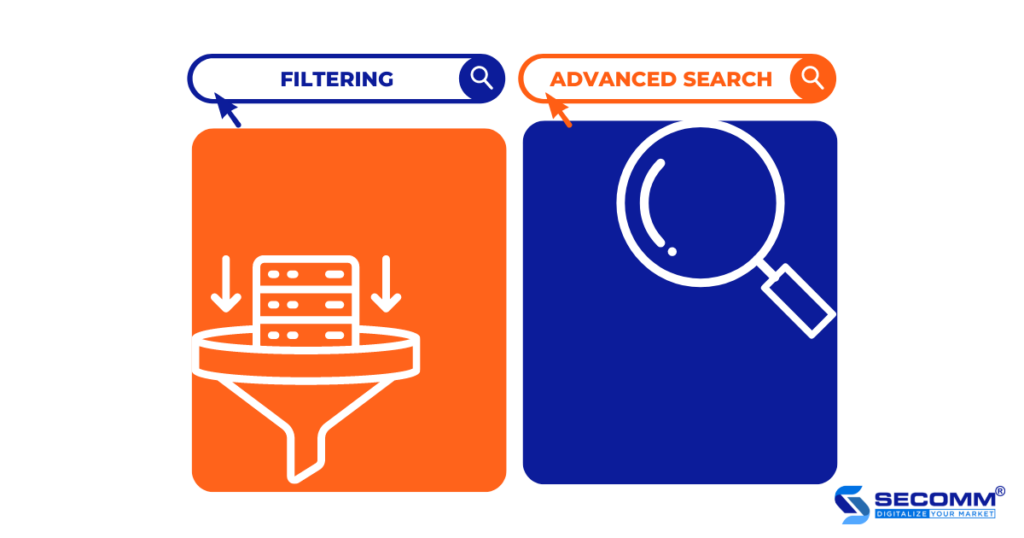
The image search feature, for example, allows users to upload a photo of a favorite item and have the eCommerce website’s search engine return products that are the same, nearly identical, or similar to the product the customers are looking for.
If users don’t know what to look for and need some suggestions, they should browse the website’s product categories. In these cases, the multi-layered product catalog function is extremely useful. In other cases, customers already have search objectives; a search bar with advanced support functions will also assist customers in finding the products they require with a few clicks.
Because online shopping and payments are becoming incredibly popular, it is critical to provide the appropriate payment options when developing an eCommerce website. According to the Payment Methods Report 2019, many shoppers abandon shopping carts because of delivery costs (55%) and complicated checkout processes (26%).
As a result, depending on the product and market that the company is targeting, the company will select a payment method that is appropriate for customers, products, and regions. The most popular payment methods in North America, according to Hostgator, are PayPal, Amazon Pay, Google Pay, Apple Pay, Visa or MasterCard, and so on.
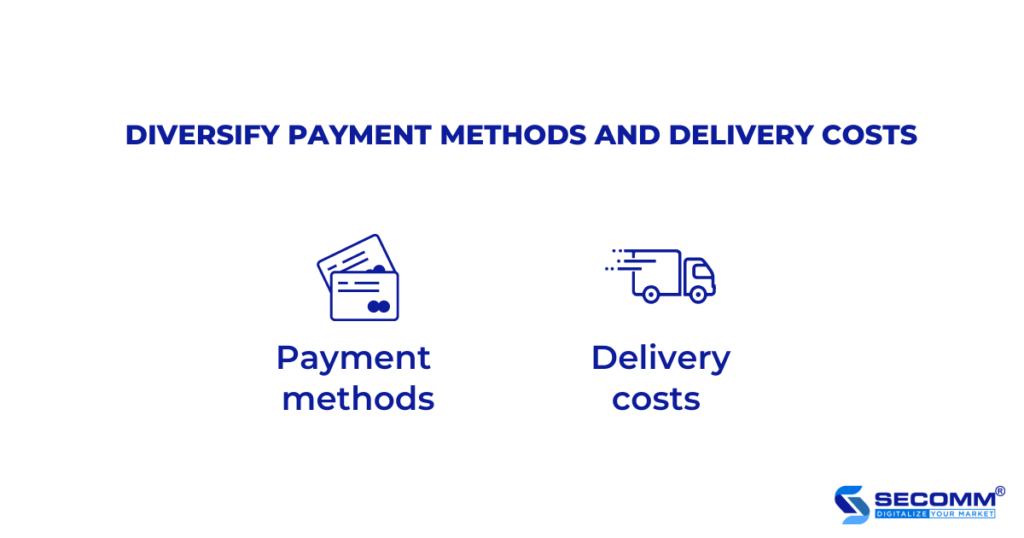
MoMo, Zalo Pay, Shopee Pay, Visa or MasterCard, and others will be particularly popular in the Vietnam market.
Furthermore, businesses should consider delivery costs because this is one of the primary reasons why customers abandon the purchasing process. Businesses can deploy flexible free shipping offers on special promotions, or if customers are required to pay shipping fees, the system should provide detailed information to avoid confusion and create a bad customer experience.
A content management system (CMS) allows you to centrally store and manage your written, visual, and document content. Businesses can change or add information, and the changes will be reflected on the eCommerce website. CMS can also help staff respond more quickly to customer feedback.
Most Internet shoppers are Millennials, Gen Y, and Gen Z. These generations value personalization, such as personalized recommendations, recommendations, or solutions from the support team.
Many eCommerce businesses are trying to meet this, the customer care department will help buyers solve problems during the purchase, payment, delivery, returns, complaints, and so on.
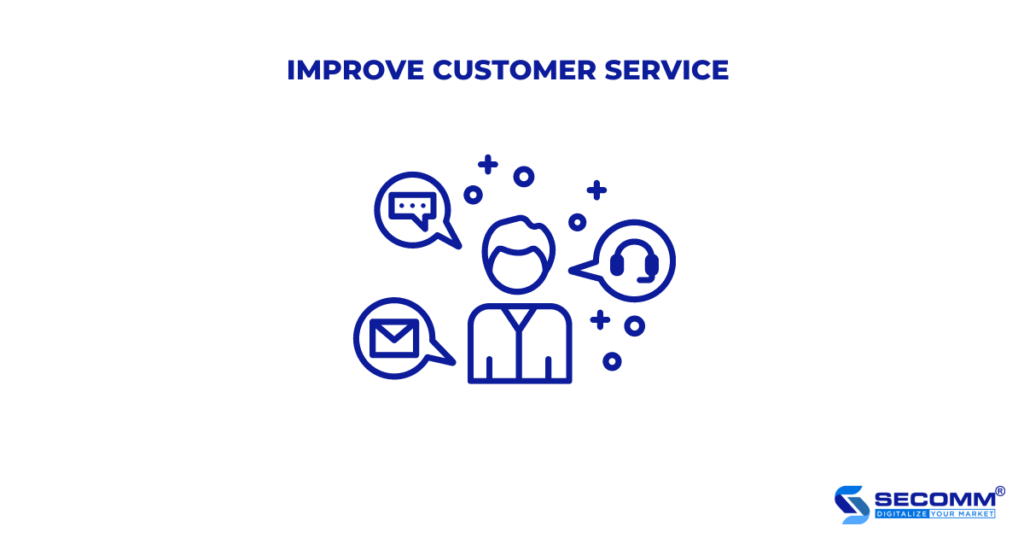
Furthermore, businesses should add a contact section to their eCommerce website with a hotline number or email that can be easily clicked or linked to the Facebook Messenger application, Zalo, live chat for orders, and general support chat for those who prefer this method of communication.
Businesses will be responsible for storing large amounts of user data and product information on an eCommerce website, so safety and security are the most important factors for any eCommerce website. Any negligence can put the company in danger of permanent data loss, and customer information can be stolen and sold.
Google and other search engines will flag an eCommerce website if it is deemed unsafe and has poor security, such as no SSL certificate and HTTPS protocol. This is considered a warning or recommendation for Internet users to be cautious about accessing websites that lack the above two components, as a result of which businesses will easily lose a large number of potential orders, causing marketing disruption and affecting the brand’s reputation.

Furthermore, businesses must register an eCommerce website with the Ministry of Industry and Trade at the eCommerce Management Portal to demonstrate the website’s transparency following Vietnamese Government Decree 52/2013 ND-CP.
The 10 essential factors listed above are those that businesses must consider when implementing eCommerce. In reality, even when businesses use WordPress, the Woocommerce plugin, or a SaaS platform like Shopify, it is not easy to create an eCommerce website with full features that work well to attract customers. If your business decides to hire a website development company, that company must be capable of creating a comprehensive eCommerce website in terms of both design and functionality.
With many years of experience implementing eCommerce in many countries, SECOMM provides free consulting services with professional eCommerce solutions.
Contact us today for free support and advice!
 2
2
 4,994
4,994
 0
0
 1
1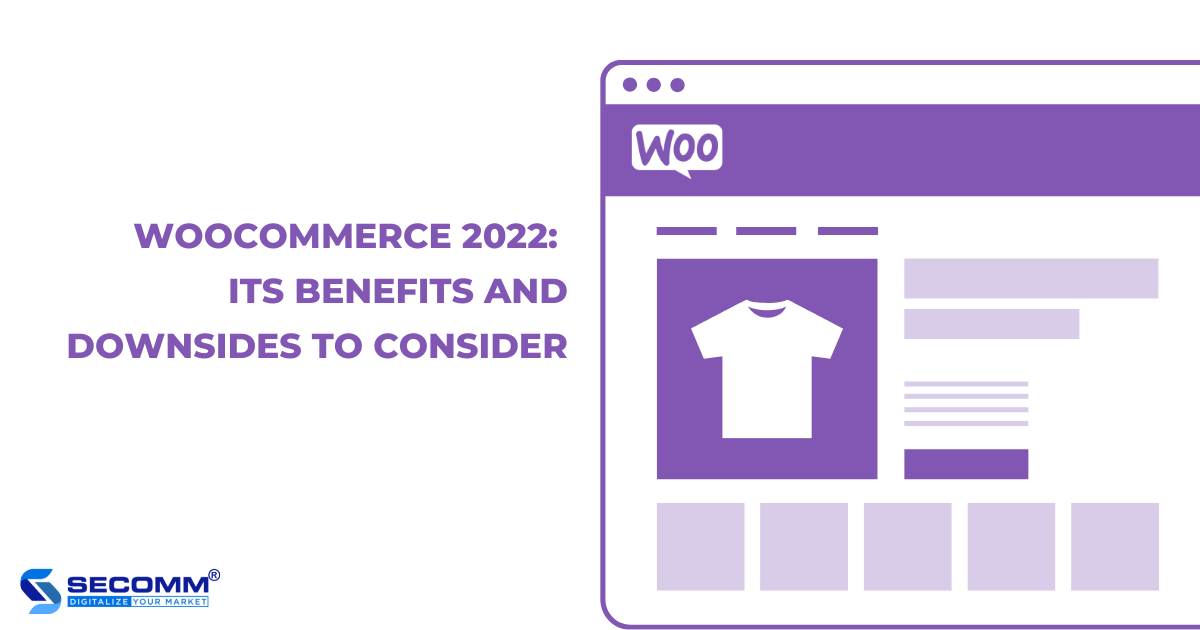
As eCommerce becomes a new trend that encourages a slew of brands to enter the market, selecting the right eCommerce platform to build a successful eCommerce website becomes critical. While Shopify is the most popular SaaS platform, Magento is the top choice in the open-source platform, and the WooCommerce plugin has won the trust of many brands due to its outstanding features and ease of use.
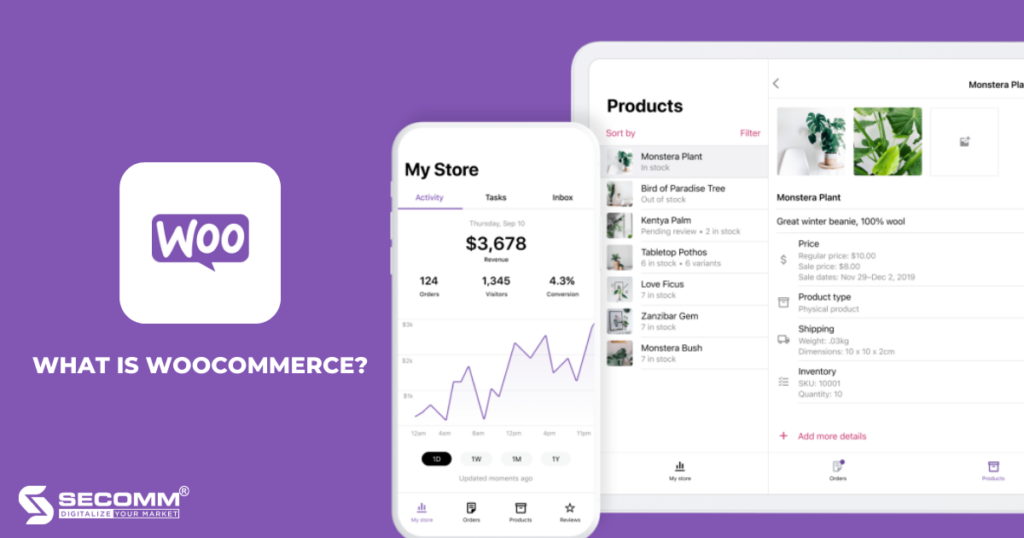
WooCommerce is a free WordPress plugin that allows brands to set up an eCommerce website by adding eCommerce functionality to an existing WordPress site. This plugin can transform a regular WordPress website into an eCommerce website with all the necessary features and easy customization with just a few clicks.
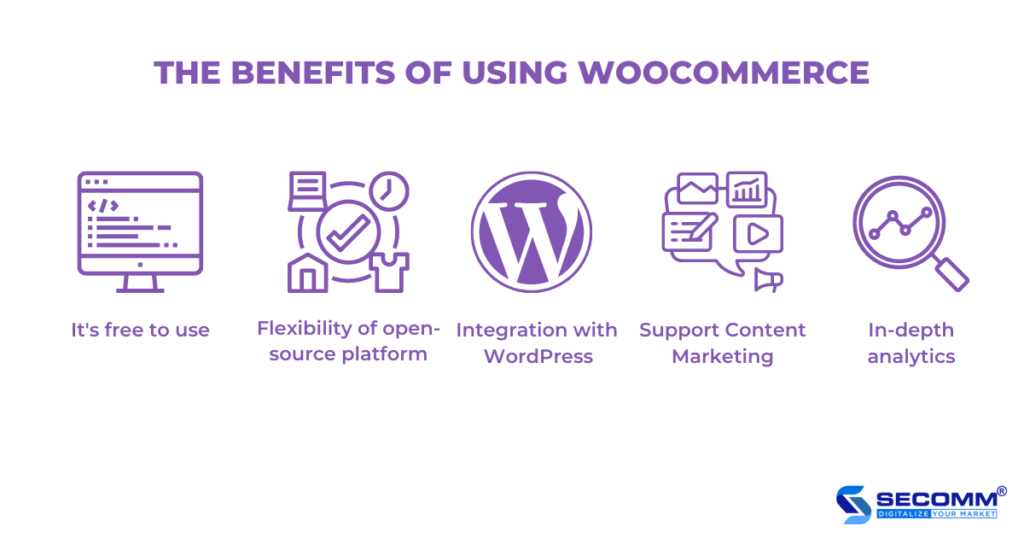
Price is an essential factor to think about when selecting a platform for implementing eCommerce. Popular platforms on the market today have prices ranging from free to several thousand dollars per year, making it even more prominent and preferred by businesses because this plugin is entirely free to download and install.
As a result, any business can benefit from its features without committing to costly support contracts or software licenses.
It is an open-source plugin built on the WordPress CMS that gives users complete control and allows them to easily customize their eCommerce website to their specific needs. WooCommerce, in addition to being suitable for a variety of businesses serving different customer segments, also provides long-term scalability, giving businesses of all sizes more flexibility in deploying eCommerce.
The seamless integration between WooCommerce and WordPress brings many benefits to this plugin because of the availability of the large WordPress community throughout the years. WooCommerce can take advantage of the platform’s massive ecosystem of plugins, themes, guides, and other unique features.
Yoast SEO, for example, has long been a well-liked plugin with numerous international translations, ease of use, and advanced SEO support. Since WooCommerce integrates with WordPress, Yoast SEO also integrates with WooCommerce.
Especially when a business has a website on the WordPress platform and needs to turn it into an eCommerce website, WooCommerce will make it easy and seamless, so users do not have to start over with a brand new platform.
Content Marketing is the key to an effective eCommerce website. If businesses are looking for an eCommerce platform built on the world’s most popular content management system (CMS), WooCommerce can fulfill that expectation.
When the WooCommerce plugin is integrated into WordPress, many content management options, including Blogs, Landing Pages, Product Descriptions, Email Marketing, and SEO plugins (Yoast WooCommerce SEO), will help sellers optimize content for search.
Integrated analytics is another advantage of the plugin because the more you learn about customers and how they interact with your eCommerce website, the more you can adjust to meet customer expectations. For example, businesses can use sales data to learn about customers, thereby establishing a customer persona to increase sales in the future.
Furthermore, it provides a comprehensive WooCommerce analyzer displayed in a clean and user-friendly interface. Businesses can then easily integrate WooCommerce with third-party analytics services such as Google Analytics, Google Tag Manager, and others.

When using this plugin, the user is responsible for keeping the eCommerce website up-to-date, accessible, and functional. In fact, there is some support from the hosting company and the WooCommerce community, but it does not allow users to simply call for technical assistance.
Plugins will notify users of security updates, but users must install and handle problems themselves. In fact, hosting companies will support this. Still, users need to have a bit of technical knowledge to facilitate the process of supporting related issues to avoid affecting the performance of the eCommerce website.
This disadvantage stems directly from the fact that businesses have complete control over the eCommerce website system’s source code and data. Maximum authority entails maximum accountability. Although businesses continue to receive support for WooCommerce issues, compared to other eCommerce platforms such as Shopify, BigCommerce, Magento, etc., WooCommerce still has many shortcomings in the technical maintenance support process.
With the constant increase in unauthorized access (Website Hacking), website speed and security are more critical than ever. Speed and security are significant advantages for SaaS platforms such as Shopify and BigCommerce. At that point, your eCommerce website is housed in the infrastructure of these platforms, and a team of technical experts will continuously monitor and resolve any issues that arise to keep the website running smoothly.
Similar to a technical maintenance situation, WooCommerce essentially leaves the user responsible for the speed and security of the website despite the wide range of 3rd party support options.
Although speed and security are not an issue for some new businesses deploying eCommerce websites, this is still a significant drawback of this plugin when businesses are responsible for many issues ranging from technical maintenance to website speed and security, especially if the eCommerce site is on the verge of rapidly growing from hundreds to thousands of hits.
Because it is a WordPress plugin, it will operate in accordance with WordPress functions. Meanwhile, WordPress functionality is not explicitly designed for eCommerce but rather is based on the flexibility of open-source code. This means that when a user exceeds a certain query threshold, the way WooCommerce works is broken.
For example, when a large number of shopping carts are added, or checkout occurs at the same time, or when too many users visit the website simultaneously, overload occurs, making the operation of the eCommerce website difficult. This is difficult because the WordPress system and the WooCommerce plugin are no longer compatible.
If your eCommerce website is still small and growing, this is not a problem; problems can still be quickly resolved. However, as the size of your website expands and grows rapidly, this is a disadvantage in terms of both performance and cost that businesses must consider before proceeding.
In a nutshell, WooCommerce is a fantastic plugin that many businesses would love to choose when deploying an eCommerce website. However, besides the outstanding advantages, there are still certain downsides, so businesses must carefully consider and compare with other platforms before starting out.
With many years of experience implementing eCommerce in many countries, SECOMM provides free consulting services with professional eCommerce solutions.
Contact us today for free support and advice!
 2
2
 5,471
5,471
 1
1
 1
1Subscribe to get the latest eBook!
Hotline